Milford Haven is reputedly the finest natural deep-water harbour in the country. The town of Milford Haven is still a busy fishing port, and is an important centre for oil and gas processing. The men of Milford who fell during both World Wars are commemorated on the Milford Haven War Memorial, which is located at Hamilton Terrace. Due to the sheer number of men from Milford who fell during both wars, I have split the details onto two pages, for WW1 and WW2. As well as the men named on the memorial, I have added men who were born, or resided at Milford, but are not commemorated there.
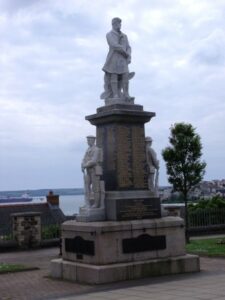
The Great War, 1914-1918
Thomas Anderson, Engineman, 380ES, Royal Naval Reserve. Thomas was born on 20 September 1880, the son of James and Mary Anderson, of Aberdeen. For many years prior to the war he had lived with his wife Annie Anderson, at 21, Murry Road, Pill, Milford Haven. Thomas served as Engineman aboard HM Trawler Loch Eye, and drowned when she struck a mine near Dunmore, off the coast of Ireland on 20 April 1917. Thomas was 36 years old, and is commemorated on the Plymouth Naval Memorial, Devon.
John Edwin Anthony, Trimmer, 546TS, Royal Naval Reserve. John was born on 24 November 1890, the son of John and Elizabeth Anthony, of Hubberston, Milford Haven. He married Beatrice Maud Battensby in 1913, and the couple resided at Hubberston Green. He served as Trimmer aboard HM Trawler Drumtochty, which was used to patrol the English Channel. John was killed on active service on 5 March 1916, aged 28, and is buried at Dunkirk Town Cemetery. Drumtochty sank later in the war when she struck a mine in the Channel on 29 January 1918, with the loss of eleven of her crew of thirteen.
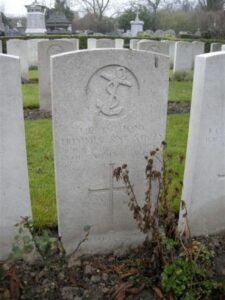
Joseph Houghton Ashton, Engineman, 147TS, Royal Naval Reserve. Joseph was born on 28 July 1885, the son of William and Elizabeth Ashton, of Liverpool. During the war he lived with his wife Ellen Ashton, at 3, Brick Houses, Pill, Milford Haven. He served as Engineman aboard HM Trawler Carew Castle, and was killed when she struck a mine off Hartland Point on 12 June 1917. Joseph was 31 years old, and is commemorated on the Plymouth Naval Memorial, Devon.
Ernest Axford, Trimmer, 302TS, Royal Naval Reserve. Ernest was born on 16 July 1896, and was the Grandson of William Axford, of Milford. His mother died when he was young, and Ernest was adopted by Simon and Elizabeth Davies, of 15, Perrott’s Terrace, Barn Street, Haverfordwest. He served with the Royal Naval Reserve, aboard HM Trawler “Kirkland”. She was requisitioned during August 1914, for service as a mine sweeper. Ernest was drowned when the Kirkland struck a mine off Fugla Skerry, Papastour, Shetlands, on 20 August 1917. He was 21 years old, and is remembered on the Plymouth Naval Memorial, Devon. Many thanks to Shirley Thomas for the photograph.
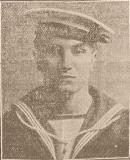
Charles Ernest Badrick, Sergeant, 50140, Royal Engineers. Charles was born in 1882, the son of Joseph and Rebecca Badrick, of 7, Green Terrace, Hubberston, Milford Haven. He enlisted at Milford into the Royal Engineers, and was posted to their 98th Field Company, which was on the Western Front, attached to the 21st Division. The Division crossed to France between 2 and 13 September 1915, and its first experience of battle was truly appalling. Having been in France for only a few days, lengthy forced marches brought it into the reserve for the British assault at Loos. GHQ planning left it too far behind to be a useful reinforcement on the first day, but it was sent into action on 26 September, whereupon it suffered over 3,800 casualties for very little gain. The Division remained in the area north of Loos over the coming winter, and it was here that Charles was killed in action on 1 December 1915, aged 33. Charles is buried at Chappelle-D’Armentieres New Military Cemetery, France.
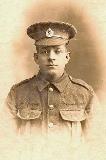
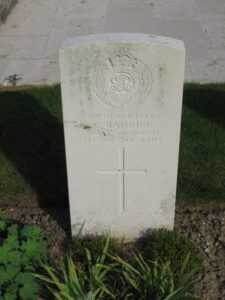
Harold Picton Bamkin, Second Lieutenant, Suffolk Regiment. Harold was born on 10 November 1895, the Son of Ernest Picton Bamkin and Lilian Margaret Bamkin, of Thornton Hall, Milford Haven. He was educated at Dulwich College, and had entered Jesus College, Oxford prior to the outbreak of war, but instead joined the Inns of Court Officer Training Corps, before gaining a commission into the 7th Battalion, Suffolk Regiment in September 1914. The battalion became attached to 35 Brigade, 12th (Eastern) Division, which landed at Boulogne on 31 May 1915, and took over the line at Ploegsteert Wood. They remained here over the coming months, and it was while here, on 19 July 1915, that Harold was killed whilst attempting to rescue one of his men from No Man’s Land. Harold was 20 years old, and is buried at Calvaire (Essex) Military Cemetery, near Ploegsteert, Belgium. Harold is not commemorated at Milford, but at Steynton.
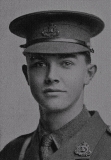
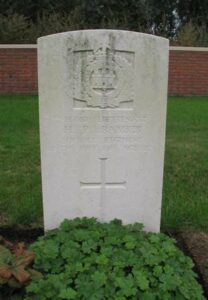
Joseph William Banner, DCM, Private, 9954, Worcestershire Regiment. Joseph was born at Milford Haven in 1886, the son of James and Elizabeth Banner. He was the husband of the late Maria Maud Banner of Chatham, Kent. Joseph was a pre-war regular in the army, serving with the 2nd Battalion, Worcestershire Regiment. At the outbreak of war, the battalion moved to France as part of 5 Brigade, 2nd Division, and took part in the Battle of Mons, and the subsequent retreat to the Marne, where the German drive on Paris was stopped. The Division then moved to Ypres, where the Worcesters gained fame for their part in the Battle of Gheluveld, when the German attack towards the Channel ports was stopped. Joseph was awarded the Distinguished Conduct Medal for his part in this action. He was later wounded, and died of his wounds on 16 November 1914, aged 28. Joseph is buried at Railway Chateau Cemetery, Belgium. Joseph is not commemorated on the Milford Haven memorial.
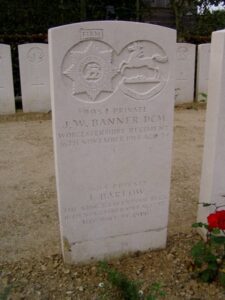
Albert Baxter, Trimmer, 5894TS, Royal Naval Reserve. Albert was born at Dewsbury, Yorkshire on 27 June 1878, and was the husband of Effie Baxter, of 2, Don Street, Woodside, Aberdeen. He served as Trimmer aboard HM Trawler Loch Eye, which was based at Milford. Albert was killed when she sank after striking a mine off Dunmore, Southern Ireland, on 20 April 1917. He was 38 years old, and is commemorated on the Portsmouth Naval Memorial, Hampshire.
Edwin Berry, Private, 291979, Northumberland Fusiliers. Edwin was born at Steynton in 1883, the son of Alfred Jabez Berry and Anne Berry (nee Lloyd). He married Edith Maud Allen at Pontypridd in February 1914, and at the outbreak of war enlisted at Cardiff into the army. Edwin was posted to the 1/7th Battalion, Northumberland Fusiliers, which was attached to 149 Brigade, 50th (Northumbrian) Division. The Division moved to France 16 April 1915, and served with distinction on the Western Front throughout the war, moving to Ypres, where they took part in the Second Battle of Ypres from April to June 1915. During the summer of 1916 the Division were on the Somme, where they fought at the Battle of Flers-Courcelette, the Battle of Morval and the Battle of Le Transloy. After spending a winter on the Somme, they moved north to Arras, where they took part in the Arras Offensive of April 1917, and fought at the First Battle of the Scarpe, capturing the Wancourt Ridge. They then fought at the Second Battle of the Scarpe, and it was during this action that Edwin was killed on 26 July 1917, aged 33. He is buried at Guemappe British Cemetery, Wancourt, France. Edwin is not commemorated locally.
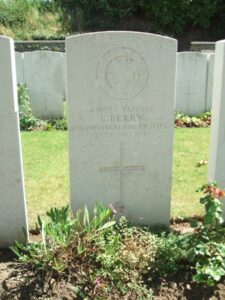
William Walter Berryman, MID, Deck Hand, 208DA, Royal Naval Reserve. William was born at London on 1 April 1886, the son of William James Berryman and Eliza Jemima Berryman. Prior to the war he resided with his wife, Ellen Holtby Berryman, at 122, Robert Street, Milford Haven. William served as Deck Hand aboard HM Trawler Apley, and had been Mentioned in Despatches during his time at war. He was killed on 6 December 1917 when Apley struck a mine off the Isle of Wight. William was 32 years old, and is commemorated on the Plymouth Naval Memorial, Devon.
Thomas Frederick Bevans, Private, 48852, Lancashire Fusiliers. Thomas was the son of John and Mary Ann Bevans, of 15, Albion Street, Milford Haven. He had enlisted at Carmarthen into the army, and was posted to the 1st Battalion, Lancashire Fusiliers, part of 86 Brigade, 29th Division. The Division moved to Gallipoli via Egypt, landing on 25 April, 1915. They remained here until evacuation to Egypt on 11 January, 1916 and then moved to the Western Front on 15 March 1915. The Division took part in its first major action in France during the 1916 Somme Offensive, and fought at the Battles of Albert and Le Transloy, suffering heavy casualties. In the Spring of 1917 they fought at the Battle of the Scarpe, which was part of the Arras Offensive, and then moved further north to Ypres. Here they fought at the Battle of Langemarck, and then at the Battles of the Menin Road, Polygon Wood, Broodseinde and Poelcappelle, before moving to Cambrai. Here they fought at the Battle of Cambrai in November and December, 1917 before moving back to Flanders early in 1918. The German Spring Offensive hit the British on the Somme on 21 March, 1918, and hit in Flanders just weeks later. The 29th Division fought at the desperate defensive battles of Hazebrouck, which is where Thomas was killed in action on 12 April 1918. He was just 20 years old, and is commemorated on the Ploegsteert Memorial, Belgium.
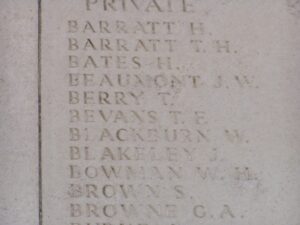
Alexander Blackhall, Engineman, 2044ES, Royal Naval Reserve. Alexander was born on 1 November 1890, the son of William and Christina Blackhall, of 156, High Street, Gardenstown, Banff. He served as Engineman aboard HM Drifter Speedwell V. On Saturday 28 October 1916, Speedwell was caught in a heavy storm, and trying to reach Rosslare Pier for shelter, when she was driven ashore on Splaugh Rock, off Greenore Point, and broke up with the loss of all her crew. He was 26 years old, and is commemorated on the Portsmouth Naval Memorial, Hampshire. His brother George also drowned in the sinking.
George Blackhall, Deck Hand, 3985DA, Royal Naval Reserve. George was born on 9 September 1895, the son of William and Christina Blackhall, of 156, High Street, Gardenstown, Banff. He served with his brother Alexander aboard HM Drifter Speedwell V, and was drowned when she sank on 28 October 1916. George was 20 years old, and is commemorated on the Portsmouth Naval Memorial, Hampshire. His brother Alexander also died in the sinking.
John Harold Bowen, Sergeant, 7682155, Military Foot Police. John was born in 1881, the son of Thomas and Charlotte Bowen, of 5, Starbuck Road, Milford Haven. He married Rosina Hughes at Milford in December 1908, and the couple lived at 15, Starbuck Road, Milford Haven. John had served with the Rifle Brigade during the war, and at some stage transferred to the Military Foot Police, being posted to Palestine. John remained there after the war, and died of malaria and appendicitis on 29 September 1920, aged 39. John is buried in Haifa War Cemetery, Israel.
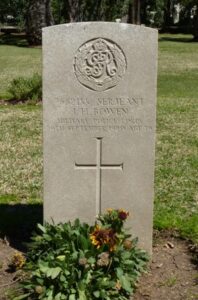
Stanley Thomas Bowen, Sergeant, 11, Welsh Regiment. Stanley was the only son of Alfred and Hannah Bowen, of Prendergast, Haverfordwest, and was the husband of Gertrude Clarke. He enlisted at Haverfordwest into the 4th Welsh prior to the outbreak of war, and by the outbreak had been promoted Serjeant. The battalion formed part of the Territorial Force, and was reformed for war in August 1914, becoming attached to 259 Brigade, 53rd (Welsh) Division. The Division moved to the Mediterranean, sailing from Devonport in July, 1915 arriving at Mudros by 5 August 1915. From here they moved to Gallipoli, landing on 9 August. Here the division was immediately thrown into action, and spent the next few days in isolated pockets, fighting against a Turkish counter-attack during the Battle of Sari Bair, and then at the Attack on Scimitar Hill. Stanley was one of several hundred casualties within the 4th Welsh during these first few days on Gallipoli. He was killed in action on 10 August 1915 aged 29, and is commemorated on the Helles Memorial. His widow later remarried, and became Gertrude M. McNeill, of Erindale, Ontario, Canada.
William John Bowtle, Stoker 1st Class, K/15916, Royal Navy. William was born at Woodford, Essex on 10 October 1893, and served aboard HMS P.60. She was a ‘Q-Ship’ which operated out of Chatham. William was one of two of her crew to be killed on 4 January 1918, probably during an exchange of fire with a German craft in the English Channel. His death was registered at Milford. William was 24 years old, and is buried at Tillingham (St. Nicholas) Churchyard. His wife Margaret Bowtle (nee Buchanan), resided at 163 East Main Road, Armadale Scotland.
William Henry Broome, Engineman, 83ES, Royal Naval Reserve. William was born on 20 November 1885, the son of Mary Elizabeth Broome. He married in 1908, and lived with his wife Annie Jane Broome, at 219, Robert Street, Milford Haven. William was brought up by his grandparents under his mother’s maiden name of Thomas, because she was in service, so he served with the Royal Naval Reserve as William Thomas, as an Engineman aboard HM Trawler Carlton. William was killed on 21 February 1916 when Carlton struck a mine off Folkestone. He was 29 years old, and is commemorated on the Plymouth Naval Memorial, Devon.
John Brown, Private, 34740, Royal Warwickshire Regiment. John was born at Haverfordwest. He resided at 13, Gracechurch Terrace, Milford prior to the war, and enlisted there into the army. He was first posted to the Cheshire Regiment, with the service number 306051, before being posted to the 1/6th Battalion, Royal Warwickshire Regiment. The battalion was part of 143 Brigade, 48th Division, and in November 1917 sailed for Italy, where it remained for the duration of the war, taking part in actions on the Asiago Plateau- the Battle of Asiago and the Advance from Asiago, with the infantry of 143 Brigade becoming the first British soldiers to enter the home territory of the Central Powers. John died after the Armistice, on 20 November 1918. He is buried at Montecchio Precalcino Communal Cemetery Extension, Italy.
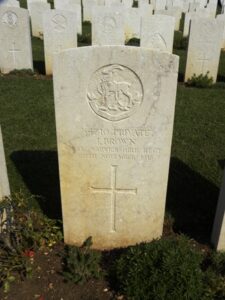
George Henry Harris Brownhill, Private, 18694, Duke of Edinburgh’s Wiltshire Regiment. George was the son of George Henry and Maria Brownhill, of 8, Brick House, Pill, Milford Haven. He enlisted at Milford into the Welsh Regiment, but was then posted to the 5th Battalion, Wiltshire Regiment, which formed part of 40 Brigade, 13th (Western) Division. The Division had fought at Gallipoli, and remained there until being evacuated in January 1915, from where it moved to Egypt, where it was posted to the Suez Canal defences. In 1916 the Division moved to Mesopotamia, and took part in a long and terrible struggle against the Turks for the remainder of the war. George died here on 28 August 1918, aged 23, and is buried at Baghdad (North Gate) War Cemetery.
Sydney Doggett Bryant, Deck Hand, 10534DA, Royal Naval Reserve. Sydney was born in Cardiff on 20 May 1894, the son of Thomas and Elizabeth Bryant, of 21, Margaret Street, Bute Docks, and was educated at St. Monica Council School, Cathays. He worked at Sessions & Co. prior to the war. Sydney married Elizabeth Mary Cottiers, and she gave birth to their son Sydney Thomas Bryant on 22 March 1915. The young family lived at 247, Left Mynachdy Road, Mynachdy, Cardiff. Sydney enlisted on 15 November 1915 into the Royal Navy, and served as Deck Hand aboard HMS Prize. Sydney was killed when she was sunk during a battle with the German submarine U-48 on 14 August 1917. Sydney was 23 years old, and is commemorated on the Plymouth Naval Memorial, Devon.
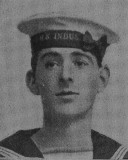
Alexander Buchan, Engineman, 3439ES, Royal Naval Reserve. Alexander was born near Aberdeen on 21 September 1859. He was a long serving fisherman, and lived with his wife Mary Roger Buchan, at 20, Park Place, Aberdeen. Alexander was posted to Milford, and served as Engineman aboard HM Drifter Ladysmith. Alexander drowned when Ladysmith was lost in a gale of the West Wales coast on 27 December 1915. He was 63 years old, and is commemorated on the Portsmouth Naval Memorial, Hampshire.
James Walter Buck, Deck Hand, DA/15469, Royal Naval Reserve. James was born at Caister, Norfolk on 22 February 1878, the son of George Walter Buck and Mary Buck. He married Gladys Ethel Mingay in 1916 and the couple resided at 10, Warwick Road, Milford Haven. James was serving aboard HM Drifter Petrel, which was involved in anti-submarine patrol duties. James died of influenza on 10 March 1919, aged 38, leaving two young sons. He is buried at Milford Haven Cemetery.
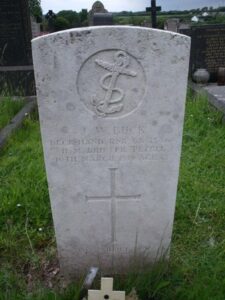
Frederick William Burford, Able Seaman, 100302, Mercantile Marine Reserve. Frederick was born in 1895, probably the son of John and Louisa Burford. He served with the Mercantile Marine during the Great War, and resided with his wife Eva Burford, at 15, Marble Hall Terrace, Milford Haven. After the war, Frederick volunteered to serve in Operation Archangel, an operation to aid the White Russians to defend their country against the communist uprising. Frederick served aboard H.M.S. Walton Belle, a Paddle Minesweeper. In May 1919, Walton Belle set sail for the long voyage to Russia, taking her through the Norwegian Fjords, and into the Arctic Ocean. She reached Murmansk on 5 June 1919, carrying out routine work before heading to Archangel on 20 June 1919. She was in action at Onega on 1 August 1919, and Frederick was probably wounded there, dying on 3 August 1919, aged 24. Frederick is buried at Archangel Allied Cemetery, Russia.
James Peter Burns, Deck Hand, 3706SD, Royal Naval Reserve. James was born on 27 July 1895, the son of Bernard and Martha Burns, of Barrow-in-Furness. He served aboard HM Drifter Speedwell V. On Saturday 28 October 1916, Speedwell was caught in a heavy storm, and trying to reach Rosslare Pier for shelter, when she was driven ashore on Splaugh Rock, off Greenore Point, and broke up with the loss of all her crew. James was 21 years old when he died that day, and is commemorated on the Plymouth Naval Memorial, Devon.
John Charles Burr, Private, 54031, Welsh Regiment. John was born in Hull in 1885, the son of John and Annie Burr. By 1901 the family was residing at 30, Dartmouth Street, Milford Haven, where John’s father ran his own business as a Fish Merchant. John enlisted into the Army at Milford, and was posted to the 14th Battalion, Welsh Regiment as a reinforcement. The battalion was known as the Swansea Pals battalion, and was in France as part of 114 Brigade, 38th (Welsh) Division. John would have joined the battalion after the fighting at Mametz Wood, and moved with the battalion to new positions north of Ypres, near Boesinghe, in August 1916. Here the Welsh Division took over the line running along the Canal Bank, and were to remain here for the coming twelve months leading up to the Battle of Passchendaele. John though was killed in action while the Swansea Pals were in the line on 1 November 1916, aged 31. He was buried at Essex Farm Cemetery, Belgium.
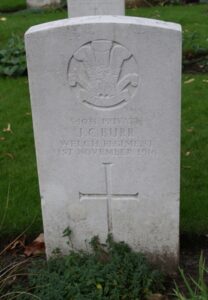
Richard Eldon Bush, Flight Lieutenant, Royal Naval Air Service. Richard was born on 16 June 1891, the son of Philip Wathen Bush and Maria Louisa Bush, of The Old Manor House, Keynsham Bristol. Richard learnt to fly the Caudron Biplane, at the Royal Naval Flying School, Eastchurch, gaining his Aviators Certificate on 20 August 1915. He was one of the first airmen to be based at Fishguard Naval Air Station RNAS, and on his first flight there took off in a Sopwith Baby seaplane, N1033, on the morning of 22 April 1917 on a test flight, carrying a full load of bombs, but sadly the seaplane failed to gain height at take off and struck power cables, which sent it crashing into the cliff face. At great risk to himself, a soldier of the King’s Liverpool Regiment who had been watching, pulled Richard out of the burning wreckage, and he was taken to the nearby Bay Hotel, where he was treated by a local Doctor. Sadly, Richard succumbed to his terrible injuries, and died on 24 April 1917. He was 26 years old, and was buried with full military honours at Keynsham Cemetery, England.
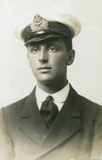
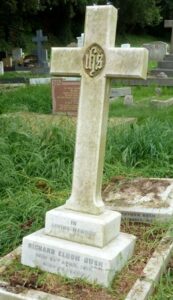
William Bussby, Private, 399, Welsh Regiment. William was born at Chorley, Lancashire on 24 July 1895, the son of James and Bessie Ann Bussby. By 1911 the family had taken over the Commercial Hotel, Milford Haven. William worked at the Hotel before enlisting at Haverfordwest into the 1/4th Battalion, Welsh Regiment, which was the local Territorial Battalion, attached to 159 Brigade, 53rd (Welsh) Division. The Division landed at Cape Helles, Gallipoli, on 9 August 1915, and was immediately thrown into action, spending the next few days in isolated pockets, fighting against a Turkish counter-attack during the Battle of Sari Bair, and then at the Attack on Scimitar Hill. William was killed in action here on 10 August 1915, aged 21. He is commemorated on the Helles Memorial, Gallipoli. William is not commemorated at Milford.
Walter Henry Byard, Deck Hand, 2909DA, Royal Naval Reserve. Walter was born at Gloucester on 27 June 1884. During the war he lived with his wife Alice Byard, at Priory Village, Milford Haven. Walter served as Deck Hand aboard HM Trawler Lobelia II, and was killed when she struck a mine and sank off Lough Swilly on 19 April 1917. Walter was 32 years old, and is commemorated on the Plymouth Naval Memorial, Devon.
John Herbert Byford, Leading Stoker, K/19069, Royal Navy. John was born at Sheffield on 22 December 1889. He was a long serving Royal Naval rating, and resided at Milford prior to the war, with his wife Alice M. Byford (nee Paton), of Beach Road, Pill, Milford Haven. John served aboard the pre-dreadnought Battleship HMS Goliath. Goliath had been built for service in the Pacific, and was obsolete by the outbreak of the Great War. Nevertheless, her powerful firepower made her of use to the ground forces which were landed on Gallipoli from 25 April 1915 onwards, and Goliath spent the last few months of her life in action here, before being sunk by the Turkish torpedo boat Muavanet on 13 May 1915. John was drowned when Goliath sunk that day. He was 26 years old, and is commemorated on the Chatham Naval Memorial, Kent.
David John Carpenter, Deck Hand, 2766DA, Royal Naval Reserve. David was born on 2 March 1899, the son of Henry and Mary Carpenter, of 5, Hill Street, Hakin. He enlisted at Milford in August 1914 into the 9th Battalion, Welsh Regiment, but within months had been found to be under-age and discharged for misconduct, having lied on his attestation form. David then enlisted into the Royal Naval Reserve, and served as Deck Hand aboard the ‘Q-Ship’ HMS Prize. He was killed when Prize was sunk during an action against the German submarine U-48 in the Atlantic on 15 August 1917. He was just 18 years old, and is commemorated on the Plymouth Naval Memorial, Devon.
Percy Edmund Carpenter, Gunner, 79298, Royal Garrison Artillery. Percy was the son of Mr. and Mrs. Carpenter, of Great Yarmouth. He married Henrietta Louise Spencer on 5 November 1900, and the couple resided at 5, The Grove, Chapel Field, Norwich. Percy enlisted into the Royal Garrison Artillery on 3 May 1916, and spent the following six months on home service, probably at Milford. Percy was posted to France on 13 August 1916, and joined the 6th Siege Battery, Royal Garrison Artillery. Percy probably served on the Somme in 1916, and was killed during the Battle of Messines on 20 June 1917, aged 36. Percy is buried at La Plus Douve Farm Cemetery, Belgium.
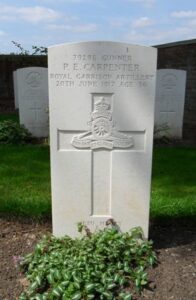
James Carter, Private, 12522, Cheshire Regiment. James was born at Lambeth in 1875, but prior to the war had resided for over two years with Mrs Bebb, at 14, Point Lane, Hakin, Milford Haven, where he worked as a seaman. James was an army reservist after having spent over eight years with the Royal Fusiliers, and re-enlisted at Pembroke on 12 March 1915 into the Cheshire Regiment. He was posted to France on 18 May 1915, joining the 2nd Battalion, Cheshire Regiment, which was attached to 84 Brigade, 28th Division. James joined the battalion on the Belgian frontier, and was mortally wounded within days of arriving at the front. He died on 26 May 1915, aged 40, and is buried in Hazebrouck Communal Cemetery, France. James had no family, and is not commemorated locally. (There are two men commemorated on his headstone. James is at the bottom).
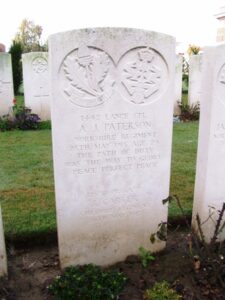
Thomas Wilfred Chope, Chief Petty Officer, 172371, Royal Navy. Thomas was born at Portsmouth on 4 October 1877, the son of Thomas and Mary Ann Chope. Mary was from Milford Haven. Thomas married Daisy Beatrice Calloway, of 53, Whitecliffe Avenue, Copnor, Portsmouth prior to the war. He served as Chief Petty Officer aboard HMS Bulwark, which was a pre-dreadnaught Battleship of the Formidable Class. On the morning of 26 November 1914, Bulwark was anchored safely in the estuary at Medway, when a terrific explosion ripped her apart, and she sank with the loss of 740 lives. A Naval Court of Enquiry found that the explosion was probably caused by an overheating cordite charge, stored near one of the boiler room bulkheads. Thomas was 37 years old when he died that day, and is commemorated on the Portsmouth Naval Memorial, Hampshire.
John Charles Chudley, DSM and Bar, Chief Steward 2nd Class, L/1943, Royal Navy. John was born on 2 June 1891, and was the husband of Florence Ellen Chudley, of North East Street, Northam, Devon. John was another of the brave men serving aboard the ‘Q-Ship’ HMS Prize, and during his time on the ship, had gained the honour of being awarded the Distinguished Service Medal twice, first in the London Gazette of 22 June 1917, and the second on 14 September 1917. Sadly, he was killed in action when Prize was sunk by the German submarine U-48 in the Atlantic on 14 August 1917. He was 25 years old, and is commemorated on the Plymouth Naval Memorial, Devon.
Charles Clarke, Second Hand, 206SA, Royal Naval Reserve. Charles was born on 16 March 1893, the son of John Thomas Clarke and Elizabeth Clarke, of 20, Dartmouth Street, Milford. He served as Second Hand aboard H.M. Trawler Corientes. Corientes had been requisitioned by the Admiralty in 1915, and was fitted with a 6-pounder gun before entering service as a minesweeper. On 23 June 1917, she was patrolling off Malin Head, Ireland, when she struck a mine, and sank with all hands. Charles was one of the men lost aboard her, and he is commemorated on the Plymouth Naval Memorial, Devon. His widow, Lizzie Ann Clarke, was residing at McKinley (Grocer), Main Street, Buncrana, Ireland.
Edwin Mark Clarke, Deck Hand, SD/82, Royal Naval Reserve. Edwin was born on 5 May 1896, the son of Ethel Clarke, of 81, Goldstone Villas, Hove, Sussex. He resided at Milford prior to the war, with his wife Gladys Gertrude Clarke, at 35 Starbuck Street, Milford Haven. Edwin served aboard HMS Q22, which was another of the Q-Ships to sail from Milford during the war. He died aboard Q22 when she was attacked and shelled by the German Submarine UC-47 on 22 April 1917. Edwin was brought back to Milford, and was buried with full military honours at Milford Haven Cemetery.
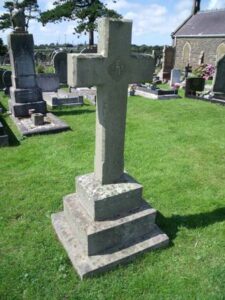
Frederick William Clarke, Sapper, 47409, Royal Engineers. Frederick was the son of James and Elizabeth Clarke, of 2, Robert Street, Milford Haven. He was one of three brothers who enlisted at Milford on 4 September 1914 into the Royal Engineers. Frederick and his brother Benjamin were posted to the 98th Field Company, which was attached to the 21st Division. Frederick embarked for France on 10 September 1915, and moved with the division to Loos, where it was sent into action on 26 September, suffering over 3,800 casualties for very little gain. The division moved to the Somme in 1916, and fought at the Battle of Albert and at the Battle of Bazentin. This is where Frederick was killed in action on 14 July 1916, with his brother Benjamin by his side. Frederick was 26 years old, and is commemorated on the Thiepval Memorial, France.
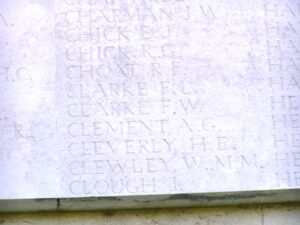
Howard Cleevely, Private, 14388, Welsh Regiment. Howard was the son of Frank and Clara Cleevely, of Milford Haven. He had enlisted at Milford into the Army, and joined the 9th Battalion, Welsh Regiment, which was attached to 58 Brigade, 19th (Western) Division. The Division assembled around Bulford during September 1914. Divisional training was completed near Tidworth, from March 1915, and the ‘Butterfly Division’ crossed to France between 11 and 21 July 1915, and moved to positions near Loos. The Division fought during the opening attack of the Battle of Loos, and then moved to the Somme, where they took part in the second wave of the attack on Ovillers-La Boiselle on 1 July, capturing the village at heavy cost, and fought through the Somme Battles of Pozieres and the Ancre in 1916. Howard was wounded at the Ancre, and evacuated to a Casualty Clearing Station for treatment, but sadly died of his wounds on 6 November 1916. He was 24 years old, and is buried at Warloy-Baillon Communal Cemetery Extension, France.
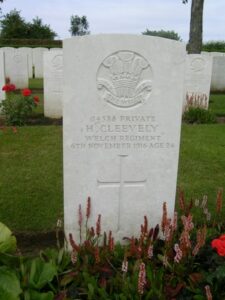
Charles Reginald Clemo, Shipwright 2nd Class, M/16543, Royal Navy. Charles was born on 16 August 1895, the son of Charles and Elizabeth H. T. Clemo, of Duke Street Inn, Duke Street, Devonport. Charles was killed when HMS Prize was sunk by U-48 in the Atlantic on 14 August 1917. He was 22 years old, and is commemorated on the Plymouth Naval Memorial, Devon.
E. Cole, Royal Naval Reserve. This man cannot presently be identified.
Albert George Coles, First Engineer, Mercantile Marine. Albert was born at Cardiff in 1879. He worked at Milford for several years prior to the war, and in 1904 married Agnes Maud Elliot, of 16, Trafalgar Road, Milford. Albert served aboard the Steam Trawler Victoria Fleetwood. He was killed when the trawler was sunk by gunfire from the German submarine U-34 on 1 June 1915. He was 36 years old, and is commemorated on the Tower Hill Memorial, London. Albert is not commemorated on the Milford Memorial, although he could be the man above, named as E Cole.
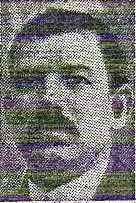
Thomas Collins, Deck Hand, 2877SD, Royal Naval Reserve. Thomas was born on 29 May 1894, the son of Peter and Delia Collins, of Fair Hill Road, Galway. He served as Deck Hand aboard HMS Prize, and was killed when she was sunk by U-48 on 14 August 1917. Thomas was 21 years old, and is commemorated on the Portsmouth Naval Memorial, Hampshire.
William Henry Collins, Private, 17255, Welsh Regiment. William was born at Milford Haven in 1896, the son of John and Lillian Collins. The family had moved to 10B, Caswell Street, Swansea prior to the war, and William enlisted there into the newly formed Swansea Pals Battalion, the 14th Battalion, Welsh Regiment. After training at Rhyl, the battalion moved to Winchester in the summer of 1915 as part of 114 Brigade, 38th (Welsh) Division. The Division landed in France in December 1915, and was initiated into trench warfare at Fleurbaix. In July 1916 the Division made its famous attack on Mametz Wood, and it was here, on 10 July 1916, that William was killed. He was 19 years old, and is commemorated on the Thiepval Memorial, France. William is not commemorated on the Milford Memorial.
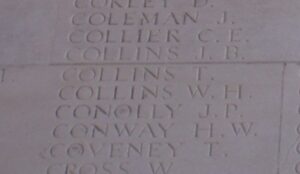
Timothy Connor, Leading Seaman, D/1868, Royal Naval Reserve. Timothy was born at Kinsale, County Cork on 23 December 1875. He was the husband of Bridget Connor, of 26, Howe Street, Bootle, Liverpool. Timothy served aboard HM Trawler Evangel, and he drowned when Evangel struck a German mine off St. Anne’s Head on 25 March 1917. He was 42 years old, and is buried at Milford Haven Cemetery.
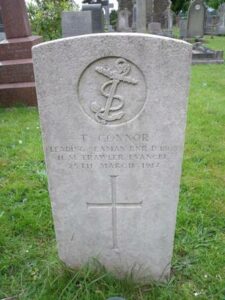
Albert Costello, Private, 27173, Welsh Regiment. Albert was the son of John and Elizabeth Ann Costello (nee Lord), of Manchester. He resided at Milford prior to the war, and enlisted at Fleetwood, Lancashire into the Lancaster Regiment. Albert was then transferred to the 8th Battalion, Welsh Regiment, which was attached to 40 Brigade, 13th (Western) Division. On 13 June 1915 the Division sailed for Alexandria, and moved to Mudros before being landed at Cape Helles, Gallipoli from 6 July 1915, relieving the 29th Division. They left and returned to Mudros at the end of the month, and the entire Division landed at ANZAC Cove between 3 and 5 August, 1915, taking part in the Battles of Sari Bair, Russell’s Top, and Hill 60, ANZAC. Albert was killed at Gallipoli on 8 August 1915, aged just 19. He is commemorated on the Helles Memorial, Gallipoli. Albert is not commemorated at Milford.
Leopold Coulet, Deck Hand, 13SD, Royal Naval Reserve. Leopold was born on 1 January 1875 at Queenstown, Ireland. He served aboard HMS Q22, a Q-Ship, which was based at Milford. On 22 April 1917, Q22, which was armed with two 12-pounder guns, engaged a German submarine about fifty miles south of Kinsale Head. The submarine was thought to have been sunk, but in the engagement Leopold was killed. He was 42 years old, and is buried at Cobh Old Church Cemetery, Ireland. His sister was Mrs Caroline Dunn, of 93, Admiralty Street, Devonport.
Edwin Cox, Cooks Boy, Mercantile Marine. Edwin was born at Swansea, and was the son of Edwin and Florence Cox (nee Risk). The family moved to 12, Dartmouth Street, Milford Haven, where Edwin joined the Mercantile Marine as a Cooks Boy, aboard the London Registered SS Sandhurst. On 6 May 1918 Sandhurst was torpedoed by the German submarine UB72, and sank with the loss of all hands. Edwin was just 15 years old, and is commemorated on the Tower Hill Memorial, London.
Samuel Bradfield Cozens, Private, 145969, Machine Gun Corps. Samuel was born at Pembroke on 1 May 1899, the son of Thomas Charles Cozens and Eveline Cozens (nee White). The family later resided at the Post Office, Cosheston, Pembroke. Samuel was called up into the army late in 1917, and after training was posted to the 17th Battalion, Machine Gun Corps, attached to the 17th (Northern) Division. In March, 1918 the Division were on the Somme, and faced the German Spring Offensive there, fighting at the Battle of St Quentin, and retreated back, fighting at the First Battle of Bapaume. After a period out of the line to rest and rebuild, the Division moved to the southernmost sector of the Somme area, where they fought at the Battle of Amiens on 8 August 1918, a day which saw the war swing in the favour of the Allies. The Allies then advanced on the Somme, and the Division fought at the Battle of Albert later that month, which marked the beginning of the advance to victory. Samuel was killed during the first week of the great advance, on 28 August 1918. He was 20 years old, and is commemorated on the Vis-En-Artois Memorial, France. His brother, Hubert White Cozens, was awarded the Military Medal during the war. The photograph of Samuel is courtesy of Joy Cozens, his niece. Samuel is also commemorated on the Cosheston Memorial.
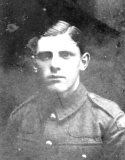
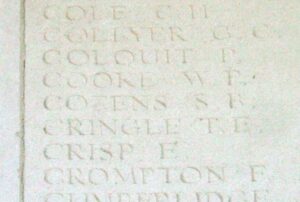
William Charles Crisp, Second Hand, 434DA, Royal Naval Reserve. William was born on 28 April 1885, the son of Samuel and Emma Crisp, of Halesworth, Suffolk. Prior to the war he was residing with his wife Fanny Winifred Crisp (nee Bevans), of 5, Prioryville, Milford Haven. He served aboard HM Trawler Lydian, and was killed when she was sunk by a mine explosion off South Foreland on 18 September 1915. William was 29 years old, and is commemorated on the Plymouth Naval Memorial, Devon.
William James Crumplin, Private, 15039, Dorsetshire Regiment. William was born at Milford Haven in 1891, the son of Thomas and Emma Crumplin. He resided at Weymouth, Dorset prior to the war, and enlisted there into the 5th Battalion, Dorsetshire Regiment, which was attached to 34 Brigade, 11th (Northern) Division. The Division first saw action during the Gallipoli campaign of 1915, and remained there until the evacuation on 21 December 1915, when they moved to Egypt. During July 1916 the Division landed at Marseilles, and then spent remainder of the war on the Western Front, fighting at the Battle of Flers-Courcelette. William was killed here on 26 September 1916, aged 25. He has no known grave, and is commemorated on the Thiepval Memorial, France. William is not commemorated on the Milford Haven Memorial.
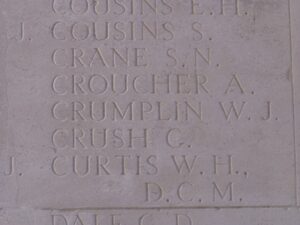
Joseph Curtis, Rifleman, 2524, Liverpool Regiment. Very little is known of Joseph, but he originally served with the 3/5th Battalion, King’s Liverpool Regiment on home service. He was later transferred to the 430th Company, Labour Corps. Joseph survived the war, but sadly died as a result of his war service on 3 January 1921, aged 50. He is buried at Bath (Locksbrook) Cemetery, England.
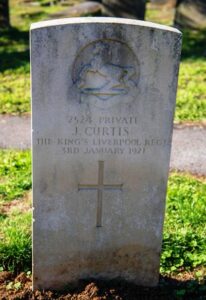
Alexander Davidson, Second Engineer, Mercantile Marine. Alexander was born at Milford Haven in 1860, the son of Alexander and Elizabeth Davidson. He had lived for many years with his wife Mary Davidson (nee Thomas), at 23, Brigstocke Terrace, Ferryside. Alexander served in the Mercantile Marine aboard the S.S. Boltonhall, which was a 3,535 ton defensively armoured steamship owned by the West Hartlepool Steam Navigation Company. On 20 August 1918 the ship was 34 miles off Bardsey Island when she was torpedoed and sunk by a German submarine. Five crewmembers died including the 57-year-old Alexander Davidson. He is remembered on the Tower Hill Memorial, alongside his fellow crewmen. Alexander is not commemorated on the Milford Haven Memorial.
Albert Davies, Trimmer, 6189TS, Royal Naval Reserve. Albert was born on 19 October 1876, the son of William and Mary Davies, of Hakin. He lived with his wife Esther Davies, at Lower Thornton, Milford Haven. Albert served aboard HM Trawler Evangel, and was killed when Evangel was sunk by a mine explosion in the English Channel on 25 March 1917. Albert was 39 years old, and is commemorated on the Plymouth Naval Memorial, Devon.
Edward James Davies, Private, 38356, Welsh Regiment. Edward was the son of George and Caroline Davies, of Hubberston. He enlisted at Milford into the Army, joining the 8th Battalion, Welsh Regiment. The battalion formed part of 40 Brigade, 13th (Western) Division, and between 6 and 16 July 1915 landed on Cape Helles and relieved the 29th Division. They left and returned to Mudros at the end of the month, and the entire Division landed at ANZAC Cove between 3 and 5 August, 1915, taking part in the Battles of Sari Bair, Russell’s Top, and Hill 60, ANZAC. Soon afterwards the Division was transferred from ANZAC to Suvla Bay, and it was evacuated from Suvla on 19 December 1915, whereupon the infantry moved after a week’s rest to the Helles bridgehead, where they faced the last Turkish attacks at Helles. On 8 January 1916, the Division was evacuated from Helles, and by 31 January was concentrated at Port Said, where they held forward posts in the Suez Canal defences. On 12 February, 1916 the Division began to move to Mesopotamia, to strengthen the force being assembled for the relief of the besieged garrison at Kut al Amara. Edward was killed during the opening of the move into Mesopotamia on 9 February 1917, aged 19. He is buried at Amara War Cemetery, Mesopotamia.
Frederick Davies, Private, 39740, Royal Welsh Fusiliers. Frederick was the son of George Lorne and Mary Davies, of 9, St. Peter’s Road, Milford Haven. He was a fireman with the GWR prior to the war, and enlisted at Milford into the Royal Welsh Fusiliers on 24 January 1916. On 9 July 1916 Frederick landed in France and was posted to the 2nd Battalion, Royal Welsh Fusiliers, which had been in France since the outbreak of war. By the time that Frederick joined the battalion, they had fought throughout the Battle of Loos and the opening of the Somme Battles, and had become attached to 19 Brigade, 33rd Division. Frederick then fought with the battalion at the Battle of the Menin Road and at Polygon Wood, during Third Ypres, and this is where he was killed on 30 November 1917, aged 22. He has no known grave, and is commemorated on the Tyne Cot Memorial, Belgium.
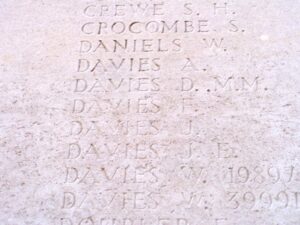
George Sidney Davies, Petty Officer Stoker, ES/1669, Royal Naval Reserve. George was born on 5 July 1889, the son of Thomas and Elizabeth Davies, of 29, Gwilia Road, Hakin, Milford Haven. He had served with the Mine Clearance Service aboard HM Trawler Peter Lovet during the war, and was killed on 20 April 1919, aged 30. George is buried at Milford Haven Cemetery.
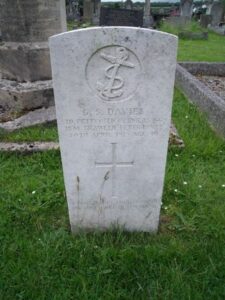
James Davies, Gunner, 141181, Royal Garrison Artillery. James was the son of Tom and Elizabeth Davies, of Haven Head, Milford Haven. He enlisted at Milford into the Royal Garrison Artillery, and was posted to its 230th Siege Battery. The Battery formed on 12 August 1916, and moved to France soon after, taking up positions near Bellewaarde, outside Ypres the following summer. James was killed in action at Ypres on 5 September 1917. He was 32 years old, and is buried at Ypres Town Cemetery Extension, Belgium. James is not commemorated on the Milford Memorial but at Hubberston.
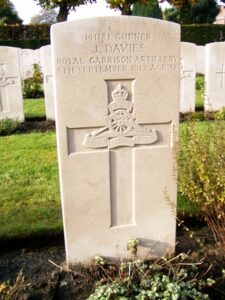
Richard Davies, Deck Hand, DA/9/88, Royal Naval Reserve. Richard was born at Borth on 29 December 1863, and married in 1878, residing with his wife, Mary Davies, and their children at 5, Wesleyan Place, Borth. Richard worked as a labourer prior to the war, but was also a Royal Naval Reservist. He was recalled to the colours at the outbreak of war, and was posted to HM Trawler Evangel. She was used for anti-submarine duties in the Irish Sea, sailing from her base at Milford Haven. On 25 March 1917, Evangel was on patrol off Milford when she struck a mine which had been laid by the German submarine UC-48, and sank with the loss of 25 lives. Richard was among the men killed that day, and was 54 years old. His body was recovered from the sea, and he was buried at Penygarn Calvinistic Methodist Cemetery, Tirymynach.
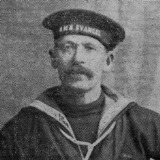
Thomas Davies, Private, 52888, Welsh Regiment. Thomas was born at Steynton in 1894, the son of John and Elizabeth Davies. He married prior to embarking for war, and his wife E. M. Davies resided at Primrose Cottage, Woodson, Milford Haven. Thomas enlisted at Cardiff into the army, joining the 11th Battalion, Welsh Regiment, which was known as the Cardiff Pals battalion, attached to 67 Brigade, 22nd Division. The Division crossed to France in early September 1915, with all units being concentrated near Flesselles by 9 September, but on 27 October 1915 the Division, embarked for Salonika from Marseilles. It completed concentration there in November, and took part in the Retreat from Serbia during December 1915. During August 1916 the division fought at the battle of Horseshoe Hill, and the following month fought at the battle of Machukovo. During the end of April and 9 May 1917 the Division fought at the battle of Doiran. Thomas took ill and died in Salonika on 13 September 1917, aged 23. He is buried at Kirechkoi-Hortakoi Military Cemetery, Salonika.
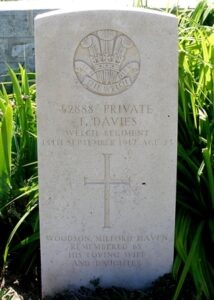
Thomas Davies, Stoker 1st Class, SS/113558, Royal Navy. Thomas was born at Milford Haven on 18 December 1888, the son of William and Esther Davies. The family later moved to 37, Oxford Street, Roath, Cardiff. Thomas served with the Royal Navy aboard HMS Warrior. Warrior was a Duke of Edinburgh-class armoured cruiser, which had been built at Pembroke Dock, and was stationed in the Mediterranean at the outbreak of war. Warrior was transferred to the Grand Fleet in December 1914, and took part in the Battle of Jutland on 31 May 1916. She was heavily damaged during the Battle, after which she withdrew and was later abandoned and sank in a rising sea. Thomas was killed during the battle. He was 27 years old, and is commemorated on the Plymouth Naval Memorial, Devon. Thomas is not commemorated on the Milford Haven Memorial.
Thomas George Davies, Engineman, 1620/ES, Royal Naval Reserve. Thomas was born on 28 March 1876, the son of Benjamin and Eleanor Davies, of Hazelbeach, Neyland, and the husband of Alice Maud Davies, at 7, Bellevue Terrace, Neyland. He served aboard HM Trawler Othonna as an Engineman. The Othonna was sunk when she struck a mine off Fife Ness on 20 April 1917 which had been laid by UC41 just a day earlier. The trawler sank with the loss of all hands. Some of the men’s bodies were washed ashore, and so afforded burial, one of whom was Thomas, who was 40 years old, and is buried at Honeyborough Cemetery, Neyland.
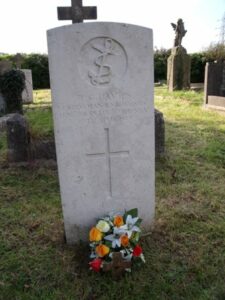
William John Davies, Sergeant, D/20358, 6th Dragoons. William was the husband of Mary Ellen Davies, of 57, Shakespeare Avenue, Milford Haven. He had worked as a prison warder at HM Prison, Preston and at HM Prison Dartmoor prior to the war. William had originally served with the 6th (Inniskilling) Dragoons during the war, before being transferred to the 6th Reserve Cavalry Regiment, possibly as a result of wounding. The 6th Dragoons had served on the Western front for the duration of the war. William died of liver disease on 12 March 1919 at the age of 37. He is buried at Chiseldon Cemetery, England.
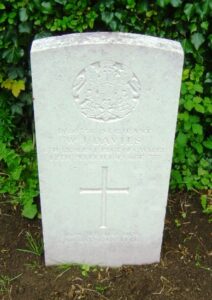
William Davies, Gunner, 447, Royal Garrison Artillery. William was the son of William and Ellen Davies, of Upper Road, Thornton, Milford Haven. He had enlisted at Milford into the Royal Garrison Artillery, joining their newly formed 68th Siege Battery, based at Hubberston, and moved to France with the battery in 1916. Williams’ time in France was to be short however, as he was killed at Arras on 25 May 1916. William was 22 years old, and is buried at Fauborg D’Amiens Cemetery, Arras, France.
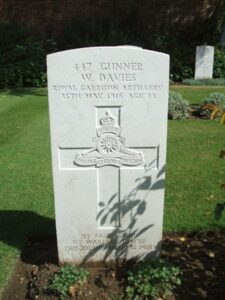
Hubert Francis Day, Second Lieutenant, Royal Fusiliers. Hubert was the son of John Henry and Margaret Day, of 128, Robert Street, Milford Haven. He was commissioned into the Honorable Artillery Company, before joining the 11th Battalion, Royal Fusiliers, which formed part of 54 Brigade, 18th (Eastern) Division. On 25 May 1915 the Division landed in Boulogne, and didn’t see its first major action until July, 1916 when it took part in the Battle of Albert. They then fought at the Battle of Bazentin, where they captured Trones Wood, and moved on to the Battle of Delville Wood. In October they took part in the Battle of the Ancre Heights, and captured Schwaben Redoubt, and helped capture Regina Trench. They then fought at the Battle of the Ancre, and during the subsequent Operations on the Ancre, before spending the winter on the Somme. In March, 1917 they followed the German Retreat to the Hindenburg Line, and in May took part in the Third Battle of the Scarpe, which was part of the Arras Offensive. July, 1917 saw the Division at Ypres, where they took part in the Battle of Pilckem, where they helped capture Westhoek, and then they fought at the Battle of Langemarck. Hubert was killed here on 10 August 1917. He was 22 years old, and is commemorated on the Ypres (Menin Gate) Memorial, Belgium. His brother John Henry was also killed.
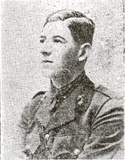
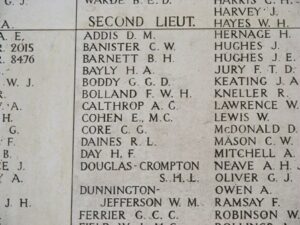
John Henry Day, Sapper, 47403, Royal Engineers. John was the son of John Henry and Margaret Day, of 128, Robert Street, Milford Haven. He worked as a Clerk prior to the war, and enlisted at Milford 4 September 1914 into the Royal Engineers. John was posted to its 13th Division Signal Company, which was attached to the 13th (Western) Division. On 13 June 1915 the first transports carrying the Division left port, and moved to Alexandria. By 4 July, all units had moved to Mudros, preparatory for landing on Gallipoli. Between 6 and 16 July 1915 the Divisional infantry landed on Cape Helles and relieved the 29th Division. They left and returned to Mudros at the end of the month, and the entire Division landed at ANZAC Cove between 3 and 5 August, 1915, taking part in the Battles of Sari Bair, Russell’s Top, and Hill 60, ANZAC. John was reported as missing, presumed killed during this period of intense fighting, on 9 August 1915. He was 24 years old, and is commemorated on the Helles Memorial, Gallipoli. His brother Hubert Francis was also killed.
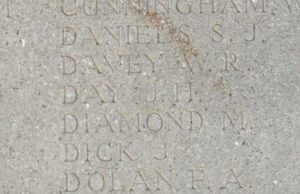
Walter Dayes, Lance Corporal, 18184, Canadian Infantry. Walter was born on 12 July 1893, the son of Walter and Winsor Dayes, of 22, Dewsland Street, Milford Haven. He had emigrated to Canada prior to the war, and worked there as a miner. Walter was one of the first to enlist in Canada, sensing the call of the British Government to its Imperial Allies, he enlisted at Valcartier on 18 August 1914, joining the 1st Battalion (Western Ontario), Canadian Infantry, which was attached to the 1st Canadian Brigade, 1st Canadian Division. The Division arrived in England in October 1914, and after training at Salisbury Plain, embarked for France in February 1915. The Division moved to the Ypres Salient in April, and faced its first real test during the defence of St. Julien beginning on 22 April, where the Canadians withstood German attacks, aided, for the first time, by the use of poison gas, and finally retired to secondary positions on 26 April, where they held on until 4 May. Two weeks later, the division was in action again at Festubert, aiding in a diversionary offensive by the British armies, and the Canadians suffered 2,200 casualties for gains of only 600 yards. Another futile attack was launched at Givenchy in June 1915, after which the division moved to Ploegsteert. Walter was killed in action at Givenchy on 15 June 1915, aged 22. He has no known grave, and is commemorated on the Vimy Memorial, France.
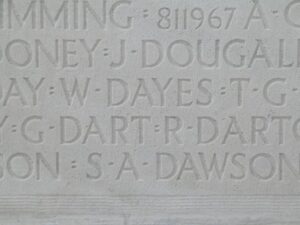
John Donovan, Private, 10543, Royal Welsh Fusiliers. John was born at Milford Haven in 1891, the son of Timothy and Mary Donovan. He resided at 6, Ordell Street, Cardiff prior to the war, and enlisted there into the Welsh Regiment, Special Reserve on 11 November 1909. On 4 November 1911 John joined the Regular Army, and was posted to the Royal Welsh Fusiliers. John went to France with the 2nd RWF at the outbreak of war, and was wounded at High Wood on 31 July 1916. After returning home to recover, he was posted to the 10th Battalion, Royal Welsh Fusiliers, which was attached to the 3rd Division, joining them on the Somme on 19 September 1916. John was killed during the Battle of the Ancre Heights on 13 November 1916, aged 25. He is buried at Queen’s Cemetery, Puisieux, France. John is not commemorated on the Milford Haven Memorial.
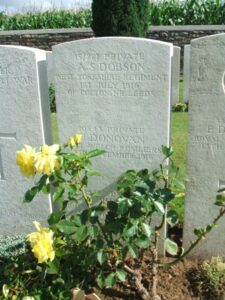
Stuart Duncan, Deck Hand, 7391DA, Royal Naval Reserve. Stuart was born on 27 July 1879 at Aberdeen, and was the husband of Elizabeth Duncan, of 12, Corton Street, Aberdeen. He served aboard HM Drifter Ladysmith, and was drowned when she sank on 27 December 1915. Stuart is commemorated on the Portsmouth Naval Memorial, Hampshire.
Charles Dunn, DCM. Nothing more can be traced of Charles, except that he was the son of Thomas and Maria Dunn, of Hill Mountain, Burton.
George Samuel Dunn, DSM, Chief Engineman, 92ES, Royal Naval Reserve. George was born at Bristol on 16 October 1882. He married Caroline Stewart, of 12, Brooke Avenue, Milford Haven, in 1904. George served aboard HM Drifter Silvery Harvest. George had been awarded the Distinguished Service Medal, the notification of which appeared in the London Gazette of 5 April 1918. Sadly, George was drowned soon after, when Silvery Harvest was lost in a collision off Berry Head on 16 May 1918. He was 35 years old, and is commemorated on the Plymouth Naval Memorial, Devon.
Harry Dyer, Seaman, 3945B, Royal Naval Reserve. Harry was born on 7 August 1883, the son of William and Sarah Dyer, of Brixham, Devon. He married in 1907, and prior to the war lived with his wife Mina Dyer, at 61, Waterloo Road, Hakin. Harry served aboard HMS Laurentic, which was an ocean liner, belonging to the White Star Line. Laurentic was used for transatlantic travel between Liverpool and Canada, and being in Canada at the outbreak of war, was requisitioned for the transport of Canadian Troops to Britain. In 1915 she was converted to an armed transport ship, and sunk when she struck a mine off Lough Swilly on 25 January 1917. Over 350 of her crew were lost, one of whom was Harry Dyer. He was 32 years old, and is commemorated on the Plymouth Naval Memorial, Devon.
Alexander Edward, Trimmer Cook, 314TC, Royal Naval Reserve. Alexander was born on 22 October 1860 at Lossiemouth. He was the husband of Isabella Edward, and the father of James Edward, of 57, Commerce Street, Lossiemouth, Morayshire. Alexander served aboard HM Drifter Ferndale, and was drowned when she sank on 27 December 1915. Alexander was 59 years old, and is commemorated on the Portsmouth Naval Memorial, Hampshire.
John Edwards, Private, 9214, Welsh Regiment. John was born at Milford Haven, the son of Thomas and Mary Edwards. The family later moved to 126, Hindercafn Road, Pen-y-Graig, Rhondda. John enlisted at Cardiff into the Welsh Regiment prior to the war, and went to France in December 1914 with the 2nd Battalion, Welsh regiment, attached to 3 Brigade, 1st Division. The Division had been one of the first to arrive in France, fighting at the Battle of Mons, and taking part in the retreat to the Marne, where the Germans were stopped. They then fought at the Aisne, and at Chivy, before being moved north to Ypres. Here they fought at the First Battle of Ypres, where they again stopped the German Offensive, before wintering in Flanders. John was wounded early in January 1915, and died at Lillers on 26 January 1915. He was 27 years old, and is buried at Lillers Communal Cemetery, France. John is not commemorated on the Milford Haven Memorial.
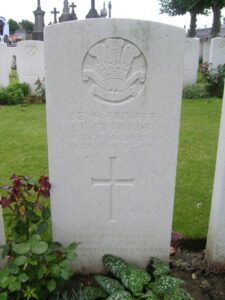
John Evans Edwards, Private, 278199, Royal Air Force. John was the son of Benjamin and Mary Edwards of Milford, and the husband of Gertrude E. Edwards, of 88, Portfield, Haverfordwest. He had been conscripted into the Royal Air Force, and was based at the Armament School at Uxbridge when he died of influenza on 22 October 1918. John was 35 years old, and is buried at Milford Haven Cemetery.
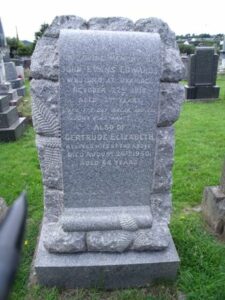
John Robinson Edwards, Private, 23080, Royal Welsh Fusiliers. John was born at Hubberston, Milford Haven, the son of Martha Edwards. He enlisted at Haverfordwest into the 9th Battalion, Royal Welsh Fusiliers. The Battalion was attached to 58 Brigade, 19th (Western) Division. The Division assembled around Bulford during September 1914. Divisional training was completed near Tidworth, from March 1915, and the Division crossed to France between 11 and 21 July 1915, moving to positions near Loos. The Division fought during the opening attack of the Battle of Loos, which is where John was killed in action, on 25 September 1915, aged 30. He has no known grave, and is remembered on the Loos Memorial, France. John is not commemorated on the Milford Haven Memorial.
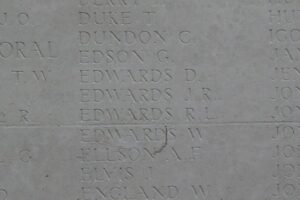
William George Edwards, Sapper, 15442, Royal Engineers. William was the son of Thomas and Hannah Edwards, of Court House, Hubberston. He worked at HM Dockyard prior to the war, and enlisted at Pennar into the Royal Engineers. After receiving his training, he was posted to the 11th Field Company, Royal Engineers, which was attached to the 2nd Division. One of the first Divisions to move to France, the 2nd Division remained on the Western Front throughout the war. They moved to Belgium, where they fought at the Battle of Mons, and retreating southwards, fought at the Affair of Landrecies, the Rearguard Actions of Villers-Cotterets, and at the Battle of the Marne where the German offensive was stopped. The Germans retreated north, and the BEF met them, fighting at the Battle of the Aisne. The 2nd Division were then moved to Flanders, where they fought at the First Battle of Ypres, when the German sweep through Flanders was stopped, and remained there throughout the first winter of the war. William died in Flanders on 11 January 1915, aged 28. He is buried at Le Touret Military Cemetery, Richebourg-L’Avoue, France.
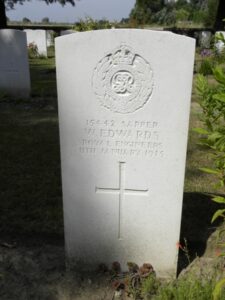
Charles Edwin Evans, Private, 37728, Welsh Regiment. Charles was the son of Edwin and Hannah Evans, of 51, Priory Road, Milford Haven. He enlisted at Haverfordwest into the 9th Battalion, Welsh Regiment, which was attached to 58 Brigade, 19th (Western) Division. The Division crossed to France between 11 and 21 July 1915, and moved to positions near Loos, where it took part in the opening attack of the Battle of Loos on 25 September 1915. The 9th Welsh attacked positions on the northern edge of the Loos battlefield, but suffered terrible casualties. Charles was one of the many men killed on the opening day of the Battle, on 25 September 1915, aged 19. Charles has no known grave, and is commemorated on the Loos Memorial, France.
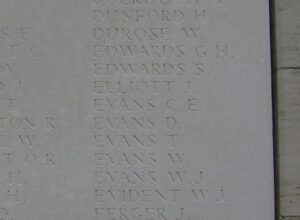
Leslie Evans, Gunner, 371230, Royal Garrison Artillery. Leslie was the Brother of Nellie Warr, of 2, Hill Street, Hakin. He was another local man to enlist into the Royal Garrison Artillery, and was posted to its 68th Brigade. Little else is known of Leslie, but he died of wounds in France on 3 May 1917, aged 26, and is buried at Wimereux Communal Cemetery, France.
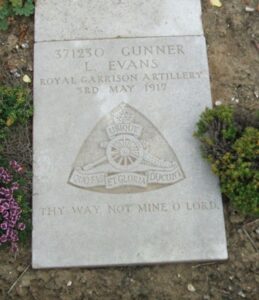
Phineas Jones Evans, Deck Hand, 8779DA, Royal Naval Reserve.Phineas was born on 7 June 1872, the son of Edward and Mary Ann Evans, of 7, Hill Street, Milford. He had served with the Royal Navy prior to the war before leaving and being placed on the Royal Naval Reserve, moving to Builth Wells to live. At the outbreak of war, he re-joined the colours and was posted aboard HM Drifter Boy Harold. On 3 March 1916, the Boy Harold was on patrol off Brindisi, Italy, when she struck a mine which had been laid by the German submarine UC-12 and sank with the loss of all hands. Phineas was 43 years old and is commemorated on the Plymouth Naval Memorial, Devon. He is not commemorated at Milford, although another crew member, John Thomas, is.
Thomas Evans, Driver, 30298, Royal Field Artillery. Thomas resided at Pontypool, and enlisted at Milford Haven into the Royal Artillery. He was posted to the 70th Battery, 34th Brigade, Royal Field Artillery, which landed in France on 21 November 1915. Thomas fought on the Western Front until being killed during the German offensive on 23 March 1918. He is buried at Lebucquiere Communal Cemetery Extension, France. Thomas is not commemorated at Milford.
Thomas Davies Evans, Serjeant, 91534, Royal Engineers. Thomas was born at Lampeter, but resided at Milford prior to the war. He enlisted at Bridgend into the army, and was posted to the 151st Field Company, Royal Engineers, which was formed at the end of 1914 as part of the 38th (Welsh) Division. The division crossed to France in December 1915, and took the line near Fleurbaix, where it remained until June 1916, when it began the long trek south to the Somme. In July 1916 the Division fought at Mametz Wood, suffering heavy casualties in the capture of the wood, before being moved to the Boesinghe sector, north of Ypres. They remained here for the coming year, and fought at the Battle of Pilckem Ridge on 31 July 1917, and also during the resulting Battle of Langemarck. Thomas was killed around this time, on 4 September 1917, aged 42. He is buried at Bard Cottage Cemetery, Belgium.
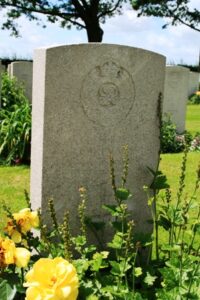
James Ferguson, Deck Hand, 1482SD, Royal Naval Reserve. James was born at Edinburgh on 16 March 1896. He was based at Milford during the war, and was the husband of Diana J. Ferguson, of 4, Charles Street, Milford Haven. James served as Deck Hand aboard HMS Prize, and was killed when Prize was sunk in action with the German Submarine U-48 on 14 August 1917, aged 21. He is commemorated on the Portsmouth Naval Memorial, Hampshire.
Albert Fisher, Able Seaman, 232272, Royal Navy. Albert was born on 9 September 1888, the son of Robert and Sarah Fisher, of Kents Hill Cottage, Thorpe-le-Soken, Clacton-on-Sea. He served as Able Seaman aboard HMS Prize, and was killed when Prize was sunk by U-48 on 14 August 1917. He was 29 years old, and is commemorated on the Plymouth Naval Memorial, Devon.
Charles Ambrose Flowerday, Private, 642662, Canadian Infantry. Charles was born at Great Yarmouth on 7 May 1896, the son of David and Martha Flowerday. The family had moved to Milford by 1901, and resided at 64, Robert Street, Milford. Charles emigrated to Canada prior to the war, and enlisted at Barrie, Ontario on 28 December 1915 into the Canadian Infantry. Charles was posted to France in 1916, joining the 1st Battalion, Canadian Infantry (Western Ontario), which was attached to the 1st Brigade, 1st Canadian Division. Charles probably saw his first action on the Somme, during the fighting at Regina Trench in August 1916. The Canadians suffered terrible casualties on the Somme, and moved to positions north of Arras. On 9 April 1917 the Canadians launched their famous assault on Vimy Ridge, and it was here that Charles was killed, on 9 April 1917, aged 20. He is buried at Nine Elms British Cemetery, Thelus, France, and is also commemorated on his parent’s grave at Milford. Charles is not commemorated on the Milford Memorial.
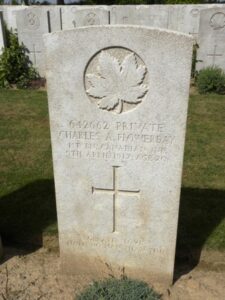
Richard Flynn, Private, 37701, Welsh Regiment. Richard was the youngest Milford soldier to be killed during the war. He was the son of Richard and Alice Flynn, of 37, Priory Road, Milford Haven. Richard enlisted at Milford into the Army, and joined the 9th Battalion, Welsh Regiment, which was attached to 58 Brigade, 19th (Western) Division. The Division assembled around Bulford during September 1914. Divisional training was completed near Tidworth, from March 1915, and the ‘Butterfly Division’ crossed to France between 11 and 21 July 1915, and moved to positions near Loos. The Division fought during the opening attack of the Battle of Loos, and it was during the initial assault that Richard was killed, on 25 September 1915. He was just 15 years old, and is commemorated on the Loos Memorial, France.
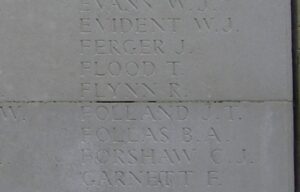
James Cobban Forsyth, Captain, Canadian Army Medical Corps. James was born at Middlesex County, London, Ontario on 3 March 1871. He resided at 16, Yarwood Street, St Thomas, Ontario prior to the war, where he was a physician. James enlisted at Calgary on 30 December 1915 into the Canadian Army Medical Corps, and was posted to France, joining the staff of the 1st Canadian General Hospital. On 8 September 1918 James was aboard the troopship S.S. Missanabie, which was on route from Liverpool for New York, when she was torpedoed by the German submarine UB-87, and sank with the loss of 45 lives. James died of wounds suffered that same day. He was 58 years old, and is buried at Milford Haven Cemetery, Wales. James is not commemorated at Milford.
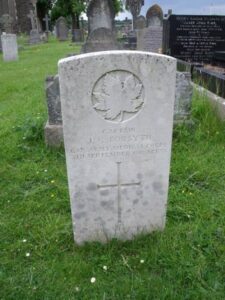
Henry Watkins Foster, Private, DM/2/129945, Army Service Corps. Henry was born on 15 July 1873, the son of Henry Simmonds Foster and Caroline Foster, of Kings Cross, London. He had married prior to the war, and lived with his wife, Gertrude Foster, at Temperance Hall, Charles Street, Milford Haven where he worked as a fisherman and was a member of the Royal Naval Reserve. Henry enlisted at Milford into the Army, and was posted to the Army Service Corps, and was posted to East Africa with his unit, where the British colonial troops were fighting against German troops in German East Africa. The campaign proved fruitless for the British until the Armistice was declared. The Germans fought a guerrilla war, using a small number of troops to keep a numerically superior British and Empire force tied down for the full four years of the war, only surrendering after the Armistice of 1918. Henry died of sickness in East Africa on 23 October 1916. He was 43 years old, and was buried at Taveta Military Cemetery, Kenya.
Donald McKenzie Fowler, Deck Hand, 3983DA, Royal Naval Reserve. Donald was born on 20 October 1884, the son of James and Margaret Masson Fowler, of 90, Victoria Road, Aberdeen. He served as Deck Hand aboard HM Drifter Ferndale. Donald was drowned when Ferndale struck rocks off St Anne’s head during a storm on 27 December 1915, and sank with the loss of nine lives. Donald was 31 years old, and is commemorated on the Portsmouth Naval Memorial, Hampshire.
Charles Wilfred Galvin, Private, 24111, Royal Fusiliers. Charles was born at Milford Haven in 1895, the son of Edith Galvin, of 79, Campbell Street, Steynton. By the time of the outbreak of war he lived at Twickenham, where he enlisted into the 7th Battalion, Royal Fusiliers. The battalion landed at Le Havre on 24 July 1916 where it was attached to 190 Brigade, 63rd (Royal Naval) Division. The Division moved to positions on the Somme, where it took part in the Battle of the Ancre, and the resulting Operations on the Ancre. In April 1917 the Division were at Arras, and fought at the Second Battle of the Scarpe, where they captured Gavrelle. They then fought at the Battle of Arleux, before moving north to Ypres, where they took part in the Second Battle of Passchendaele. Their next major action was at Cambrai, during the Action of Welch Ridge, and they were still in the area when the Germans launched their Spring Offensive, and fought at the Battle of St Quentin, and then the First Battle of Bapaume. In August, the Division took part in the Battle of Albert, which marked the beginning of the great offensive which was to end the war. Charles was killed during this time, on 27 August 1918, aged 22. He is buried at A.I.F. Burial Ground, Flers, France.
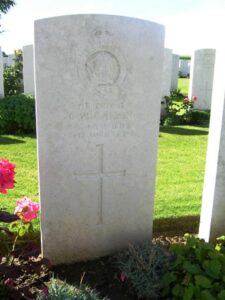
Alexander Clark Garden, Deck Hand, DA/3984, Royal Naval Reserve. Alexander was born on 6 September 1878, the son of Alexander Garden, of Lossiemouth, Morayshire. He was also serving as Deck Hand aboard HM Drifter Ferndale when she was lost on 27 December 1915. Alexander’s body was recovered from the sea, and he is buried at Milford Haven Cemetery. His brother John also died aboard Ferndale.
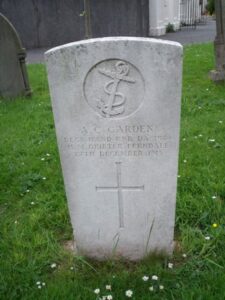
John Alexander Garden, Second Hand, 1156SA, Royal Naval Reserve. John was born on 1 May 1882, the son of Alexander Garden, of Lossiemouth, Morayshire. He served as Second Hand aboard HM Drifter Ferndale, alongside his brother Alexander, and was killed alongside him when she sank on 27 December 1915. John was 33 years old, and is commemorated on the Portsmouth Naval Memorial, Hampshire.
Charles Arthur Garnish, Skipper, Royal Naval Reserve. Charles was the son of Henry and Lucy Garnish, of Brentwood. He married Margaret Jane Davies whilst working at Milford in 1891, and the couple raised eight children at 71, Robert Street, Milford. Charles served as Skipper aboard HM Trawler Kirkland, and was drowned when she was mined and sank on 20 August 1917 off Fugla Skerry, Papastour, Shetlands. Charles was 47 years old, and is commemorated on the Plymouth Naval Memorial, Devon.
George Geddes, Trimmer, Royal Naval Reserve. George was born on 3 January 1897, the son of George and Margaret Jane Geddes, of Tarwathie, South Pringle Street, Buckie, Banffshire. He served with his father aboard HM Drifter Speedwell V. On Saturday 28 October 1916, Speedwell was caught in a heavy storm, and trying to reach Rosslare Pier for shelter, when she was driven ashore on Splaugh Rock, off Greenore Point, and broke up with the loss of all her crew. George was just 18 years old, and is buried alongside his father at Kilscoran Church of Ireland Churchyard, Ireland.
Frederick John Gibson, Sergeant, 200030, Welsh Regiment. Frederick was the son of John and Madeline Gibson, of Milford Haven. He enlisted at Milford into the 1/4th Battalion, Welsh Regiment, part of 159 Brigade, 53rd (Welsh) Division. Fred served with the battalion during its time at Gallipoli, and was with them during the evacuation, moving to Egypt. At the beginning of 1917 the British launched an offensive into Palestine, and the 4th Welsh fought at the First Battle of Gaza, which is where Fred was killed on 27 March 1917, aged 25. He is commemorated on the Jerusalem Memorial, Egypt.
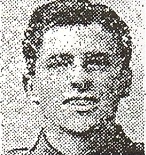
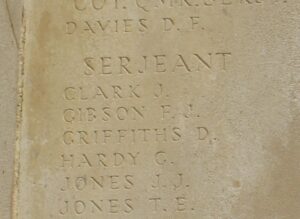
Alexander Gordon, Engineman, 2537ES, Royal Naval Reserve. Alexander was born on 7 August 1885, and was the husband of Elspeth Gordon, of 7, Main Street, Inverallochy, Aberdeenshire. He served as Engineman aboard HM Drifter Ferndale. Alexander drowned when Ferndale struck rocks off St Anne’s Head and sank on 27 December 1915. He was 30 years old, and is commemorated on the Portsmouth Naval Memorial, Hampshire.
Herbert Arthur Greenacre, Trimmer, TS/1700, Royal Naval Reserve. Herbert was born on 23 October 1871, the son of George and Louisa Greenacre, of Martham, Norfolk. He served as Trimmer aboard HM Trawler Weymouth II. Herbert was killed aboard Weymouth II on 3 June 1915, aged 48. He is buried at Milford Haven Cemetery.
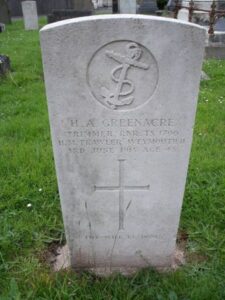
James William Samuel Grice, Engineman, 2376ES, Royal Naval Reserve. James was born on 12 March 1878, the son of James Grice and Rachel Grice (nee Woodhouse), of Sheringham, Norfolk. James served as Engineman aboard HM Trawler Evangel. He was killed when she was lost following a mine explosion in the English Channel on 25 March 1917. James is commemorated on the Chatham Naval Memorial, Kent.
Thomas John Griffith, Private, 265492, Royal Welsh Fusiliers. Thomas was from Caernarvon, and was the husband of Florence Ventia Griffith (nee Parker). He resided at Milford prior to the war, and served with the 5th Battalion, Royal Welsh Fusiliers, which was attached to 158 Brigade, 53rd (Welsh) Division. The Division landed at Cape Helles, Gallipoli, on 9 August 1915, and was immediately thrown into action, spending the next few days in isolated pockets, fighting against a Turkish counter-attack during the Battle of Sari Bair, and then at the Attack on Scimitar Hill. The Division remained here throughout the coming months. On 11 December 1915 the Division was evacuated to Mudros, and by 23 December 1915 were moved to Egypt. They remained on the Suez Canal Defences for the next twelve months, where it took part in operations against the Sultan of Darfur, and in March 1917 took part in the advance into Palestine. Thomas was killed during the First Battle of Gaza, on 26 March 1917. He is commemorated on the Jerusalem Memorial, Israel. Thomas is not commemorated at Milford.
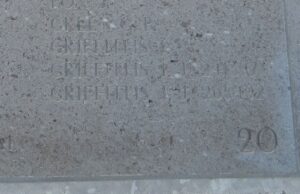
William Starbuck Griffith, Major, Royal Army Medical Corps. William was born at Milford in 1868, the son of Doctor George Griffith, and Mary Griffith (nee Starbuck). He followed his father’s profession, becoming a Doctor, and lived at Milford House, Milford Haven, with his wife Ada Mabel Starbuck (nee Tweedie), who was from Edinburgh. William served with the local Territorial force prior to the war, and was in command of military medicine in the Dale area after the outbreak of the Great War. The strain of military service proved too much for William, and he died on 23 July 1915, aged 47. William is buried at Milford Haven Cemetery.
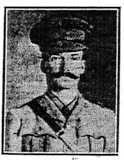
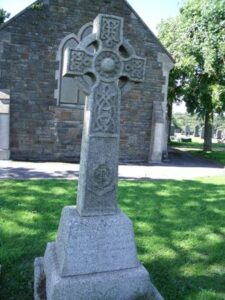
John William Grimston, Engineman, 377ES, Royal Naval Reserve. John was born at Hull on 21 August 1863, the son of Walter and Ann Grimston. He was another crewman aboard HM Trawler Evangel, and drowned when she was lost following a mine explosion in the English Channel on 25 March 1917. John is commemorated on the Chatham Naval Memorial, Kent.
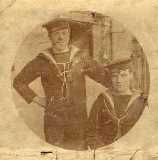
Albert John Hamilton, Private, 24831, Hampshire Regiment. Albert was born at Milford Haven, the son of George and Jane Hamilton. The family later lived at West Street, Hambledon, Hampshire. Albert enlisted at Portsmouth into the 14th Battalion, Hampshire Regiment, which was attached to 116 Brigade, 39th Division. The Division moved to France at the end of February 1916, and on 30 June 1916 it took part in a costly attack in the area of Richebourg l’Avoue. The Division moved to the Somme in August 1916, where it fought at the Battle of the Ancre Heights, where they captured the Schwaben Redoubt, and helped capture Regina Trench. They then fought at the Battle of the Ancre, and remained on the Somme over the winter. In 1917 the Division was at Ypres, and fought at the Battle of Pilckem, the Battle of Langemarck, and the Battle of the Menin Road. Albert was killed on the Menin Road on 26 September 1917, aged 23. He is commemorated on the Tyne Cot Memorial, Belgium. Albert is not commemorated on the Milford Haven Memorial.
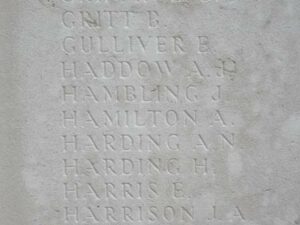
Alfred Phelps Hancock, Private, 16226, Welsh Regiment. Alfred was the son of Frederick and Elizabeth Hancock, of 37, Point Street, Hakin. He enlisted at Milford into the Army, and joined the 9th Battalion, Welsh Regiment, which was attached to 58 Brigade, 19th (Western) Division. The Division assembled around Bulford during September 1914. Divisional training was completed near Tidworth, from March 1915, and the ‘Butterfly Division’ crossed to France between 11 and 21 July 1915, and moved to positions near Loos. The Division fought during the opening attack of the Battle of Loos, and then moved to the Somme, where they took part in the second wave of the attack on Ovillers-La Boiselle on 1 July, capturing the village at heavy cost, and fought through the Somme Battles of Pozieres and the Ancre in 1916. They then moved North to Ypres, taking part in the Battle of Messines, and this is where Alfred was killed on 7 June 1917. He was 23 years old, and is commemorated on the Ypres (Menin Gate) Memorial, Belgium.
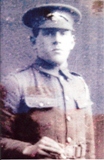
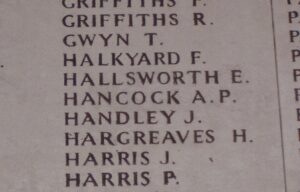
Ernest James Harding, Deck Hand, 2958TS, Royal Naval Reserve. Ernest was born on 19 January 1897, the son of Ernest and Catherine Harding, of 12, Marble Hall, Milford Haven. He served as Deck Hand aboard HM Trawler Evangel, and was drowned when she was lost following a mine explosion in the English Channel on 25 March 1917, aged 20. Ernest is commemorated on the Plymouth Naval Memorial, Devon.
Louis Ludwig Harper, Officer’s Cook 2nd Class, L/6386(CH), Royal Navy. Louis was born at Greenwich on 4 May 1894, the son of Edmund and Calara Harper. He was the husband of Susan Harper, of 31, Edmund Street, New Church Street, Camberwell, SE5. Louis served as Cook aboard HMS P 60, based at Milford. The P60 was another of the famous Q-Ships to have been based at Milford throughout the war, and although she survived the conflict, Louis is one of several of her crew to have been killed during an engagement on 4 January 1918. He was 24 years old, and is buried at West Norwood Cemetery.
David Owen Harris, Engineman, 1408ES, Royal Navy. David was born on 9 July 1878, the son of John and Magdalen Harris of Carmarthen. He had enlisted into the Royal Navy at a young age, and by 1911 was living with his wife Florence E. Harris, at 53, Waterloo Road, Hakin. David served aboard HM Trawler Blackthorne, which was a hired net drifter. David was accidentally drowned on 21 February 1918. He was 39 years old, and is commemorated on the Plymouth Naval Memorial, Devon.
Thomas Harries, Deck Hand, 9630DA, Royal Naval Reserve. Thomas was born on 22 January 1878, the son of William and Helen Harries, and the husband of Annie Harries, of Hakin Villa, 4, Wellington Avenue, Milford Haven. He served as Deck Hand aboard HM Trawler Loch Shiel. Thomas was killed when Loch Shiel struck a mine off Milford on 26 September 1916. He was 39 years old, and is commemorated on the Plymouth Naval Memorial, Devon.
William Henry Cornish Harris, Second Hand, SA/2441, Royal Naval Reserve. William was born on 21 November 1894, the son of William Henry Harris and Emma Harris, of 22, Warwick Road, Milford Haven. William had been brought up working on the trawlers, and had joined the Royal Naval Reserve at the outbreak of war. He served aboard H.M.S. Sabrina, a Medina Class Gunboat. He had been ill for a while before dying of sickness whilst on active service, on 8 August 1916, aged 21, and was buried with full military honours at Milford Haven Cemetery.
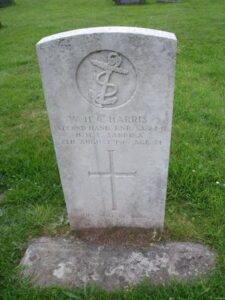
John Harvey, Engineman, ES/99, Royal Naval Reserve. John was born at Aberdeen on 10 November 1882, and was the husband of Catherine Harvey, of 10, Pill Road, Milford Haven. He served aboard HM Trawler Falmouth III, which was used for minesweeping duties around Dover Docks, and was killed when she sunk after striking a mine laid the previous morning by German submarine UC-5, on 19 November 1915. John was 41 years old, and is buried at Milford Haven Cemetery.
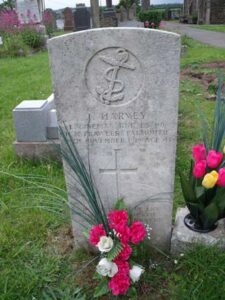
William Ronald Hastings, Private, 78599, Welsh Regiment. William was the son of Robert and Annie Hastings, of 13, Chapel Street, Milford Haven. William worked as a Butcher’s Assistant prior to enlisting into the Welsh Regiment on 24 June 1918, and was posted to the 52nd Training Reserve Battalion at Kinmel Park. Within months he became ill, and was invalided to Norfolk War Hospital in Norwich where he was found to be suffering from tuberculosis, and he was discharged from the army as medically unfit on 7 November 1918. William died of tuberculosis at Hubberston on 16 March 1919, aged just 18, and is buried in Milford Haven Cemetery. William’s case was passed onto the CWGC on 5 August 2012. He was initially rejected through lack of evidence on 21 July 2014, but has today, Tuesday 22 October 1914 been accepted for commemoration after further evidence was uncovered. He was commemorated in the United Kingdom Book of Remembrance, pending confirmation of his burial at Milford, and the CWGC have recently erected a new headstone to mark his grave.
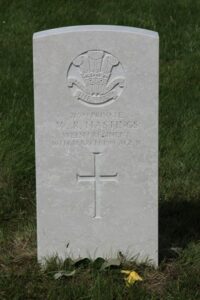
Stanley George Hawes, Fireman, Mercantile Marine Reserve. Stanley was born at Lower Walton, Suffolk in 1896, the son of James and Anna Hawes. Suring the war he was based at Milford, and served aboard H.M. Yacht Kethailes. Stanley resided with his wife Mary Ellen Hawes, at 190, Robert Street, Milford Haven. On 11 October 1917 Kethailes collided with another vessel in the Irish Sea, and sank. Stanley was 21 years old when he drowned that day, and is commemorated on the Plymouth Naval Memorial, Devon. Mary married Albert S. Watkins at Milford in 1919. Stanley is not commemorated at Milford.
James Hendry, Second Hand, 1158SA, Royal Naval Reserve. James was born on 14 August 1871, and was the husband of Margaret Hendry, of 161, High Street, Gardenstown, Banff. He served as Second Hand aboard HM Drifter Speedwell V. On Saturday 28 October 1916, Speedwell was caught in a heavy storm, and trying to reach Rosslare Pier for shelter, when she was driven ashore on Splaugh Rock, off Greenore Point, and broke up with the loss of all her crew. James was 45 years old, and is commemorated on the Portsmouth Naval Memorial, Hampshire.
Henry Thomas Henshall, DSM, Ordinary Telegraphist, J/48097, Royal Naval Reserve. Henry was born on 3 August 1899, the son of Henry and Elizabeth Sarah Henshall, of 21, Glenthorn Grove, Sale, Cheshire. He was another of the brave crew of the Q-Ship HMS Prize, and had been awarded the Distinguished Service Medal for his gallantry, which was listed in the London Gazette of 14 September 1917. Sadly however, Henry was killed during the sinking of Prize by U-48 on 14 August 1917. He was just 18 years old, and is commemorated on the Chatham Naval Memorial.
Theophilus Henry Hicks, Corporal, 30959, Welsh Regiment. Theo was the son of Thomas and Louisa Hicks, of Church Road, Hubberston, Milford Haven. He enlisted at Haverfordwest into the 1st Battalion, Welsh Regiment. The battalion was in India at the outbreak of war, and were quickly recalled to Britain, where it joined 84 Brigade, 28th Division. The Division formed in England between December 1914 and January 1915 from regular units returning from India, Singapore and Egypt. During January 1915 it moved to France, landing at Le Havre and moved to the Western Front, where it saw its first major action during the Second Battle of Ypres. Following serious casualties at Ypres, a Composite Brigade was formed, composing of the 2nd Battalion, the Buffs, 2nd Battalion, the Cheshire’s, 1st Battalion, the Welsh, and 1st Battalion, the York and Lancaster. It was dissolved on 19 May 1915, and the formation assumed its normal configuration, taking part in the Battle of Loos. During October 1915, the Division embarked at Marseilles, and proceeded to Egypt, and in November moved on to Salonika where the Division then remained. Theo died at No 4 Hospital, Versailles on 11 October 1915, aged 25. He is buried at Les Gonards Cemetery, Versailles, France.
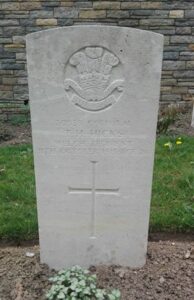
Robert Stanley Higgs, Private, 30805, Welsh Regiment. Stanley was the son of William and Maud Higgs, of Milford Haven, and the husband of Christina Higgs, of High Road, Whetstone, London. He had served during the Boer War with the 1st Volunteer Company, Welsh Regiment. At the outbreak of the Great War Stanley enlisted at Haverfordwest into the 1st Battalion, Welsh Regiment, which had been recalled to Britain from India, and joined the 84 Brigade, 28th Division. The Division formed in England between December 1914 and January 1915 from regular units returning from India, Singapore and Egypt. During January 1915 it moved to France, landing at Le Havre and moved to the Western Front, where it saw its first major action during the Second Battle of Ypres. Stanley was wounded at Ypres, and died of wounds on 21 April 1915, aged 38. He is buried at Bedford House Cemetery, Belgium. Stanley is also commemorated on the Haverfordwest War Memorial.
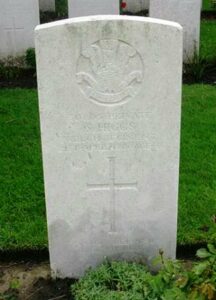
Harry Hoad, Private, 14332, Welsh Regiment. Harry was the son of Samuel and Sarah Hoad, of 124, Robert Street, Milford Haven. He enlisted at Milford into the 9th Welsh, and served in France from September 1915. Harry must have been wounded at some time, and transferred to the Middle East to join the 24th Battalion (Pembroke & Glamorgan Yeomanry), Welsh Regiment, which had been formed in Egypt in 1917 as part of 231 Brigade, 74th (Yeomanry) Division. In the spring of 1917 the Division begun their advance into Palestine, and Harry fought with the battalion at the Second Battle of Gaza. He was killed during the Third Battle of Gaza, on 6 November 1917, aged 30. Harry is buried at Beersheba War Cemetery, Israel.
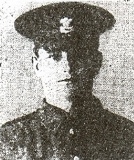
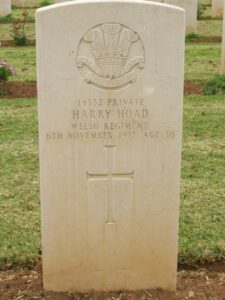
Stratton Leonard Hodgkinson, Private, 48828, South Wales Borderers. Leonard was the son of Mrs. Mary Annie Hitchings (formerly Hodgkinson), of 195, Robert Street, Milford Haven. He enlisted at Porth into the 8th Welsh. He then transferred into the 1st Battalion, South Wales Borderers at some time, which was in France as part of 3 Brigade, 1st Division. Leonard was killed in action during the final phase of the war, during the drive towards the Hindenburg Line on 1 October 1918. He is buried at Savy British Cemetery, France. His brother Thomas also fell.
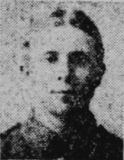
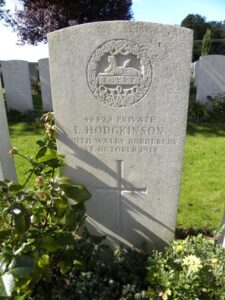
Thomas William Hodgkinson, Private, 1830, Welsh Regiment. Thomas was the son of Mrs. Mary Annie Hitchings (formerly Hodgkinson), of 195, Robert Street, Milford Haven. He had enlisted at Pontypridd into the 8th Battalion, Welsh Regiment, which was attached to 40 Brigade, 13th (Western) Division. The Division fought at Gallipoli, and was evacuated from Suvla on 19 December 1915, whereupon the infantry moved after a week’s rest to the Helles bridgehead, where they faced the last Turkish attacks at Helles. On 8 January 1916, the Division was evacuated from Helles, and by 31 January was concentrated at Port Said, where they held forward posts in the Suez Canal defences. On 12 February, 1916 the Division began to move to Mesopotamia, to strengthen the force being assembled for the relief of the besieged garrison at Kut al Amara. By 27 March, the Division had assembled near Sheikh Saad and came under orders of the Tigris Corps, and then took part in the attempts to relieve Kut. However, after these efforts failed and Kut fell, the British force in the theatre was built up and reorganised. The Division then fought at the Battle of Kut al Amara, then at the capture of the Hai Salient and the capture of Dahra Bend. They took part in the passage of the Diyala, in the pursuit of the enemy towards Baghdad, and it was around this time that Thomas was wounded. He died of his wounds on 12 January 1917, aged 22, and is buried at Amara War Cemetery, Iraq. His brother Leonard also fell.
Edward Hoggins, Private, 7180, Kings Shropshire Light Infantry. Edward was born in Staffordshire in 1885, the son of John and Jane Hoggins. He was a regular soldier, and resided with his wife Rachel Ellen Hoggins, at 4, Castle Terrace, Milford Haven. Edward served with the 1st Battalion, King’s Shropshire Light Infantry, who were stationed at Tipperary at the outbreak of war, attached to 16 Brigade, 6th Division. On 10 September 1914 the Division landed at St Nazaire and proceeded to the Western Front, and arrived in time to reinforce the hard-pressed BEF on the Aisne, before the whole army was moved north into Flanders. Edward was killed soon after, on 24 October 1914. He was 29 years old, and is commemorated on the Ploegsteert Memorial, Belgium.
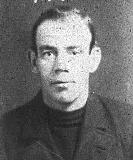
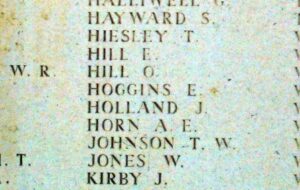
George Robert Hooper, Lance Corporal, 150909, Royal Engineers. George was the son of Richard Henry Hooper and Mary Jane Hooper, of Plymouth. He married Kate West in 1908, and the couple resided at 7, Warwick Road, Milford Haven. George had served with the 1st Volunteer Company, Welsh Regiment for several years, and enlisted at Milford into the Inland Water Transport Company of the Royal Engineers, probably due to his experience working at Milford Docks. He was posted to France on 27 April 1916, where he worked at Dunkirk docks. George is recorded as having died of wounds at Dunkirk on 3 September 1917 after having been struck in the head by shrapnel during bombing of Dunkirk. He was 29 years old, and is buried at Dunkirk Town Cemetery, France.
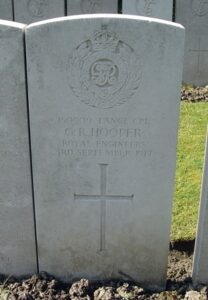
Daniel Hutchison Horne, Private, 11723, Cavalry. Daniel was born at Milford in 1893, the son of George and Agnes Horne. Agnes died in 1902, and George moved the family to 129, Norfolk Street, Mount Pleasant, Swansea. Daniel had enlisted into the 6th Dragoons in June 1911, and was discharged three months later after having been deemed unlikely to become an efficient soldier. He re-enlisted at the outbreak of war, joining the 8th (Kings Royal Irish) Hussars, which was attached to the 9th Cavalry Brigade, 1st Cavalry Division. Daniel joined the Hussars in France in September 1915, and fought there until the Armistice, when the Cavalry Division moved into Germany. Daniel died of influenza while serving as part of the Army of Occupation in Germany on 25 February 1919. He was 26 years old, and is buried at Cologne Southern Cemetery, Germany.
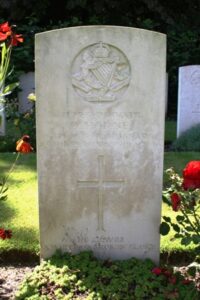
George Humphrey Horton, Engineman, 376ES, Royal Naval Reserve. George was born on 22 November 1875, the son of Thomas Bryant Horton, of 106, Lakedale Road, Plumstead, London. He had worked as a fisherman at Milford for several years, and lived with his wife Florence Horton, at 34 Point Street, Hakin. George served as Engineman aboard HM Trawler Yucca, George was killed when Yucca was sunk on 24 May 1918. He was 42 years old, and is commemorated on the Plymouth Naval Memorial, Devon.
Edmund Sydney Howells, Lieutenant, Royal Flying Corps. Edmund was the son of Canon Edmund and Mrs. Emily Maud Blanche Howells, of The Vicarage, Milford Haven. He had previously served with the Welsh Regiment in France, before becoming a pilot in 120, Squadron Royal Flying Corps. The Squadron was formed at Lympne in January 1918, and trained with the DH 9, but Edmund was killed in an accident while flying Armstrong Whitworth FK 3 A1505, on 27 March 1918. Edmund was just 19 years old, and is buried at Milford Haven Cemetery. His Observer, Second Lieutenant John Armstrong, was also killed in the accident. Edmunds obituary in ‘Flight Magazine’ reads; ‘Lieutenant EDMUND SYDNEY HOWELLS, R.F.C., who was killed accidentally, while acting as flying instructor, on March 27th, was the eldest son of the Rev. E. Howells, B.D., vicar of Milford Haven. He was educated at the King’s School, Worcester, where he represented the school on the river, and was passing from the sixth form to Oxford when the war broke out. He received a commission in the Welsh Regiment directly from the O.T.G., and served with it in France, being wounded in 1916. On recovery he returned to his regiment on another front, where he was transferred to the R.F.C., and served for some time in Egypt. Last year he was recalled to act as instructor at home.’
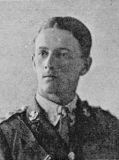
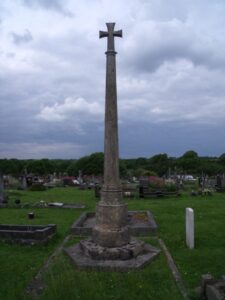
Lewis Hughes, Private, 81771, New Zealand Expeditionary Force. Lewis was the son of Edward Lewis Hughes and Emma Louisa Hughes, of Milford Haven. He had been born in Auckland, New Zealand, and was the husband of Mrs. L. E. Hughes, of 29, Great North Road, Grey Lynn, Auckland. Lewis enlisted into the Otago Regiment, New Zealand Infantry, which was part of the 1st Brigade, New Zealand Division. He had probably served at Gallipoli in 1915, then on the Western Front from 1916 to 1918. He became ill towards the end of the war, and died of pneumonia on 28 October 1918. Lewis was 30 years old, and is buried at Tidworth Military Cemetery, England. Lewis is not commemorated on the Milford Haven Memorial.
John William Humphries, Third Mate, Mercantile Marine. John was the son of Ellen Louisa Humphries, of 13, Dartmouth Gardens, Milford Haven. He served as Third Mate aboard the SS Bulgarian, a Glasgow registered vessel. John died aged 24 on 20 January 1917, when Bulgarian was sunk by a German submarine. He is commemorated on the Tower Hill Memorial, London.
John Lumsden Inch, Skipper, Royal Naval Reserve. John was the son of Robert and Annie Inch, of Leith, and the husband of Susan Amelia Inch, of 21, Ouse Street, Weaste, Manchester. He served as Skipper aboard HMS Prize, and was killed when she was sunk by U-48 on 14 August 1917. John was 36 years old, and is commemorated on the Plymouth Naval Memorial, Devon.
Reginald Norton James, Engineman, 401ES, Royal Naval Reserve. Reginald, known as Norton, was born on 13 March 1893, the son of Thomas and Martha Jane James, of Pembroke Dock. He lived at 11, Dartmouth Gardens, Milford Haven prior to the war, working as a trawlerman, and was a member of the Royal Naval Reserve, having served previously in the Royal Navy. He re-joined the colours at the outbreak of war and was posted aboard HM Trawler Star of Freedom. On 19 April 1917, Star of Freedom was on patrol off Trevose Head when she struck a mine which had been laid by the German submarine UC-47 and sank with the loss of ten men. Norton was 24 years old and is commemorated on the Plymouth Naval Memorial, Devon. Another Milford man, Joseph Mills, was also lost in the sinking.
Thomas James, Leading Stoker, 292153, Royal Navy. Thomas was born on 25 January 1878. He was the husband of Sarah James, of Blackbridge, Milford Haven, and served aboard HMS Warrior. She was a Duke of Edinburgh Class armoured cruiser, which had been built at Pembroke Dockyards. She joined the Grand Fleet at the outbreak of war, as part of the 1st cruiser Squadron, and took part in the greatest naval battle of all time, the Battle of Jutland, on 31 May 1916. Warrior played a brave part in the battle, but was worn down by heavy German fire. Many of her crew were killed during the battle, but for a while she remained afloat, being taken under tow by HMS Engadine. She sank the following day, with 743 of her crew having been rescued. Thomas was one of the unlucky ones however. He was killed on 31 May 1916 aged 38, and is commemorated on the Plymouth Naval Memorial, Devon.
Thomas Henry James, Private, 44331, Welsh Regiment. Thomas was the son of Harry and Edith James of 199, Robert Street, Milford Haven. He enlisted at Milford into the Army, and was posted to the 17th Battalion, Welsh Regiment, which formed part of 119 Brigade, 40th (Bantam) Division. This Division was formed between September and December 1915, composed of bantam units and others which had a mixture of regulation-height and shorter men. Weeding out of very under-sized or unfit men delayed the training programme, and it was not until late Spring 1916 that the Division was ready to proceed on active service. The Division moved to France between the 1st and 9th June, and moved to the front near Loos. Late in 1916 they moved south to the Somme, and fought at the Battle of the Ancre, and remained in the area over the winter. In March, 1917 the Germans withdrew to their shortened line, called the Hindenburg Line, and the 40th Division were one of the Divisions that followed the withdrawal. Thomas was killed during this period of stagnant warfare, on 5 September 1917. He was 23 years old, and is buried at Gouzeaucourt New British Cemetery, France.
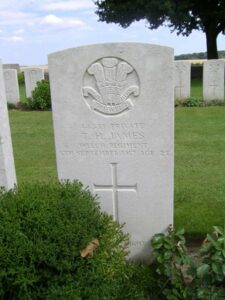
George James Jarrett, DSM and Bar, Petty Officer, 222863, Royal Navy. George was born on 18 January 1887, and was the husband of Annie Jarrett, of 37, Sydney Street, Brightlingsea, Essex. He was a regular Royal Navy officer, and served aboard the Q-Ship HMS Prize. He had been awarded the Distinguished Service Medal twice during the course of the war, the first being listed in the London Gazette of 22 June 1917, and the second on 14 September 1917. However, by then George had been killed in action when Prize was attacked and sunk by U-48 on 14 August 1917. He is commemorated on the Plymouth Naval Memorial, Devon.
Arthur Merchant Jeffs, Private, 633841, London Regiment. Arthur was the son of Daniel and Ellen Jeffs, of Milford Haven. He enlisted at Milford into the Pembroke Yeomanry, and was posted to the 15th Battalion, London Regiment, before being transferred into the 2/20th Battalion (Blackheath and Woolwich), London Regiment, which was attached to 180 Brigade, 60th Division. The division moved to France in June 1916, but within months was transferred to Salonika. During July 1917 it transferred to Palestine and took part in the Third Battle of Gaza and the capture of Jerusalem. Arthur suffered several bouts of sickness in Palestine, and must have been relieved when the battalion moved to France in May 1918, joining 185 Brigade, 62nd Division. Arthur was killed during the push forward towards the Hindenburg Line on 30 August 1918, during the German counter attacks at Vraucourt and Vaulx-Vraucourt. He was 30 years old, and is buried at Vaulx Hill Cemetery, France.
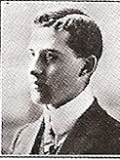
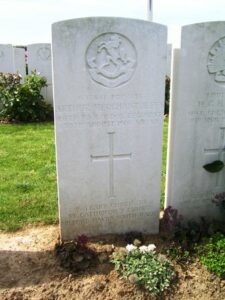
David Thomas Job, Engineman, 84ES, Royal Naval Reserve. David was born on 12 October 1881, the son of John and Elizabeth Job, of Milford Haven, and the husband of Mabel Job, of 43, St Anne’s Road, Hakin. David served as Engineman aboard HM Trawler Lydian, and was killed when she struck a mine and sank off South Foreland on 18 September 1915. David was 35 years old, and is commemorated on the Plymouth Naval Memorial, Devon.
Jack John, Private, 68123, Cheshire Regiment. Jack was the son of Henry and Mary Ann John, of 8, Greville Road, Milford. He enlisted there on 18 March 1918 into the Welsh Regiment. After training he was posted to the 1st Battalion, Cheshire Regiment, which was attached to 15 Brigade, 5th Division. On 14 August 1918 Jack landed in France, joining his new battalion, which was in Reserve. Two weeks later it began its part in the great offensive which forced the German Army into retreat, fighting through Albert (back on the old and devastated Somme ground of 1916), to Irles, and Beugny. Jack was killed during the advance, in the attack on the Canal du Nord, on 27 September 1918, aged 19. He has no known grave, and is commemorated on the Vis-En-Artois Memorial, France.
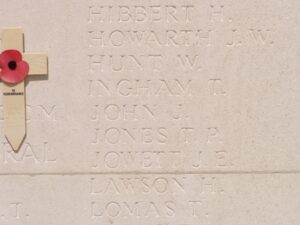
William Arthur John, Private, 79940, Royal Army Medical Corps. William was the son of William and Elizabeth John, of 6, Lower Cromwell Terrace, Priory, Milford Haven. He enlisted at Milford into the Royal Army Medical Corps on 11 December 1915. William served in Britain until being passed fit for overseas service in August 1916, and was posted to the Far East. William arrived at Alexandria in October 1916, then sailed via Suez to Bombay, before being posted to Basra. Little else is known of William, but he died was invalided to India, and died at Deccan War Hospital, Poona on 10 October 1918 aged 22. William is commemorated on the Kirkee 1914-1918 Memorial, India.
James Jones, Passenger, Mercantile Marine. James was the Nephew of Stevo Stephenson, the skipper of the Steam Trawler Victoria. The young boy went for a joy ride on the Trawler and was killed when she was sunk by shellfire from a German U-Boat on 1 June 1915. James is not commemorated by the CWGC and isn’t named on the Milford Memorial.
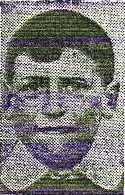
John Jones, Deck Hand, 265DA, Royal Naval Reserve. John was born on 19 October 1888, the son of John Jones, of Milford Haven. He resided with his wife, Ethel Jones, at 43, Moffatt Road, Thornton Heath, Surrey during the war, and served as Deck Hand aboard HM Trawler James Hunniford. Little is known of her, but John drowned on 17 June 1918. He was 29 years old, and is commemorated on the Plymouth Naval Memorial, Devon.
John Samuel Jones, Leading Stoker, K/14751, Royal Naval Reserve. John was born on 6 October 1893, the son of John and Martha Jones, of 37, Urban Terrace, Wellington, Shropshire. He served aboard HMS Minotaur, which was an armoured cruiser, which was used mainly for convoy escort duties, but had fought at the Battle of Jutland on 31 May 1916. Little is known of John, or why he is commemorated on the Milford War Memorial, but Minotaur was scrapped at Milford after the war. John died of disease at Milford on 5 July 1918, aged 24, and is buried at Wellington General Cemetery, Shropshire.
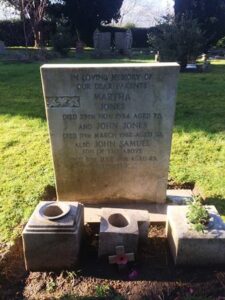
James Frederick Joyce, Gunner, 371334, Royal Garrison Artillery. James was the son of Joseph and Emma Joyce, of Milford Haven. He enlisted at Milford into the Royal Garrison Artillery, and joined its 171st Siege Battery, moving to Italy in 1917. James was fatally wounded on the Italian Front, and died of his wounds on 3 September 1918 aged 21. He is buried at Barenthal Military Cemetery, Italy.
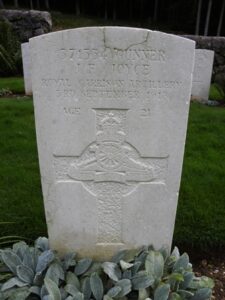
Colin Kerr, Deck Hand, 258DA, Royal Naval Reserve. Colin was born at Glasgow on 29 June 1891. He was based at Milford prior to the war, and resided with Mrs Jane Horst, of 66, Priory Road, Milford Haven. Colin served as Deck Hand aboard HM Trawler Helgian. Colin drowned when Helgian struck a mine in the Aegean and sank on 6 September 1917. He was 26 years old, and is commemorated on the Plymouth Naval Memorial, Devon.
Arthur Gerald King, Private, 39646, Royal Welsh Fusiliers. Arthur was the son of Joseph and Mary Amanda King, of 5, Marble Hall Road, Milford Haven. He enlisted at Milford on 10 December 1915 into the Royal Welsh Fusiliers. At some time during 1916 Arthur was posted to France, joining the 2nd Battalion, Royal Welsh Fusiliers, which was attached to 19 Brigade. The brigade spent the war being posted from one Division to another, and fighting in some of the bloodiest battles of the Western Front. By early 1917 the brigade was attached to 33rd Division, and took part in the Battle of Arras. Arthur was killed at Arras on 27 May 1917, aged just 20. He has no known grave, and is commemorated on the Arras Memorial, France.
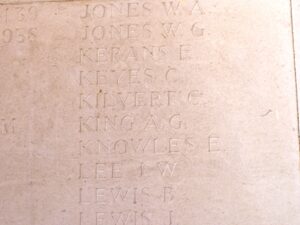
Nicholas King, Seaman, 6829A, Royal Naval Reserve. Nicholas was born on 10 February 1894, the son of Nicholas and Delia King, of Claddagh Parade, Galway. He served as Seaman aboard HMS Prize. He was killed in action at the age of 22, when Prize was sunk by U-48 on 14 August 1917, and is commemorated on the Portsmouth Naval Memorial, Hampshire.
Harold Edgar Kipps, Telegraphist, London/Z/4620, Royal Naval Volunteer Reserve. Harold was born on 18 July 1891, the son of Arthur Edward and Ada Selfe Kipps, of 3, Albert Road, Brockley, London. He was educated at Strand School, London, and Matriculated at London University. Harold had got engaged to Ethel Marion Keen whilst serving on the Dover Patrol. Harold was then posted to Milford, and served as Telegraphist aboard HM Trawler Evangel. He drowned when Evangel sank after striking a mine off St. Anne’s Head on 25 March 1917. Harold was 25 years old, and is commemorated on the Chatham Naval Memorial, Kent. (Photograph courtesy of Suzanne Newton).
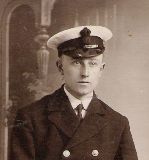
Charles Benjamin Lake, Second Hand, 602DA, Royal Naval Reserve. Charles was born on 22 October 1883, the son of John and Mary Lake, of Gorleston, Great Yarmouth, and the husband of Lilly Lake, of 54, Gipsy Road West Norwood, London. He served as Second Hand aboard HM Trawler Apley, and was killed when she struck a mine off Worthing on 6 December 1917. Charles was 34 years old, and is commemorated on the Plymouth Naval Memorial, Devon.
Frederick Palmer Lake, Skipper, Royal Naval Reserve. Frederick was the son of Frederick and Susan Lake, of Brixham, Devon. He married Nellie May Steward whilst based at Milford in 1916. Frederick served as Skipper aboard HMS Prize, and was killed when she was sunk by U-48 on 14 August 1917. Frederick was 25 years old, and is commemorated on the Plymouth Naval Memorial, Devon.
G. M. Law, Royal Naval Reserve. This man cannot presently be identified.
William John Henry Lawrence, Royal Naval Reserve. John was born on 17 February 1895, the son of Thomas Henry Lawrence and Sarah Jane Lawrence, of 19, St Peters Road, Milford Haven. Very little is known of him, but he had served with the Trawler section of the Royal Naval Volunteer Reserve before taking ill, and died on 4 April 1917, aged 22. He is buried in Milford Haven Cemetery. William is not commemorated by the CWGC.
Simon Lawrie, Trimmer, 2252TS, Royal Naval Reserve. Simon was born on 16 September 1892, the son of George and Mary Lawrie, of 18, Park Street, Aberdeen. He served aboard HM Drifter Gellyburn. Simon drowned on 10 September 1915, aged 22. He is buried at Aberdeen (Trinity) Cemetery, Scotland.
George Lees, Deck Hand, 4871DA, Royal Naval Reserve. George was born on 26 August 1886, the son of George and Jane Lees, of 1, Old Pier, Stonehaven. He served at HMS Sabrina at Milford, and was attached to the crew of HM Drifter Comely Bank. George fell overboard and drowned while working the anchor on Comely Bank on 25 February 1916 aged 29. His body was recovered from the sea five weeks later, identified and buried at Milford Haven Cemetery. His grave was forgotten for many years until being recently discovered, and he was commemorated on the Portsmouth Naval Memorial, Hampshire, but a new CWGC headstone has recently been erected over his grave.
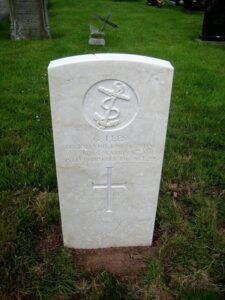
Thomas George Lewis, Private, 76697, Kings Liverpool Regiment. Thomas was the son of George William and Katie Agnes Lewis, of 47, St. Anne’s Road, Hakin. He had originally enlisted into the 4th Welsh, but was then posted to the 23rd Works Battalion, King’s Liverpool Regiment, on Home Service. Thomas died on 21 May 1917 aged just 19, and is buried at Milford Haven Cemetery.
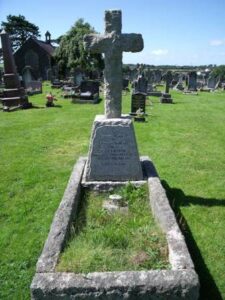
William Henry Lewis, Private, 1228, Welsh Regiment. William was born at Swansea, and must have worked at Milford before enlisting at Cardiff into the 2nd Battalion, Welsh Regiment prior to the outbreak of war. The battalion was one of the first in France, as part of 3 Brigade, 1st Division, fighting at the Battle of Mons, and taking part in the retreat to the Marne, where the Germans were stopped. They then fought at the Aisne, and at Chivy, before being moved north to Ypres. Here they fought at the First Battle of Ypres, where they again stopped the German Offensive, before wintering in Flanders. The following year saw them in action again at the Battle of Aubers, and it was here that William was killed on 2 April 1915. He has no known grave, and is commemorated on the Le Touret Memorial, Richebourg L’Avoue, France.
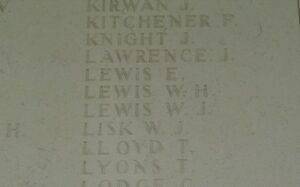
Frederick William Limbrick, Skipper, Royal Naval Reserve. Frederick was born at Brixham, Devon on 20 October 1885, the son of Robert and Elizabeth Limbrick. The family had moved to Milford when Frederick was young, and he grew up there, marrying Margaret Mayberry in 1908, and the couple set up home at Point Villa, Hakin. Frederick served as Skipper aboard HMS Unity, an Acasta Class Destroyer. He unfortunately drowned while being ferried to Unity in a small boat in a gale at Rosslare Harbour on 4 October 1916, aged 30. Frederick is buried at Milford Haven Cemetery.
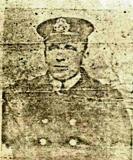
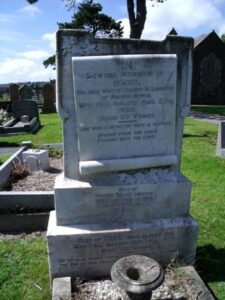
William John Lisk, Private, 14752, Welsh Regiment. William was the son of Stephen and Sarah Lisk, of Swansea. He enlisted into the 3rd Battalion, Welsh Regiment at Swansea on 3 January 1903, and married Elizabeth Ann Maloney in 1906. The couple resided at Milford prior to the war. William was mobilised at the outbreak of war and posted to France with the 2nd Battalion, Welsh Regiment, which was attached to 3 Brigade, 1st Division. The division had been one of the first to arrive in France, fighting at the Battle of Mons, and taking part in the retreat to the Marne, where the Germans were stopped. They then fought at the Aisne, and at Chivy, before being moved North to Ypres. Here they fought at the First Battle of Ypres, where they again stopped the German Offensive, before wintering in Flanders. William was killed during that first winter, on 25 January 1915, aged 32. He is commemorated on the Le Touret Memorial, Richebourg L’Avoue, France.
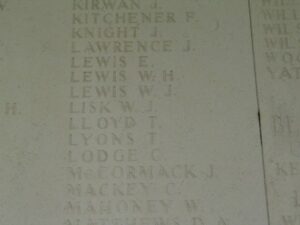
George Little, Private, 29507, West Yorkshire Regiment. George was the husband of Elizabeth Little, of 29, Surtees Street, Bishop Auckland, Co. Durham. He had been born in Edinburgh, before moving to Milford Haven with his wife Elizabeth in the years before the war. George enlisted there into the army, and was posted to the 1st Battalion, West Yorkshire Regiment, which was attached to 18 Brigade, 6th Division. On 10 September 1914 the Division landed at St Nazaire and proceeded to the Western Front, and arrived in time to reinforce the hard-pressed BEF on the Aisne, before the whole army was moved north into Flanders. Here they took part in the Action of Hooge during June, 1915, and in 1916 moved to the Somme, where the Division fought at the Battle of Flers-Courcelette, the Battle of Morval and the Battle of Le Transloy. George was killed at Le Transloy on 12 October 1916, aged 27, and is buried at Bancourt British Cemetery, France.
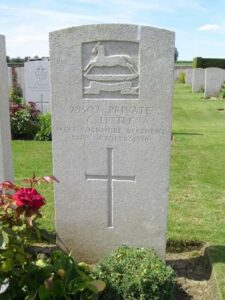
Edward James Lumsdaine, Corporal, 48, Royal Garrison Artillery. Edward was born at Penzance in 1882, the son of James and Caroline Lumsdaine. The family later moved to Milford Haven, where they lived for several years before moving to 1, White Street, Swansea. Edward married Mary Daly at Swansea in 1905, and the couple moved back to Milford, where Edward served as a Territorial Soldier, with the Pembroke Royal Garrison Artillery, based at Milford. He became ill with Pulmonary Tuberculosis while on active service at Stack Rock, and was sent to the Beechwood Hospital at Newport, Monmouth, where he died on 28 August 1916, aged 34. Edward is buried at Swansea (Danygraig) Cemetery. Sadly, his widow Mary died the following year, leaving their seven children to be sent to an Orphanage at Bristol. Edward, like his two brothers, is not commemorated at Milford.
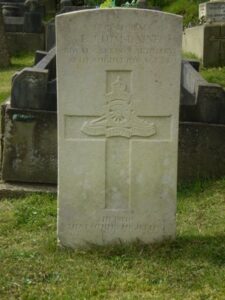
James Lumsdaine, Private, 17756, Welsh Regiment. James was born at Lowestoft in 1883, the son of James and Caroline Lumsdaine. The family had resided at Milford for several years before moving to 1, White Street, Swansea. James married Lucy Maud Evans at Swansea in 1908, and after a spell living back at Milford, the couple set up home at 17, Port Tennant Road, Swansea prior to 1914. James was one of the original men to enlist at Swansea in August 1914 into the 14th Battalion, Welsh Regiment, which was known as the Swansea Pals Battalion, attached to 114 Brigade, 38th (Welsh) Division. The battalion rained at Rhyl and Winchester, before moving to France in December 1915, taking up the line near Fleurbaix, Northern France. James was one of the earliest casualties of the battalion, when he was killed on 27 January 1916. He was 32 years old, and is buried at St. Vaast Post Military Cemetery, Richebourg-L’Avoue, France. James, like his two brothers, is not commemorated at Milford.
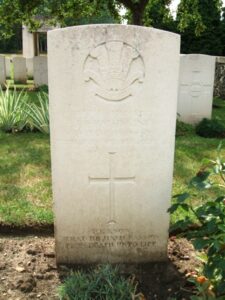
Leslie Lumsdaine, Sapper, 86574, Royal Engineers. Leslie was born at Milford Haven in 1895, the son of James and Caroline. The family later moved to 1, White Street, Swansea. Leslie originally enlisted into the Somerset Light Infantry, but was later transferred into the 185th Tunnelling Company, Royal Engineers. The Company was on the Somme over the winter of 1915/1916, preparing mines under the German lines, in preparation for the forthcoming Somme Offensive of 1 July 1916. At around 14.00 on 4 February 1916, the Germans fired a mine opposite trench 120 and launched a gas attack on the men of 185th Tunnelling Company, killing their Commanding Officer and 17 sappers. Leslie was one of the dead men. He was 20 years old, and is buried at Becourt Military Cemetery, Becordel-Becourt, France. Leslie, like his two brothers, is not commemorated at Milford.
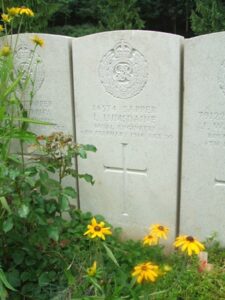
Kenneth Norman MacDonald, Deck Hand, 14514DA, Royal Naval Reserve. Kenneth was born at Lochcarron, Ross on 25 September 1897, the son of Kenneth and Catherine Macdonald, of Yorke Cottage, Plockton, Ross shire, and was educated at Plockton Higher Grade School and at Aberdeen Grammar School. He was a student of Aberdeen University when war broke out, studying Arts and Medicine, and enlisted into the Royal Naval Reserve on 12 September 1916, where he was posted aboard HMS Prize. Kenneth was killed when Prize was sunk by the U-48 on 14 August 1917. He was just 19 years old, and is commemorated on the Portsmouth Naval Memorial, Hampshire.
William Mair, Deck Hand, 7273DA, Royal Naval Reserve. William was born on 10 December 1895, the son of James and Margaret Mair, of Aranmore, Portknockie, Banffshire. He served aboard HM Drifter Ladysmith, based at Milford. William was one of the crewmen who lost their lives when Ladysmith was lost in a Gale off the West Wales coast on 27 December 1915. He was 19 years old, and is commemorated on the Portsmouth Naval Memorial, Hampshire.
Jonathan James Manthorpe, Deck Hand, 2967DA, Royal Naval Reserve. Jonathan was born at Bermondsey on 29 December 1895, the son of William and Georgina Manthorpe. Jonathan was based at Milford when he married the widowed Alice May Byford (nee Paton), of Beach Road, Pill, Milford Haven. He served aboard the Q-Ship HMS Prize. Jonathan was killed when Prize was destroyed by U-48 on 14 August 1917. He was 20 years old, and is commemorated on the Chatham Naval Memorial, Kent. Alice married Archibald Jennings in 1919, and died in 1981. Her first husband, John Herbert Byford, had been killed in 1915.
William John Marchant, Rifleman, 316215, Monmouthshire Regiment. William was the son of Henry and Sarah Ann Marchant, of 10, Brick Houses, Pill, Milford Haven. He enlisted at Milford into the Army, and joined the 1st Battalion, Monmouthshire Regiment, which was the Pioneer Battalion to the 46th (North Midland) Division. The Division had fought at Loos in 1915 and Gommecourt in 1916, and also at Arras in 1917. Their greatest moment came in 1918 when they took part in the advance to the Hindenburg Line, and captured a vital crossing at Riqueval. William was killed during the advance to the Hindenburg Line on 8 October 1918. He was just 18 years old, and is buried at Sequehart British Cemetery No. 1, Aisne, France.
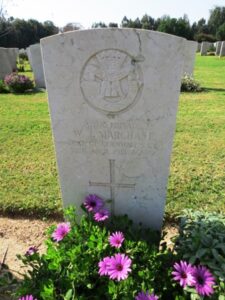
Albert Martin, Stoker 1st Class, K/9641, Royal Navy. Albert was born on 29 March 1888, the son of Richard Edward and Ellen Martin, of 10, Hakinville, Milford Haven. He was a pre-war regular in the Royal Navy, serving aboard HMS Amphion. She was an Active Class light cruiser, and was assigned as leader of the 3rd Destroyer Flotilla with the Harwich Force, defending the eastern approaches to the English Channel. On the afternoon of 5 August 1914, she investigated a trawler, which was acting suspiciously in the English Channel. She turned out to be a German minelayer, and was pursued and sunk by Amphion, in the first naval engagement of the war. After further action against another German vessel, Amphion was returning to Harwich, but struck a mine and sunk on the morning of 6 August 1914. Albert was one of the men killed when the mine exploded, becoming one of the very first British casualties of the Great War. Albert was buried at Shotley (St. Mary) Churchyard, Suffolk. He was 26 years old. Albert was one of four Pembrokeshire men who claim the dubious honour of being the first county casualties of the war.
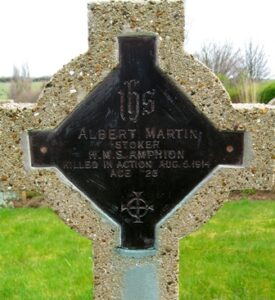
John Lloyd Marvelly, Engineman, 1734ES, Royal Naval Reserve. John was born at Llandeilo on 12 May 1860, and was the husband of Harriet Ann Marvelly (nee Wright), of 26, Dartmouth Street, Milford. He served aboard HM Trawler Lobelia II. John was killed when she struck a mine off Lough Swilly on 19 April 1917. John was 57 years old, and is commemorated on the Plymouth Naval Memorial, Devon.
Algernon Douglas Hamilton Mason, Private, 45526, Machine Gun Corps. Algernon was born at Milford Haven in 1895, the son of Robert Farrer Mason and Elizabeth North Mason. The family later lived at 18, Lansdowne Street, Hove, Sussex. Algernon enlisted at Chichester on 17 May 1916 into the 14th Battalion, Royal Fusiliers, but was later transferred into the 156th Company, Machine Gun Corps. Algernon was wounded on the Somme in September 1916, and was evacuated to the Base Hospital at Rouen for treatment. He died of his wounds there on 3 October 1916, aged 21, and is buried at St. Sever Cemetery, Rouen, France. Algernon is not commemorated on the Milford Haven Memorial.
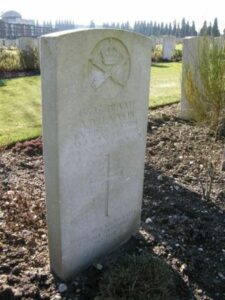
Clifford Mathias, Private, 14374, Welsh Regiment. Clifford was the son of Jonathan and Emma Jane Mathias, of 9, Murray Road, Pill, Milford Haven. He enlisted at Milford into the 9th Battalion, Welsh Regiment, part of 58 Brigade, 19th (Western) Division. The Division assembled around Bulford during September 1914. Divisional training was completed near Tidworth, from March 1915, and the ‘Butterfly Division’ crossed to France between 11 and 21 July 1915, and moved to positions near Loos. The Division fought during the opening attack of the Battle of Loos, and then moved to the Somme, where they took part in the second wave of the attack on Ovillers-La Boiselle on 1 July, capturing the village at heavy cost. Clifford was killed during the fighting at Ovillers on 7 July 1916, aged 20. He has no known grave, and is commemorated on the Thiepval Memorial, France. He is also commemorated on his parent’s gravestone at Milford Haven Cemetery. His brother Frederick also fell.
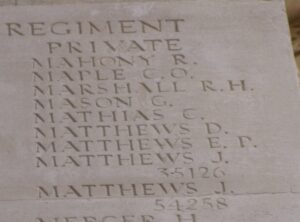
Frederick James Mathias, Second Hand, 1882SA, Royal Naval Reserve. Frederick was born on 3 August 1890, the son of Jonathan and Emma Jane Mathias, of 9, Murray Road, Pill, Milford Haven. He was the husband of Alice Mathias, of Lliswerry, Newport, Monmouth. He served aboard HM Drifter Active III, and was killed when she struck a mine off Milford Haven on 15 October 1917. Frederick was 27 years old and is commemorated on the Plymouth Naval Memorial, Devon. His brother Clifford also fell.
James Hubert Mathias, Private, 14326, Welsh Regiment. James was the son of Arthur and Martha Maria Mathias, of 7, Greville Road, Milford Haven. He enlisted at Milford into the Army, and joined the 11th Battalion, Welsh Regiment, known as the Cardiff Pals, attached to 67 Brigade, 22nd Division. The Division crossed to France in early September 1915, with all units being concentrated near Flesselles by 9 September. However, it’s stay in France was to be very short, as on 27 October 1915 the Division, having been moved by train to Marseilles, began to embark for Salonika. It completed concentration there in November, although the final artillery units were still coming in as late as 13 December 1915. It remained in the theatre for the rest of the war, taking part in the Retreat from Serbia during December, 1915. Between 10 to 18 August 1916 they fought at the battle of Horseshoe Hill, then between 13 to 14 September 1916 at the battle of Machukovo. Between 24-25 April and 8-9 May 1917, the Division fought at the battle of Doiran, and the lines then remained static for several months. James became ill with malaria during this peaceful period, and returned home for treatment, sadly dying on 26 June 1918. He was 31 years old, and is buried at Milford Haven Cemetery.
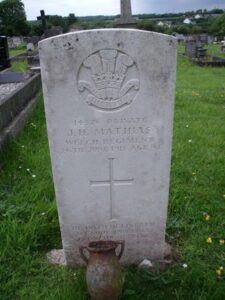
John Mathias, Sergeant, 45, Royal Garrison Artillery. John was the husband of Mary Mathias, of 175, Robert Street, Milford Haven. He had enlisted at Milford into the Royal Garrison Artillery, and joined their Pembroke Company, on Home Defence at Milford. He died of a gastric ulcer on 18 November 1915, aged 41, and is buried at Milford Haven Cemetery. He left his wife and two young children.
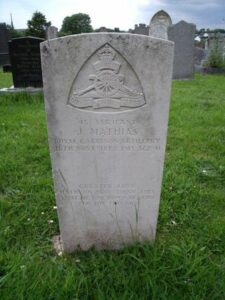
Dennis McCarthy, Mate, Mercantile Marine. Dennis was born at Brixham, Devon in 1874, the son of Daniel and Mary Ann McCarthy. By 1901 the family had moved to 9, Bridge Street, Hakin. Dennis served aboard the Steam Trawler Victoria, a Fleetwood registered vessel, which had been converted for minesweeping duties, based at Milford. Dennis was killed when Victoria was attacked and sunk by the German submarine U-34 on 1 June 1915. Dennis was 41 years old, and is commemorated on the Tower Hill Memorial, London. Dennis does not seem to be commemorated locally.
Thomas Henry McDougall, Second Hand, 2414SA, Royal Naval Reserve. Thomas was born on 3 March 1892, the son of Thomas and Mary Rea McDougall, of Glasgow. He was based at Milford during the war, and married Winifred Shanahan, of 43, Great North Road, Milford Haven, in 1915. Thomas served aboard HMPMS Ludlow, which was a Patrol Ship, operating in the North Sea. Thomas was killed when Ludlow struck a mine on 29 December 1916. He was 23 years old, and is commemorated on the Plymouth Naval Memorial, Devon.
Neil McKay, Engineman, 387/ES, Royal Naval Reserve. Neil was born at Swordby, Sutherland on 1 January 1877, and was the husband of Rachel McKay, of 1, Nicol Place, Leith, Scotland. He served aboard H.M. Trawler, Othonna, which had been based at Milford for several years prior to the war, before being requisitioned by the Admiralty and converted to a minesweeper. On 20 April 1917 Othonna struck a mine off Tod Head, Fife Ness, Scotland, which had been laid by the German submarine UC-41, and sank with the loss of nine lives. Neil was 40 years old when he died that day, and is commemorated on the Portsmouth Naval Memorial, Hampshire. Neil is shown as D. Mackay on the memorial, but this is the only McKay who died aboard a Milford trawler.
Andrew Smith McRuvie, Trimmer, 3668TS, Royal Naval Reserve. Andrew was born on 30 September 1891 the son of George and Catherine McRuvie, of 25, Menzies Road, Torry, Aberdeen, and served aboard HM Drifter Ladysmith. He was drowned when Ladysmith sunk on 27 December 1915 during a gale off the Welsh coast. Andrew was 24 years old and is commemorated on the Portsmouth Naval Memorial, Hampshire.
Peter William Webber Medway, Deck Hand, DA/2449, Royal Naval Reserve. Peter was born on 17 April 1887, the son of William and Susan Medway of Brixham, Devon. He had lived at Milford for several years prior to the war, and resided with his wife Annie Catherine Medway, at 10, Vicary Street Pill, Milford Haven. He served aboard HM Trawler Evangel, and was drowned when she hit a mine of St. Anne’s Head and sank on 25 March 1917. Peter was 29 years old, and is buried at Milford Haven Cemetery.
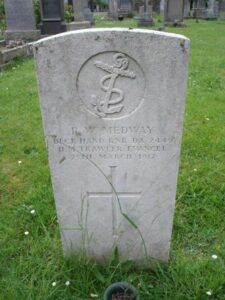
William Mends, Gunner, 76701, Royal Garrison Artillery. William was the son of John and Annie Mends, of Rickeston Bridge, Milford Haven. He was called up into the Royal Artillery on 12 April 1916, and was posted to France with the Royal Garrison Artillery on 15 May 1916. William was first attached to the 173rd Heavy Battery, then to the 201st Heavy Battery on 2 October 1916. On 7 June 1917 William was posted to the 142nd Durham Heavy Battery, which was at Ypres. He was 30 years old when he was killed in Action at Ypres on 26 September 1917, and is buried at Bard Cottage Cemetery, Belgium.
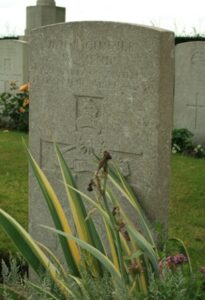
Edward Arthur Merchant, Signal Boy, 201SB, Royal Naval Reserve. Edward was born on 5 February 1900, the son of George and Lilly Merchant, of 13, Rudkin Street, Leicester, and served as Signal Boy aboard HM Trawler Evangel. He was drowned when Evangel struck a mine off St. Anne’s Head on 25 March 1917, and is commemorated on the Portsmouth Naval Memorial, Hampshire. Edward was just 17 years old.
Albert Ernest Miller, Telegraphist, J/25820, Royal Navy. Albert was born on 20 April 1898, the son of Harry and Catherine Stanton Miller, of 39, Ashton Street, Brighton. He was Telegraphist aboard HMS Prize, and was killed when Prize was sunk by U-48 in the Atlantic on 14 August 1917. Albert was 19 years old, and is commemorated on the Portsmouth Naval Memorial, Hampshire.
Maurice Miller, Gunner, 371383, Royal Garrison Artillery. Maurice was the son of Mr. and Mrs. George Miller, of 90, Charles Street, Milford Haven. He enlisted at Milford into the Royal Garrison Artillery, and joined their newly formed 68th Siege Battery. The Battery moved to France in March 1916, and fought through the Somme offensive. It then moved north to support the Battle of Arras, and it was at Arras that Maurice was killed on 30 April 1917. He was 21 years old, and is buried at Ste. Catherine British Cemetery, France.

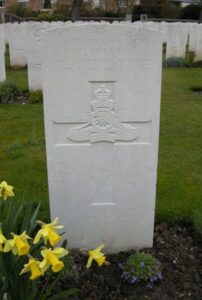
Albert Mills, Driver, W/4586, Royal Field Artillery. Albert was born at Milford on 29 August 1876, the son of Joseph and Anne Mills (nee Harries), of The Priory, Steynton. He was also the Grandson of Abraham Mills, the coxswain of the lifeboat ‘The Friendship’. Albert was known in the family as a ‘wild one’, and served in the Boer War. He was married, and had six children, but had left his family at Milford when he moved to the Rhondda to work as a Carpenter and Joiner at the Tram Depot in Porth. In 1913 his wife and six children moved to join him at Porth, and by the outbreak of the Great War another child was on its way. Albert volunteered for service in August 1914 and joined the Royal Field Artillery. He was posted to the Welsh Division, which was being formed in North Wales, and the following year his unit was renumbered A Battery, 121st Brigade, attached to the newly formed 38th (Welsh) Division. In December 1915 the division moved to France, taking up positions in the line in Flanders, and moved to the Somme in June 1916, and took part in the successful capture of Mametz Wood. Here it was so badly decimated that the division was sent to positions north of Ypres, at Boesinghe, where it was to remain for the next 12 months, until taking part in the successful Battle of Pilckem on 31 July 1917. During this time, Albert had undergone several spells of ‘Field Punishment Number One’, which involved him being bound to the wheel of an artillery limber for several hours a day. His reputation in his family was being held firm. Following the fighting at Pilckem Ridge, the division was moved to a quieter sector on the Lys to rest. It was here, on 25 September 1917 that Albert was to drown whilst bathing in the River Lys. He was 41 years old, and was buried at Erquinghem-Lys Churchyard Extension, France. Albert is not commemorated on the Milford Haven Memorial. (Details courtesy of his Granddaughter Ray Constance).
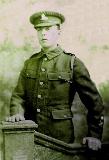
Hubert Ernest Mills, Engineman, 2504ES, Royal Naval Reserve. Hubert was born on 25 August 1877, the son of William and Jane Mills, of Hubberston. He lived prior to the war with his wife, Mary Mills, at Broadway, Little Haven. Hubert was a Royal Naval Reservist, and served during the Great War aboard HM Trawler Fulmar. Fulmar was a Grimsby-registered 231-ton vessel, which had been built in 1899 and hired in May 1915 by the Admiralty. She was sunk by a mine on 17 Jan 1916 in the Gulf of Sollum, with the loss of all hands. Hubert was 38 years old, and is commemorated on Panel 19 of the Plymouth Naval Memorial, Devon.
Joseph Mills, Trimmer, 2145TS, Royal Naval Reserve. Joseph was born at Great Yarmouth on 7 September 1888, the son of John and Esther Mills. He lived at Milford prior to the war, working as a trawlerman following some years of service in the Royal Navy, and was a member of the Royal Naval Reserve. He re-joined the colours at the outbreak of war and was posted aboard HM Trawler Star of Freedom. On 19 April 1917, Star of Freedom was on patrol off Trevose Head when she struck a mine which had been laid by the German submarine UC-47 and sank with the loss of ten men. Joseph was 27 years old and is commemorated on the Plymouth Naval Memorial, Devon. Another Milford man, Norton James, was also lost in the sinking. Joseph is not commemorated at Milford.
Joseph Mills, Private, 5892, Welsh Regiment. Joseph was the son of John and Jane Mills, of Woodland, Little Haven, and the Cousin of Albert Mills (above). He enlisted at Milford into the 4th Battalion, Welsh Regiment, but was later posted to the Labour Corps, with the army number 483046. Joseph died whilst on home service, on 15 November 1918. He was 31 years old, and is buried at Milford Haven Cemetery.
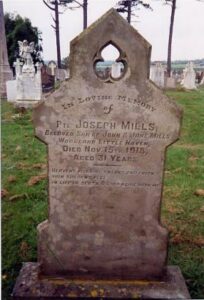
Frederick James Milne, Trimmer, 5906TS, Royal Naval Reserve. Frederick was born on 15 September 1890, the son of George and Helen Milne, of 46, College Bounds, Aberdeen, and served as Trimmer aboard HM Trawler Loch Eye. Frederick was killed when Loch Eye struck a mine off Dunmore, Southern Ireland, on 20 April 1917. He was 26 years old, and is commemorated on the Portsmouth Naval Memorial, Hampshire.
William Henry Miners, Skipper, 101SA, Royal Naval Reserve. William was born in Truro, Cornwall on 30 November 1882, the son of William and Alice Miners. He had lived at Milford for many years prior to the war, working as a fisherman, and had married Caroline Edwards in 1908, residing with his wife at 2, Marble Hall, Milford Haven. He served in the Merchant Fleet, but was attached to the Royal Naval Reserve, as Skipper aboard HM Trawler Norman II, which was taken over by the Admiralty in 1915 for use as a Minesweeper. William died of tubercular peritonitis at Stonehouse Naval Hospital, Plymouth on 18 April 1918, aged 35. He is buried at Ford Park Cemetery, Devon.
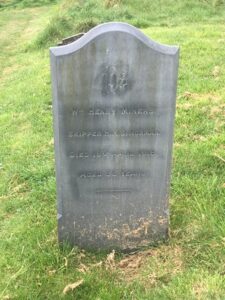
Robert Mitchell, Deck Hand, 3989DA, Royal Naval Reserve. Robert was born on 24 December 1893, the son of James and Mary Ann Watt Mitchell, of Lossiemouth, Morayshire. He served as Deck Hand aboard HM Drifter Ferndale. Robert drowned when Ferndale sunk on 27 December 1915. He was 25 years old, and is commemorated on the Portsmouth Naval Memorial, Hampshire.
Clifford William Moore, Leading Telegraphist, 35507, Royal Naval Reserve. Clifford was born at Neyland, and served with the Royal Naval Reserve, aboard HMS Apollo. Apollo was a second-class Apollo-class protected cruiser launched in 1891 and converted to a minelayer in 1909. They formed a mine-laying squadron from 1914 until 1915, when Apollo was disarmed and served in secondary roles. She was broken up in 1920. Nothing else is presently known of him.
Benjamin Lewis Morgan, Trimmer Cook, 1003TC, Royal Naval Reserve. Benjamin was born on 14 February 1880, the son of Rees David Morgan and Leah Morgan (nee Lewis), of 40, Louisa Street, Cardiff. He married Emily Polly Morgan at St. Mary’s, Cardiff on 26 April 1900. The couple lived at Louisa Street until war erupted, then after Benjamin enlisted into the Royal Naval Reserve on 2 June 1915, Emily went to live with her children at 90, Vale of Neath Road, Swansea. Benjamin was then posted to HMS Idaho, the shore establishment at Milford Haven, and joined the crew of HMS Prize. Benjamin was killed when Prize was sunk by U-48 on 14 August 1917. The 37-year-old has no known grave and is commemorated on the Plymouth Naval Memorial, Devon.
Arthur George Munning, Bombardier, 371111, Royal Garrison Artillery. Arthur was born in 1897, the son of Charles Alfred Munning and Hannah Harriet Munning (nee Durrant), of 173, Church Road, Gorleston, Norfolk. He had moved to 12, The Point, Hakin with his family prior to the war, due to his fathers work as a Ship’s Husband. Arthur enlisted at Milford into the locally raised Pembrokeshire Battery, Royal Garrison Artillery. He was posted to Dover where he joined the newly raised 68th Siege Battery, Royal Garrison Artillery. The battery embarked for France at the end of March 1916, and moved into positions in the Arras sector. The battery remained here until June 1916 when it transferred to the Somme sector, and supported the infantry attacks throughout the Somme offensive over the coming months. The battery moved back to the Arras sector the following spring and supported the Arras offensive, before moving to the Ypres Salient, to support the attacks on Passchendaele Ridge. By the spring of 1918 the battery was back on the Somme, and was amongst the units hit following the launching of the German Spring offensive of 21 March 1918. Arthur was killed in action on the Somme on 5 April 1918. The 21-year-old is buried in Ribemont Communal Cemetery Extension, Somme, France. A brother, William James Munning, died of wounds in June 1917. Many thanks to Joanne Rees for the photographs of the brothers.
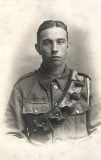
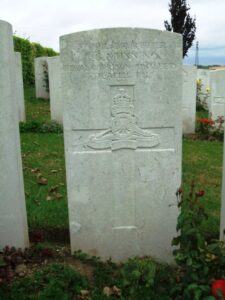
William James Munning, Deck Hand, 9838DA, Royal Navy. William was born on 6 May 1894, the son of Charles Alfred Munning and Hannah Harriet Munning (nee Durrant), of 173, Church Road, Gorleston, Norfolk. He had moved to 12, The Point, Hakin with his family prior to the war, due to his fathers work as a Ship’s Husband. William enlisted at Milford into the Royal Naval Reserve on 27 November 1915 and was posted to HMS Sabrina for training. William then served aboard HMS Nairana before receiving further training at HMS Vivid II, before being posted aboard the Paddle Minesweeper HMPMS Redcar, which was based at Dover. Redcar was on patrol off the Belgian coast when she struck a mine and sank on 24 June 1917. William was wounded, but rescued from the sea and was taken ashore at Dunkirk, where he died of his wounds in hospital the following day, 25 June 1917. The 23-year-old was buried in Dunkirk Town Cemetery, France. His younger brother Arthur was killed in 1918, while serving with 68th Siege Battery, RGA. Many thanks to Joanne Rees for the photographs of the brothers.

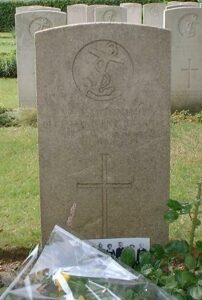
James Edward Murphy, Sailor, Mercantile Marine. James was born at Milford Haven in 1858, the son of Mary Jane Murphy (nee Pritchard). He served with the Merchant Navy aboard the SS Henley, a London registered steamer. On 10 April 1918, Henley was 25 miles from the Lizard, Cornwall, and en-route from Barry to St. Nazaire with a cargo of coal, when she was torpedoed without warning by the German submarine UB-109, and sunk with the loss of six lives, including James, who was 56. All six men are commemorated on the Tower Hill Memorial, London. James is not commemorated on the Milford Haven Memorial.
Richard Nichols, Private, 1822, Irish Guards. Richard was the son of George and Ellen Nichols, of Plymouth. He had worked at Milford Docks for several years prior to the war, residing at 25, Dartmouth Gardens, Milford Haven. Richard travelled to Waterford to enlist into the Irish Guards. At the outbreak of war, Richard was with their 1st Battalion, attached to 4th (Guards) Brigade, 2nd Division. One of the first Divisions to move to France, the 2nd Division remained on the Western Front throughout the war. They moved to Belgium, where they fought at the Battle of Mons, and retreating southwards, fought at the Affair of Landrecies, the Rearguard Actions of Villers-Cotterets, and at the Battle of the Marne where the German offensive was stopped. The Germans retreated north, and the BEF met them, fighting at the Battle of the Aisne. The 2nd Division were then moved to Flanders, where they fought at the First Battle of Ypres, when the German sweep through Flanders was stopped. Richard was killed at Ypres on 26 October 1914, aged 29. He is commemorated on the Ypres (Menin Gate) Memorial, Belgium.
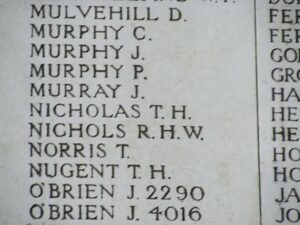
Willie John Nightingale, Ordinary Seaman, VR/3260, Royal Naval Canadian Volunteer Reserve. Willie was born on 23 March 1894, the son of William and Sarah Jane Nightingale (nee Ross), of Ontario, Canada. He served for the Royal Naval Canadian Volunteer Reserve aboard HM Trawler Loch Eye. He was killed when Loch Eye struck a mine off Dunmore, Ireland and sank on 20 April 1917. Willie was 22 years old, and is commemorated on the Halifax Memorial, Canada.
Frederick Charles Noakes, Private, 40718, Cheshire Regiment. Frederick was the son of David Noakes and Martha Noakes (nee Devonald), of 104, Charles Street, Milford Haven. He was conscripted in May 1916 and appealed, but lost his case, so on 12 December 1916 he attested at Milford into the Cheshire Regiment. He was sent to Carmarthen to undergo his medical before being sent to Kinmel Park for training. Frederick embarked for France on 27 March 1918 and was posted to the 9th Battalion, Cheshire Regiment, which was attached to 56 Brigade, 19th (Western) Division. The Battalion had just suffered terrible casualties during the opening phase of the German Spring offensive on the Somme when the Division was hit near Gaika Copse on 21 March 1918, before being forced into a fighting rear-guard action over the coming days. Frederick was among a large draft of reinforcements posted to the 9th Cheshire’s as the battalion rested and refitted at Ramillies Camp over the coming days. The battalion then moved to the Messines sector with the 19th Division, to hold a quieter sector of the line as rebuilding was completed. Unfortunately, the Germans launched the second phase of their offensive along the Lys Valley on 9 April 1918 and the 19th Division became caught up in desperate fighting once more. Frederick was fatally wounded by bullets in the neck and spine during heavy fighting near Nieppe on the following day, 10 April, and was evacuated via the 76th Field Ambulance to the 35th General Hospital at Calais for treatment, where he sadly died of his wounds on 16 April 1918, aged just 20. Frederick is buried at Les Baraques Military Cemetery, Sangatte, France.
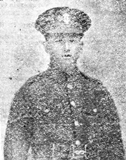
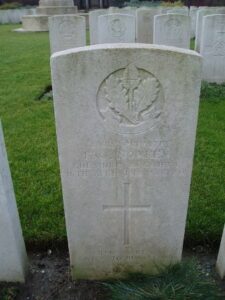
Reginald Norman, Private, 200616, Welsh Regiment. Reginald was the son of Samuel and Elizabeth Norman, of 13, Ingate Street, Beccles, Suffolk. He lived at Milton prior to the war, and enlisted at Fort Hubberston into the 1/4th Battalion, Welsh Regiment, the local Territorial unit. The battalion formed part of 159 Brigade, 53rd (Welsh) Division, and landed on Gallipoli in August 1915, remaining there until the evacuation. It then fought in Egypt, and took part in the advance into Palestine in March 1917, remaining there for the duration of war. Reginald was wounded soon after the Division had taken part in the capture of Jerusalem, and died of his wounds on 3 January 1918. He was 19 years old, and is buried at Kantara War Memorial Cemetery, Egypt.
John Northcott, Second Hand, 1244SA, Royal Naval Reserve. John was born on 3 March 1864 and was the husband of Mary Jane Northcott, of 42, Bolton Street, Brixham, Devon. He served as Second Hand aboard HM Trawler Evangel, and was killed when she struck a mine off St. Anne’s Head on 25 March 1917. John is commemorated on the Plymouth Naval Memorial, Devon. He was 51 years of age.
John Patrick O’Loughlin, Bombardier, 51134, Royal Field Artillery. John was born in Clare, Ireland, and was the son of Joseph and Margaret O’Loughlin, who moved the family to Telegraph Cottage, Milford Haven. John was an early enlistee into the Royal Field Artillery, and was posted to their 46th Brigade, which was attached to the 14th (Light) Division. The Division was to see its first action during the Action of Hooge, where the Division were the first to be attacked by the German use of flamethrowers. They then fought at the Second attack on Bellewaarde. John had barely been in France for a few weeks when he was killed on 25 April 1915. He was 21 years old, and is buried at Vieille-Chappelle New Military Cemetery, Lacoutre, France.
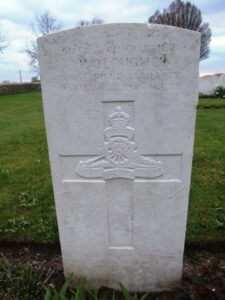
William Digby Oswald, DSO, Lieutenant Colonel, 5th Dragoon Guards. William was born on 20 January 1880, the son of Thomas Ridley Oswald and Wilhelmina Catherine Oswald. The family then moved to Castle Hill, Milford Haven. William was educated at Clifton and Lancing Colleges, before on 29 March 1898 was commissioned into the 6th Battalion, Lancashire Fusiliers. He served during the Boer War of 1899 to 1902, and was awarded the Distinguished Service Order for his work. He married Catherine Mary Yardley on 7 March 1905, and the couple lived at St. Winning, Weymouth, where they had three daughters. At the outbreak of war, he was posted to the 5th Dragoon Guards, and landed in France on 7 August 1914. He was wounded at Messines in October 1914, and after recovering was briefly attached to the Royal Field Artillery before becoming second in command of the 12th Battalion, West Yorkshire Regiment. William was wounded by shell fragments during his battalion’s attack on Caterpillar Valley during the Battle of the Somme, on 15 July 1916, and died on the following day, aged 36. He is buried in Dive Copse British Cemetery, Sailly-le-Sec, France. William does not appear to be commemorated locally, but is commemorated at Southampton and Lancing College.
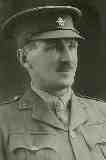
Alfred George Owen, Private, 534892, London Regiment. Alfred was the son of William John Owen and Mary Ann Owen, of Parkhurst, 20, Waterloo Road. He worked as an Income Tax Clerk at Cardiff prior to the war, and enlisted there into the 2/15th Battalion (Prince of Wales Own Civil Service Rifles), London Regiment, which formed part of 179 Brigade, 60th (2/2nd London) Division. The Division fought in Salonika for much of the war, but on 30 May 1918 Alfred’s Battalion left the Division and moved to France, arriving at Audruicq by 22 June, and joining 90 Brigade, 30th Division, which had been decimated during the German Spring Offensives. In August the Allies gained a huge victory over the Germans at Villers Brettoneux on the Somme, and from then on, they were on the offensive. The 30th Division took part in the Advance in Flanders, which is where Alfred was killed on 3 October 1918. He was 21 years old, and is commemorated on the Tyne Cot Memorial, Belgium.
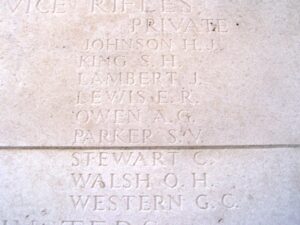
James Owen, Gunner, 371069, Royal Garrison Artillery. James was born at Steynton, the son of John and Mary Ann Owen. He worked as a mason prior to enlisting at Milford into the Royal Garrison Artillery, joining the 68th Siege Battery. The Battery landed in France on 31 March 1916, and took part in the Somme Battles, before moving to the Arras Sector. James was killed during the Battle of Arras on 30 April 1917, aged 23. He is buried at Ste. Catherine British Cemetery, France.
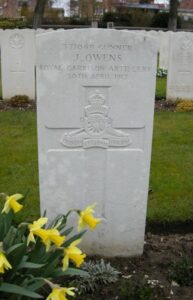
Charles Picton Owens, Engineman, 4846ES, Royal Naval Reserve. Charles was born on 1 March 1890, the son of Thomas and Anne Owens, of 40 Prendergast, Haverfordwest. Prior to the war he resided with his wife Lilian Owens, at 12, City Road, Haverfordwest. He served as Engineman aboard HM Drifter Active III, and was drowned when she struck a mine off St. Anne’s Head on 15 October 1917. Charles was 27 years old and is commemorated on the Plymouth Naval Memorial, Devon.
Frederick Albert Owens, Able Seaman, Wales/Z/58, Royal Naval Volunteer Reserve. Frederick was born on 20 August 1896, the son of Thomas and Elsie Owens, of 62, Cellar Hill, Pill, Milford Haven. He served as Able Seaman aboard HMS Queen Mary, which was a Lion Class battlecruiser. Upon commissioning, she joined the 1st Battlecruiser Squadron. On 28 August 1914, she took part in the 1st Battle of Heligoland Bight. She was under refit at the time of the Dogger Bank battle, so she did not take part in that engagement, and after completing her refit, she re-joined the 1st Battlecruiser Squadron. Frederick was killed when Queen Mary was sunk by heavy German gunfire which exploded her magazines, at the Battle of Jutland, on 31 May 1916. He was just 19 years old and is commemorated on the Plymouth Naval Memorial, Devon.
Henry Paxton Palmer, Pioneer, 46356, Royal Engineers. Henry was born on 8 May 1897, the son of Robert Paxton Palmer and Amelia Palmer, of 8, Bridge Street, Hakin. He enlisted at Milford into the Royal Engineers and was posted to their 23rd Signal Company, which was attached to the 1st Division. The Division saw action during the epic retreat from Mons, and at First Ypres during 1914. In 1915 it fought at Loos, and was on the Somme in 1916. In the spring of 1917 the Division moved to Flanders, and it was here that Henry was killed on 27 May 1917. He was 20 years old, and is buried at Railway Dugouts Burial Ground, Belgium.
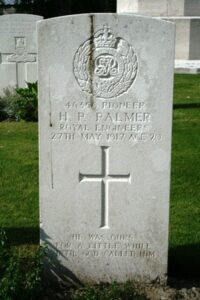
William Walter Payne, Engineman, 331ES, Royal Naval Reserve. William was born on 21 April 1881, the son of Frank Payne, of Bristol. He married Edith Matilda Owens in 1906, and the couple resided at 5, Priory Terrace, Milford Haven, with their three children. William was serving as Engineman aboard HM Trawler Apley, when she struck a mine off the Isle of Wight on 6 December 1917 and sank with all hands. William was 35 years old and is commemorated on the Plymouth Naval Memorial, Devon.
Robert Frank Peel, Trimmer, 2136TS, Royal Naval Reserve. Robert was born on 9 August 1875, the son of Peter and Johanna Peel, of Great Yarmouth. He was the husband of Sophie Peel, of 29, Well Street, Great Yarmouth. He served as Trimmer aboard HM Trawler Loch Shiel, and was killed when she blew up and sank off St. Anne’s Head on 26 September 1916. Robert was 41 years old and is commemorated on the Plymouth Naval Memorial, Devon.
William George Woodrow Pengelly, Leading Seaman, 5236B, Royal Naval Reserve. William was born on 29 October 1881, and was the husband of Sophie Pengelly, of Church End, East Looe, Cornwall. He served aboard HM Trawler Nodzu. William was killed during an accident aboard Nodzu on 13 April 1917 when she was based at Milford. He was 35 years old, and was buried at St. Martin-By-Looe (St. Martin of Tours) Churchyard, Cornwall.
George Albert Perrin, Deck Hand, 3940SD, Royal Naval Reserve. George was born at Milford on 16 February 1893, the son of Florence Perrin. The family had residing at Sculcoates, Yorkshire and then at Cardiff prior to the war and George served aboard HM Trawler Eider. He died on 14 March 1917 aged 24 and is buried at Tynemouth (Preston) Cemetery.
William Martin Peterson, Corporal, 3772, London Regiment. William was the son of John and Mary Peterson, of Milford Haven. He enlisted at Milford into the Army, and was posted to the 14th Battalion (London Scottish), London Regiment, attached to 168 Brigade, 56th (London) Division. The Division were on the Somme in 1916, and fought at the diversionary attack on Gommecourt then at Ginchy, Flers and Morval, where they captured Combles. William was killed on the Somme on 22 October 1916. He was 26 years old, and is buried at Maroeuil British Cemetery, France.
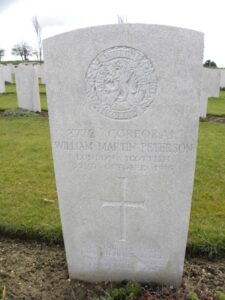
James Charles Phillips, Skipper, Royal Naval Reserve. James was the son of Lewis and Sarah Phillips, of 15, Chapel Street, Milford Haven. He lived with his wife Annie Phillips at 186, Robert Street, Milford Haven prior to the war. James served as Skipper aboard HM Trawler Lydian, and was killed when she struck a mine and sank off South Foreland on 15 September 1915. James was 31 years old and is buried at Milford Haven Cemetery.
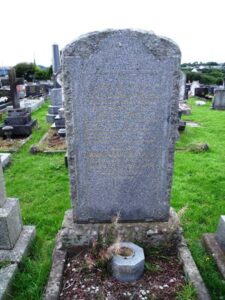
William Richard Picton, Deck Hand, 14850DA, Royal Naval Reserve. William was born on 23 July 1889, the son of Richard William Picton of Milford Haven. He was the husband of Florence Mary Picton, of 14, Clarence Street, Pembroke Dock. He served as Deck hand aboard HM Drifter Active III, and was killed when she sank after striking a mine off Milford Haven on 15 October 1917. William was 28 years old and is commemorated on the Plymouth Naval Memorial, Devon.
Robert Fiddes Pirrie, Deck Hand, 12025DA, Royal Naval Reserve. Robert was the son of William and Margaret Pirrie, of 21, Shorehead, Stonehaven, and the husband of Jane Pirrie, of 72, High Street, Stonehaven. He was a salmon fisherman prior to the war. Robert served as Deck Hand aboard HM Trawler Loch Eye, and was drowned when Loch Eye struck a mine and sank off Dunmore, Ireland, on 20 April 1917. Robert was 36 years old, and is buried at Dunnottar Cemetery, Stonehaven, Scotland.
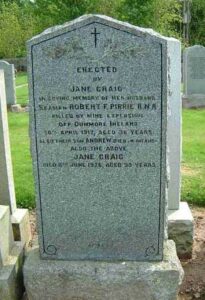
Henry Herbert Portch, Lieutenant, Royal Navy. Henry was the son of Samuel Henry and Sarah Elizabeth Portch. He served aboard the Q-Ship HMS Prize, and was killed when Prize was destroyed by U-48 on 14 August 1917. Henry was 34 years old and is commemorated on the Plymouth Naval Memorial, Devon.
Walter Bartholomew Potter, Able Seaman, Royal Naval Reserve. Walter was the son of Charles and Annie Potter, of Wilton, Wiltshire. For several years prior to the war he had resided with his wife Ethel Mary Potter, at 4, Brick House, Pill, Milford Haven. Walter served with the Royal Naval Reserve, aboard the S.S. Duckbridge, a Newcastle registered merchant steamer. On 22 February 1916 Duckbridge was on route with a cargo of Welsh steam coal for the British fleet from Cardiff to the Orkneys, when she struck a mine and sank off Straithie Point. Walter was 34 years old when he died that day, and is commemorated on the Tower Hill Memorial, London.
Cyril Powell, Gunner, 371234, Royal Garrison Artillery. Cyril was the son of George and Sarah Powell, of 184, Robert Street, Milford Haven. He enlisted at Milford into the Royal Garrison Artillery, and joined its 354th Siege Battery. The Battery landed in France on 22 May 1917, and fought at Third Ypres later that year. It was on the Somme by the summer of 1918, and was supporting the Australian and Canadian offensive near Villers Brettoneux when Cyril was killed on 11 August 1918. He was 19 years old, and is buried at Heath Cemetery, Harbonnieres, France.
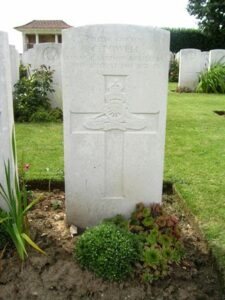
Josiah Pratt, Skipper, Royal Naval Reserve. Josiah was the son of Thomas and Mary Ann Pratt, of Sculcoates, Yorkshire and the brother-in-law of Susan Mary Pratt, of 4, Milton Terrace, Pill, Milford Haven. He served as Skipper aboard HM Trawler Lobelia II, and was killed when she struck a mine off Lough Swilly on 19 April 1917. Josiah was 48 years old, and is commemorated on the Plymouth Naval Memorial, Devon.
Patrick Quinn, Lance Corporal, 6827, Royal Irish Rifles. Patrick was the son of Thomas and Catherine Quinn, of 17, Great North Road, Milford. He enlisted at Haverfordwest into the Army, and joined the 2nd Battalion, Royal Irish Rifles, which was attached to 74 Brigade, 25th Division. The Division landed in France on 26 September, 1915, and were posted to the Vimy area, where they defended Vimy Ridge against a German attack in May 1916. They then moved to the Warloy area and attacked on 3 July near Thiepval. Patrick was killed near Thiepval on 9 July 1916, aged 35. He is one of the 74,000 missing of the Battle of the Somme, and is commemorated on the Thiepval Memorial, France.
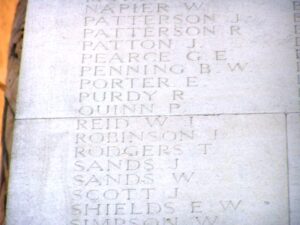
William Rackley, Mate, Mercantile Marine. William was the son of John and Elizabeth Rackley, of Brixham, Devon. He married Susan Avery Michelmore in 1883, but she sadly died just three years later. William had served at sea for many years prior to moving to Milford by 1911. When war was declared William was posted aboard the Brixham registered Fishing Vessel Friendship, which was owned by Tom Jenkerson of Milford. On 13 February 1917 Friendship was working off The Smalls when she was captured by the German submarine UC-65, and the crew of four took to the life raft. They were never picked up, and the Friendship was scuttled. William was 57 years old when he died and is commemorated on the Tower Hill Memorial, London.
Archibald Radmore, Skipper, Royal Naval Reserve. Archibald was born on 7 August 1875, the son of George and Louisa Radmore of Milford Haven. He had married Jane Maria Knight at Milford in 1900, after the death of his first wife Helen. Archibald served as Skipper aboard HM Trawler Blacklyn, which had been converted for minesweeping duties. Archibald died aboard Blacklyn when she struck a mine, which had been laid by the German submarine UC1, and blew in half on 11 May 1917. He was 41 years old and is buried at Lowestoft (Beccles Road) Cemetery.
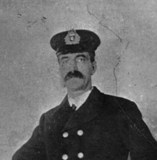
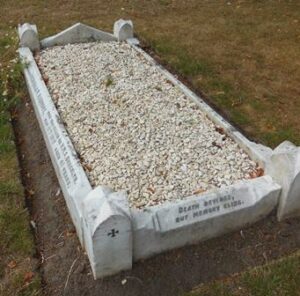
Charles Ralph, Trimmer, TS/2041, Royal Naval Reserve. Charles was born on 26 September 1897, the son of Charles Ralph and Jane McLeod Ralph, of 13, John Street, Lossiemouth, Morayshire. Charles served as Trimmer aboard HM Drifter Ferndale, and drowned when she was sunk on 21 December 1915. Charles was just 17 years old, and is buried at Milford Haven Cemetery.
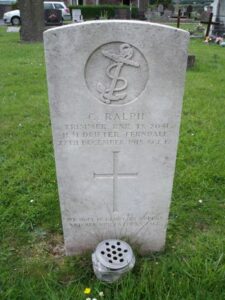
Thomas Ravey, Deck Hand, 2513SD, Royal Naval Reserve. Thomas was born in 18 August 1869 and was the husband of Janet Ravey, of, 11B Sloop St, Barrow-in-Furness. Thomas was a crewman aboard the Q-Ship HMS Prize. He was killed when she was sunk by U-48 on 14 August 1917. He was 47 years old and is commemorated on the Chatham Naval Memorial, Kent.
Henry Brynmor Raymond, DCM, Sergeant, 8997, Royal Field Artillery. Henry was the son of George and Esther Raymond, of Milford Haven. He enlisted at Bournemouth into the Royal Field Artillery, and served in France with their 72nd Army Brigade. Henry was obviously a brave and efficient soldier. He was awarded the Distinguished Conduct Medal, which was gazetted on 13 February 1917, ‘For conspicuous devotion to duty. He has rendered very valuable services throughout, and by his devotion to duty has shown a fine example to all ranks.’ Henry died on 28 October 1918, aged 32, and is buried at Cambrai East Military Cemetery, France. Henry is not commemorated on the Milford Haven Memorial.
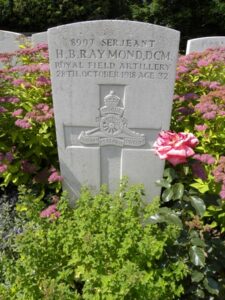
Henry James Revell, Deck Hand, 8061DA, Royal Naval Reserve. Henry was born on 21 July 1897, the son of John Revell, of 10, Avondale Road, Lowestoft, Suffolk. He served as one of the crewmen aboard the Q-Ship HMS Prize. Henry was killed when Prize was destroyed by U-48 on 14 August 1917. He was 20 years old and is commemorated on the Chatham Naval Memorial, Kent.
William Richards, Petty Officer Stoker, K/4163, Royal Navy. William was born on 18 November 1890, the son of Edmund Maline Richards and Susan Richards, of 2, Oak Villas, West End, Lower Richmond Road, Mortlake, Surrey. He served aboard HMS P.60, which was another of the Milford based Q-Ships, and died when a depth charge exploded whilst P60 was attacking a German submarine on 4 January 1918. William was 27 years old and is buried at Pembroke Dock (Llanion) Cemetery.
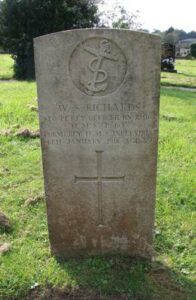
James Rimmer, Deck Hand, 8735DA, Royal Naval Reserve. James was born in Fleetwood on 11 April 1883, the son of Thomas Rimmer (a fisherman), and the stepson of Margaret Alice Rimmer (nee Greenish). He was married to Sarah Alice Rimmer (nee Scotton), and had five children; William F, Mildred, Mary Ellen, Eva D and Agnes A, who all lived in 12, Prospect Place, Milford Haven. James served aboard HM Drifter Pearl III, which was a hired net drifter, which was active in the Gallipoli Campaign. James died on active service on 17 December 1915, and is commemorated on the Plymouth Naval Memorial, Devon. Many thanks to Sian Moran for the information.
Alexander Ritchie, Deck Hand, 5926DA, Royal Naval Reserve. Alexander was born in Banffshire on 13 March 1869, but lived at 37, Waterloo Road, Hakin with his wife Jessie while serving at HMS Idaho, the base at Milford. He served as Deck Hand aboard H.M. Drifter Barbara Cowie, which had been converted for minesweeping duties. Alexander took ill while at sea and was taken ashore to a hospital at Blackwater, Ireland, where he died on 4 October 1916 aged 47. He is buried in Blackwater (Killila) Graveyard, Ireland. His widow Jessie returned to her native Scotland.
James David Rees Roberts, Petty Officer 2nd Class, 147492, Royal Navy. James was born on 9 March 1873, the son of David and Emma Roberts of Hubberston. He was the husband of Mary Roberts, of 41, Shakespeare Avenue, Milford Haven. James was a long serving regular in the Royal Navy, being awarded the China Medal, for the 1900 campaign, and was the holder of the Long Service and Good Conduct Medal. James was posted to HMS Laurentic during the Great War, and was sadly among the men drowned when she struck a mine of the North Irish coast on 25 January 1917. He was 43 years old, and is commemorated on the Plymouth Naval Memorial, Devon.
Henry Rooke, Skipper, Royal Naval Reserve. Henry was born in Cardiff on 1 May 1890. He probably moved to Milford to work as a fisherman and in 1913 married Mary Elizabeth Devonald, of 35, Dartmouth Street, Milford Haven. He served aboard HM Trawler Dragon II during the war. Henry took ill and died of influenza and pneumonia on 8 October 1918 whilst at Dublin. He is buried at Dean’s Grange Cemetery, Dublin.
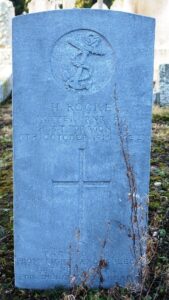
George Joseph Rudge, Cook, Mercantile Marine. George was the son of Joseph and Susan Rudge of Hull. He resided at Milford prior to the war with his second wife, Annie Rudge (nee Lawson). George served as Cook aboard the Steam Trawler Victoria, a Fleetwood registered vessel. He was killed on 1 June 1915 when Victoria was attacked and shelled by a German U-Boat. George was 56 years old and is commemorated on the Tower Hill Memorial, London.
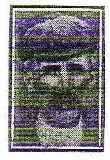
Wilfred John Salisbury, Telegraphist, Bristol/Z/9620, Royal Naval Volunteer Reserve. Wilfred was born on 21 April 1898, the son of Edwin and Emma Salisbury, of 17, Clifton Road, Rugby. He served as Telegraphist aboard HM Trawler Evangel, and was drowned when she was sunk off Milford, with all hands, on 25 March 1917. Wilfred was 18 years old and is commemorated on the Plymouth Naval Memorial, Devon.
William Edward Sanders, VC, DSO, Lieutenant Commander, Royal Naval Reserve. William was the son of Edward Helman Cooke Sanders and Emma Jane Sanders, of Russell, Bay of Islands, New Zealand. He had worked his way swiftly through the ranks of the Mercantile Marine at an early age, and held the Extra Master’s Certificate, before serving with the RNR, aboard various Q-Ships based at Milford. His story is told in more detail on the Pembrokeshire Heroes page of this site, but William had gained the Victoria Cross and Distinguished Service Medal by the time of his death, when his Q-Ship, HMS Prize was sunk by the German submarine U-48 on 14 August 1917. William was 34 years old, and is commemorated on the Plymouth Naval Memorial, Devon.
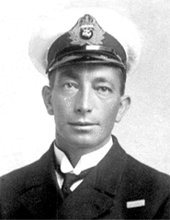
Frederick George Scotton, Sergeant, 32653, Royal Garrison Artillery. Frederick was the son of George Henry and Elizabeth Jane Scotton (nee Summons), of Marble Hall Terrace, Milford Haven. He enlisted at Milford into the newly formed 137th Siege Battery. Royal Garrison Artillery. The battery moved to France during August 1916, at the height of the Somme offensive. It is not known what happened to Frederick, but he died during the time of the Battle of Arras, on 26 April 1917 in Hospital at Etaples. He was 29 years old and buried at the vast Étaples Military Cemetery, France.
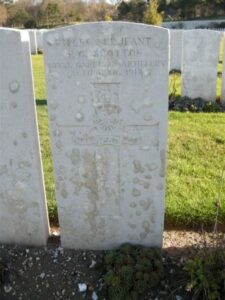
William Albert Shoebottom, Trimmer Cook, 500TC, Royal Naval Reserve. William was born on 5 November 1881, the son of William and Harriett Shoebottom, of Birmingham. He worked as a fisherman at Milford for several years prior to the war and resided with his wife Helen Shoebottom, at 6, Wellington Avenue, Hakin, Milford Haven. He served as Trimmer Cook aboard HM Trawler Merse, and was killed when she struck a mine of the West Coast of Scotland on 22 May 1917. William was 35 years old, and is commemorated on the Plymouth Naval Memorial, Devon.
Daniel John Smith, Bombardier, 25374, Royal Garrison Artillery. Daniel was the son of Herbert and Elizabeth Smith, of Matson Lane, Gloucester. He had been based with the Royal Artillery in Pembrokeshire for several years prior to the war, marrying Margaret Alice McKay, of 10, Priory Villa, Milford Haven in 1912. Daniel moved to France attached to the 95th Siege Battery, Royal Garrison Artillery. Daniel was killed soon after arriving in France, during the Battle of the Somme on 31 July 1916. He was 26 years old, and is buried at Bronfay Farm Military Cemetery, Bray Sur Somme, France.
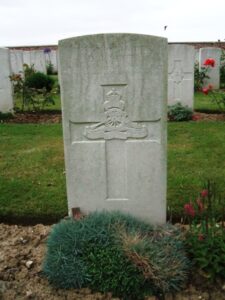
Ernest Smith, Private, 44669, Welsh Regiment. Ernest was the son of James and Almenia Smith, of 18, Trafalgar Road, Milford Haven. He worked at Cardiff prior to the war and married Christina Annie Clarke on 24 May 1916. Ernest joined the Welsh Regiment at Cardiff, and was posted to the 12th Welsh at Kinmel Park. He was then posted to the 11th Battalion, Welsh Regiment, which was called the Cardiff Pals, and was part of 67 Brigade, 22nd Division. The Division crossed to France in early September 1915, with all units being concentrated near Flesselles by 9 September. However, it’s stay in France was to be very short, as on 27 October 1915 the Division, having been moved by train to Marseilles, began to embark for Salonika. It completed concentration there in November, although the final artillery units were still coming in as late as 13 December 1915. It remained in the theatre for the rest of the war, taking part in the Retreat from Serbia during December, 1915. Between 10 to 18 August 1916 they fought at the battle of Horseshoe Hill, then between 13 to 14 September 1916 at the battle of Machukovo. Between 24-25 April and 8-9 May 1917, the Division fought at the battle of Doiran, and then on 18 September 1918 at the Second Battle of Doiran. Ernest died of wounds suffered at Doiran on 28 September 1918 aged 23. He is buried at Mikra British Cemetery, Kalamaria. His widow remarried, and became Mrs. C. A. Haselgrove-Spurin, of Old Post Office, Taffswell, Cardiff.
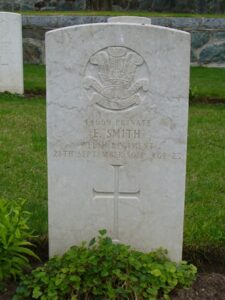
Harry James Smith, Second Hand, 1231SA, Royal Naval Reserve. Harry was born on 4 July 1891, the son of Edward Smith, of 15, New Street, Plymouth. He resided with his wife Frances Maria Smith at 12, Vicarage Street, Pill, Milford Haven. Harry served aboard HM Trawler Senator, and was killed when she struck a mine off the North coast of Ireland on 21 May 1917. Harry was 26 years old, and is commemorated on the Plymouth Naval Memorial, Devon.
Robert Strachan Smith, Engineman, 2298ES, Royal Naval Reserve. Robert was born on 23 July 1895, the son of Walter and Helen Smith, of 100, Bon-accord Street, Aberdeen. He served aboard HM Drifter Ferndale, and was drowned when she was lost with all hands-on 27 December 1915. Robert was 20 years old, and is commemorated on the Portsmouth Naval Memorial, Hampshire.
Frederick Charles Smy, Private, 24163, Dorsetshire Regiment. Frederick was born at Milford Haven, the son of James and Bertha Smy. The family later moved to Plymouth, where Frederick lived with his wife Lily. Frederick enlisted at Plymouth into the army, and was posted to the 6th Battalion, Dorsetshire Regiment, which was attached to 50 Brigade, 17th (Northern) Division. During July 1915 the Division landed in France, and moved to the southern area of the Ypres salient. Here they took part in fighting at the Bluff during February 1916 before moving south, where they fought at the Battle of Albert, where the Division captured Fricourt at heavy cost during the opening of the Somme Offensive. They then saw action during the Battle of Arras, at the First and Second Battles of the Scarpe and the Capture of Roeux, before moving back to Ypres, and taking part in the First and Second Battles of Passchendaele. In March 1918 the Division were on the Somme, and faced the German Spring Offensive there, and took part in fierce fighting over the coming days. Frederick was killed on the Somme on 1 April 1918. He was 31 years old, and is buried at Ribemont Communal Cemetery Extension, Somme, France. Frederick is not commemorated on the Milford Haven Memorial, but is commemorated at St. Charles’s Church, Plymouth.
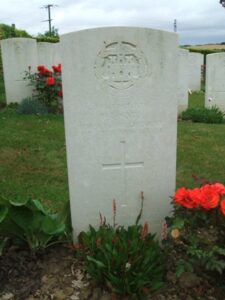
Benjamin Arthur James Stanfield, Deck Hand, 2767DA, Royal Naval Reserve. Benjamin was born on 17 February 1899, the son of James and Mary A. Stanfield, of 34, St. Annes Road, Hakin, Milford Haven. He served aboard HM Trawler Evangel, and was killed when she struck a mine in the English Channel on 25 March 1917 and was lost with all hands. Benjamin was 18 years old, and is commemorated on the Plymouth Naval Memorial, Devon.
George Stephenson, Private, 59073, West Yorkshire Regiment. George was the son of George and Sarah B. Stephenson, of Murray Road, Pill, Milford Haven. He was working in the fish market when he enlisted into the army in April 1917 and was posted to the 1/5th Battalion, West Yorkshire Regiment which was attached to 146 Brigade, 49th (West Riding) Division. The Division had been in France since April 1915 and had fought on the Somme that year, and at Passchendaele in 1917. The Division remained in Flanders over the final winter of the war, and it was here that they met the brunt of the German attacks on the Lys in April 1918. George was killed in action here on 22 April 1918. He was 19 Years old and is commemorated on the Tyne Cot Memorial, Belgium. George is not commemorated on the Milford Memorial as his family was originally from Grimsby, and moved back there after the war.
John James (Stevo) Stevenson, Skipper, Mercantile Marine. John was known locally as Stevo. He was the husband of Minnie Stevenson (nee Gray), and resided at 32, St. Anne’s Road, Hakin. Stevo was the Skipper of the Steam Trawler Victoria, a Fleetwood registered vessel. He was killed on 1 June 1915 when Victoria was attacked and shelled by a German U-Boat. Stevo was 39 years old and is commemorated on the Tower Hill Memorial, London.
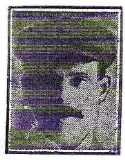
Walter Percy Stobart, Mechanician, MB/1991, Royal Naval Volunteer Reserve. Walter was born on 6 June 1885, the son of Theodore Cuthbert Stobart and Emily Stobart, of 6, Minstead Road, Gravelly Hill, Birmingham. He was the husband of Rose E. Stobart (nee Lee), of Penn’s Lane, Erdington, Birmingham. Walter served as Mechanician aboard HMS Prize, and was killed when she was sunk by U-48 on 14 August 1917. Walter was 31 years old and is commemorated on the Portsmouth Naval Memorial, Hampshire.
Hugh Adrian Innys Blyth Stokes, MC, Second Lieutenant, Ox and Bucks Light Infantry. Hugh was born at Milford Haven in 1894, the son of Hugh Innys Stokes and Kate May Stokes. The family then moved to 46, Baker Street, London. Hugh originally enlisted into the 10th Battalion, Royal Fusiliers, and landed in France on 31 July 1915. He was commissioned into the 3rd Battalion, Ox and Bucks Light Infantry on 30 October 1917, before being posted to their 2nd Battalion, which was attached to 5 Brigade, 2nd Division. The Division had been in France since the outbreak of war, and Hugh joined them in time for the Battle of Cambrai. They were still in the area when the Germans launched their Spring Offensive on 21 March 1918, and were caught up in the terrible fighting which ensued. In August they took part in the launching of the great offensive, and took part in the great offensive which was to ultimately win the war. On 1 October 1918, Hugh was badly wounded while leading his company. His gallantry earned him the Military Cross, the citation of which tells the tale; ‘While forming up for the attack near Rumilly on October 1st, 1918, he was wounded but remained with his platoon and advanced with it to the attack. Under very heavy rifle and machine-gun fire from three sides he reorganised his men into groups, thereby avoiding many casualties and enabling the advance to proceed. Later, when further advance became impossible, he, though wounded a second time, stayed and encouraged his men until every other wounded man had been got away. He showed great courage and devotion to duty.’ Hugh was evacuated back to Britain, but died of his wounds on 28 November 1918, aged 24. He is buried at Brookwood Military Cemetery, England. Hugh is not commemorated on the Milford Haven Memorial.
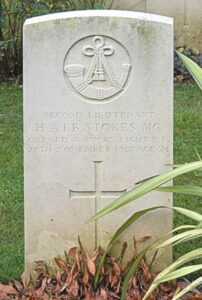
Sidney Stratford, Deck Hand, 2929DA, Royal Naval Reserve. Sidney was born at Grimsby on 7 November 1888, the of Sidney Daniel and Annie Eliza Stratford. The couple had moved to Hubberston by 1891, and Sidney later became a fisherman. During the war he served aboard HM Trawler Lobelia II, and was drowned when she sank on 19 April 1917. He was 28 years old and is commemorated on the Plymouth Naval Memorial, Devon.
William Edward Sweeny, Private, 14758, Machine Gun Corps. William was the son of Thomas and Edith Sweeny, of Marble Hall Terrace, Hakin. He married in 1907 and lived with his wife Eveline Sweeny at 56, Cambrian Road, Neyland. William had served overseas with the Machine Gun Corps, but had been gassed at Loos, returning home for hospital treatment. William died at Milford as a result of being gassed on 10 April 1917, aged 31. He is buried at Milford Haven Cemetery.
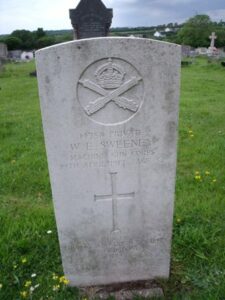
Arthur Laing Tait, Deck Hand, 1142SD, Royal Naval Reserve. Arthur was born on 11 December 1894 at Lerwick, the son of Andrew and Mary Tait. He was the husband of Mabel Tait, of 2, Marshall Place, Blackhall, Edinburgh. Arthur served aboard HM Trawler Emley. He drowned when she was lost, with all hands, on 28 April 1918. Arthur was 23 years old and is commemorated on the Portsmouth Naval Memorial, Hampshire.
Robert Tarraway, Petty Officer, 153498, Royal Navy. Robert was born on 29 March 1875, the son of Harry Tarraway. He was the husband of Lillie Tarraway, of 31, Blight’s Row, Redruth, Cornwall. Robert was among the crewmen of HMS Prize, and was killed when she was sunk by U-48 on 14 August 1917. Robert was 41 years old, and is commemorated on the Plymouth Naval Memorial, Devon.
Thomas Vaux Taylor, Skipper, Royal Naval Reserve. Thomas was born at Aberdeen on 30 October 1886. He was probably a fisherman based at Milford prior to the war, and in 1909 he married Emily Gwendoline Pettit. He served as Skipper of HM Trawler Stelma, which was based in Dorset. Thomas suffered an accident soon after the war, falling and breaking his spine, and died in hospital at Portland on 3 February 1919, aged 32. He is buried at Portland Royal Naval Cemetery, Dorset.
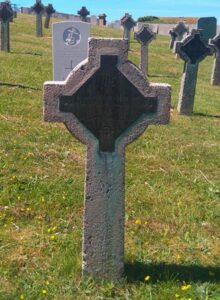
James William Terry, Private, 23837, 4th Queens Own Hussars. James was the son of James William Terry and Ann Terry, of Shipston-on-Stour, Worcs. He enlisted into the 4th Hussars on 3 January 1890, and served in the Chitral and in the South African Campaigns, before being discharged in June 1902 after completing his period of engagement. He had married Elizabeth Hudson whilst on leave in 1897, and the couple had seven children by the time of the outbreak of the Great War. James rejoined the colours, and was posted to his old regiment, the 4th Queens Own Hussars. He was based at Milford for a while, moving his family there, until being posted overseas in 1916. James died of dysentery in Tanzania on 27 February 1917, aged 47 (51 on CWGC), and is buried in Dar Es Salaam War Cemetery, Tanzania. His widow later married James Perry, of 5, Charles Street, Milford Haven. The photograph is courtesy of Harry Fecitt. James is not commemorated locally.
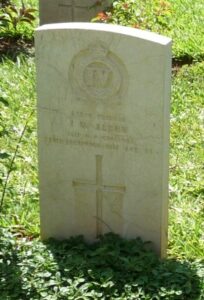
Tom Thacker, Deck Hand, 8060DA, Royal Naval Reserve. Tom was born on 9 March 1897, the son of Thomas and Jane Thacker, of White Horse Corner, Carlton Colville, Suffolk. He was another of the crewmen aboard the Q-Ship HMS Prize, and was killed when she was sunk by U-48 on 14 August 1917. Tom was 19 years old, and is commemorated on the Chatham Naval Memorial.
Albert James Thomas, Private, 26567, Royal Fusiliers. Albert was the son of Arthur and Mary Thomas, of 27, Priory Road, Milford Haven, and enlisted at Milford into the Army. Albert was posted to the 7th Battalion, Royal Fusiliers, part of 190 Brigade, 63rd (Royal Naval) Division. The Naval Brigades were originally sent to Antwerp and Dunkirk in September and October, 1914 to guard against invasion by the Germans. However, Antwerp fell to the Germans soon after, and so many of the RND units were withdrawn to England. After a lengthy period of refit and training the Division moved to Egypt preparatory to the Gallipoli campaign. Landing on 25 April 1915, the Division fought throughout the Campaign on Gallipoli. They were transferred from the authority of the Admiralty to the War Office on 29 April 1916, and was re-designated the 63rd (Royal Naval) Division on 19 July 1916. The Division moved to France, arriving at Marseilles between 12 and 23 May 1916 and moved to positions on the Somme, where it took part in the Battle of the Ancre, which is where Albert was killed on 13 November 1916. He was 25 years old, and is buried at Ancre British Cemetery, Beaumont Hamel, France.
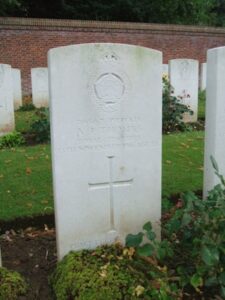
Charles Edward Thomas, Petty Officer Stoker, 1356U, Royal Naval Reserve. Charles was born on 27 April 1879, the son of Daniel H. and Sarah E. Thomas, of Milford Haven. He was the husband of Harriet Ann Thomas, of 3, Concrete Cottages, Pill, Milford Haven. He served aboard HM Trawler Helgian, and was killed when Helgian struck a mine in the Aegean and sank on 6 September 1917. Charles was 38 years old, and is commemorated on the Plymouth Naval Memorial, Devon.
Francis Howell Thomas, Private, 59858, Machine Gun Corps. Francis was the son of Elizabeth Thomas, of Pill, Milford Haven. He resided at Swansea prior to the war and enlisted there into the Welsh Regiment, before being transferred to the 14th Company, Machine Gun Corps, which was attached to the 14th (Light) Division. The Division was to see its first action during the Action of Hooge, where the Division were the first to be attacked by the German use of flamethrowers. They then fought at the Second attack on Bellewaarde. In July, 1916 they moved to the Somme, and fought at the Battle of Delville Wood, and then the Battle of Flers-Courcelette. They remained on the Somme over the winter, and it was there that Francis was killed, on 8 January 1917, aged 20. He has no known grave, and is commemorated on the Thiepval Memorial, France. Francis is not commemorated on the Milford Haven Memorial.
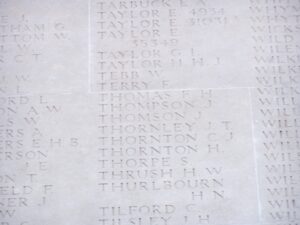
Frederick Thomas, Private, 27342, Welsh Regiment. Frederick was the son of James and Annie Thomas, of Upper Lodge, Castle Hall, Milford Haven. He enlisted at Pembroke into the Welsh Regiment, and was posted to France to join the 2nd Battalion, Welsh Regiment, attached to 3 Brigade, 1st Division. The Division had been one of the first in France, fighting at the Battle of Mons, and the retreat to the Marne, where the Germans were stopped. They then fought at the Aisne, before being moved north to Ypres. Here they fought at the First Battle of Ypres, where they again stopped the German Offensive, before wintering in Flanders. The following year saw them in action again at the Battle of Aubers, before moving South to Loos, where they fought during the Battle of Loos, and the action at the Hohenzollern redoubt. Frederick was wounded at Loos in March 1916, and sent to the Base Hospital at Rouen. He died there on 10 March 1916, aged 18, and is buried at St. Sever Cemetery, Rouen, France. Frederick is not commemorated on the Milford Haven Memorial.
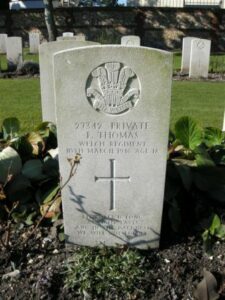
George Harding Thomas, Rifleman, King’s Royal Rifle Corps. George was the son of Charles Howard Thomas, of Marine Gardens, Milford. He enlisted into the army at the start of the war, and was posted to France on 17 November 1915 with the 16th Battalion, King’s Royal Rifle Corps, which was attached to 100 Brigade, 33rd Division. George was badly wounded after being struck by shrapnel during November, and returned to England, where he was hospitalised at Poole. After recovery he moved to Winchester Barracks, before being sent back out to France early in 1916. George was wounded again on the Somme in July 1916, and again returned home for treatment, before being discharged as medically unfit. He then worked in a munitions factory, and in the summer of 1918 married Margaret M Davies, of Aberdare, at Milford. During 1918 the young couple were both struck down with influenza, and George died. He was 26 years old, and was buried with full military honours in Milford Haven Cemetery. He is not eligible for commemoration by the CWGC.
James George Thomas, Bombardier, 371331, Royal Garrison Artillery. James was the son of John and Elizabeth Thomas, of Fair View, Priory Hill, Milford Haven. He enlisted at Milford into the Pembrokeshire Battery, Royal Garrison Artillery. James joined its 11th Siege Battery, and moved to France on 21 April 1915. James probably served through the Battles of Loos, and at the Somme in 1916, before being killed during the Battle of Arras on 24 May 1917. He has no known grave, and is commemorated on the Arras Memorial, France.
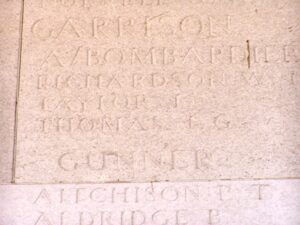
James Henry (Harry) Thomas, Lance Corporal, 17430, Royal Fusiliers. Harry was born at St. David’s, the son of Dorothy Thomas. His father died when he was young, and Dorothy married William Orchard in 1899. The family moved to 1, Priory Hill, Milford Haven, where Dorothy gave birth to several other children, and Harry was raised as William’s own son. He enlisted at Haverfordwest into the Army, and was posted to France at some time in 1916, joining the 1st Battalion, Royal Fusiliers, which was attached to 17 Brigade, 6th Division. Harry probably saw his first action on the Somme, at the Battle of Flers-Courcelette, the Battle of Morval and the Battle of Le Transloy. The following year saw the division at Arras, where it fought at the Battle of Hill 70, and then during the Battle of Cambrai later in the year. In the spring of 1918 the Division was one of those hit by the German Offensive on the Somme, which had been launched on 21 March, and the Division took part in the Battle of St Quentin. Harry was killed during the build up to the German offensive, on 8 March 1918, aged 23. He is buried at Tincourt New British Cemetery, France.
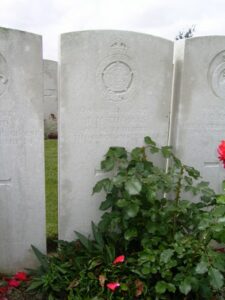
John Thomas, Second Hand, 2295SA, Royal Naval Reserve. John was born at Milford Haven on 7 June 1876, and was the husband of Minnie Thomas, of 126, Severn Grove, Canton, Cardiff. He served aboard HM Drifter Boy Harold, and was killed aboard her when she was lost with all hands after striking a German mine on 3 March 1916. John was 39 years old, and is buried at Bari War Cemetery, Italy.
William Thomas, Deck Hand, 8835DA, Royal Naval Reserve. William was born on 9 March 1891, the son of Mrs. M. Hawkins (formerly Thomas), of Hubberston, Milford Haven. He lived with his wife Laura Thomas at 9, Hall Street, Swansea prior to the war. William served aboard H.M. Trawler Benton Castle. He was killed when Benton Castle struck a mine and sank off Dartmouth on 10 November 1916. William was 26 years old and is commemorated on the Plymouth Naval Memorial, Devon. William does not seem to be commemorated at Milford.
John Thomson, Deck Hand, Royal Navy. John was the son of Mr. and Mrs. J. Thomson, of 27, High Street, Burntisland, Fifeshire. He served as Deck Hand aboard HM Drifter Ladysmith, and was drowned when she was lost in a gale off the Welsh coast on 27 December 1915. John was 39 years old, and is commemorated on the Plymouth Naval Memorial, Devon.
Douglas Ernest Thorncroft, Private, 22988, Welsh Regiment. Douglas was born at Clapham in 1892, and prior to the war worked as a carter at Milford, residing with the Codd family at The Beaconing, Steynton. He enlisted at Milford into the Welsh Regiment, and was posted to France on 26 May 1915 joining the 1st Battalion, Welsh Regiment, which was attached to 84 Brigade, 28th Division. Douglas was killed during his first major action, during the Battle of Loos on 2 October 1915. He was 23 years old and is commemorated on the Loos Memorial, France.
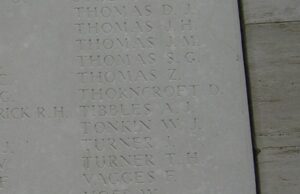
Albert Henry Tucker, Skipper, Mercantile Marine. Albert was the son of John and Eliza Jane Tucker, of Brixham, Devon, and the husband of Miriam Berry Tucker, of 43, Dewsland Street, Milford Haven. He was Skipper of the ‘Friendship’, and was drowned when she was sunk by a German submarine on 13 February 1917. Albert was 42 years old, and is commemorated on the Tower Hill Memorial, London.
Lawrence Vaughan, Air Mechanic 2nd Class, 20264, Royal Air Force. Lawrence had married Lilian Elsie Limbrick in 1912, and the couple lived at 122, Priory Road, Milford. He enlisted into the Royal Air Force, and after training as an Air Mechanic, Lawrence was posted to 79 Squadron in France, which flew the Sopwith Dolphin. Until the end of the war it carries out fighter patrols and ground attack missions with Dolphins and after the Armistice moved to Germany as part of the occupation forces, disbanding there on 15 July 1919. Lawrence died in Germany of influenza on 5 February 1919. He is buried at Cologne Southern Cemetery, Germany.
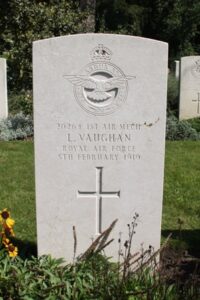
William Herbert Vincent, Deck Hand, 681DA, Royal Naval Reserve. William was born on 26 October 1895, the son of Alice Knight (formerly Vincent), of Lower Drang, Hakin, Milford Haven. He served as Deck Hand aboard HMS Prize, a ‘Q-Ship’ commanded by William Sanders, VC. William was killed when Prize was sunk in action against a German submarine in the Atlantic, on 14 August 1917. He was 21 years old, and is commemorated on the Plymouth Naval Memorial, Devon.
Henry Percival Watkins, Lance Corporal, 5948, Royal Warwickshire Regiment. Henry was the son of Benjamin Thomas and Elizabeth Louisa Watkins, of 190, Robert Street, Milford Haven. He had originally enlisted at Haverfordwest into the 4th Welsh, with the service number 354, but was posted to the 2/7th Battalion, Royal Warwickshire Regiment along with a large batch of other men of the 4th Welsh, and the new battalion was attached to 182 Brigade, 61st (2nd South Midland) Division. The Division landed in France on 21 May 1916, and moved to the Flanders sector, near the village of Fromelles, where they took over the line from the 38th (Welsh) Division. Here the battalion took part in a combined attack with the 4th Australian Division, as a diversion to the main attack on the Somme, but it was a slaughter, with thousands of lives lost needlessly. The 2/7th Warwick’s had reached their objective of the German front line trench, but immediately found that they were alone, and surrounded by Germans were annihilated. Henry was 25 years old when he was killed that day, on 19 July 1916. Like many of the other men killed during the battle he has no known grave, and is commemorated on the Loos Memorial, France.
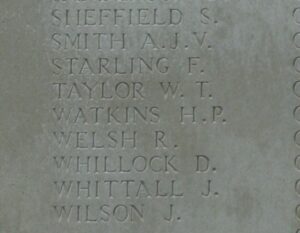
Harold Leslie Watson, Mechanician, MB/1904, Royal Naval Reserve. Harold was born on 9 January 1899, the son of John Henry and Annie Watson, of Broadmoor, Crowthorne, Berks. He served aboard HMS Prize. Harold died aboard Prize when she was sunk in action against a German Submarine in the Atlantic on 14 August 1917. He was 18 years old, and is commemorated on the Portsmouth Naval Memorial, Hampshire.
William Robert Watson, Private, 9037, Lincolnshire Regiment. William was born at Milford Haven in 1893, the son of William John and Caroline Watson. He enlisted at Grimsby in 1910 into the 3rd Battalion, Lincolnshire Regiment. When war broke out, he was posted to their 1st Battalion, which was attached to 9 Brigade, 3rd Division, and landed at Le Havre on 14 August 1914. They fought during the opening Battle of Mons, and retreat to the Marne, where the German Offensive was stopped. They followed the German withdrawal to the Aisne, where they met them in battle, and stopped the advance on Paris. The Division then moved north to Flanders, and took part in the Battle of La Bassée, and at the Battle of Messines, which were a prelude to the First Battle of Ypres. They took part in the famous Christmas Truce on 25 December 1914 and remained at Ypres throughout the winter. William married Margaret Colebrook on 4 May 1915 while home on leave, and returned to France in July 1915. Margaret stayed at their home at 55, Granville Street, Grimsby. On 14 November 1915 the 1st Lincolns transferred to 62 Brigade, 21st Division, which had been decimated at Loos. William was killed soon after, on 21 March 1916. He was 23 years old, and is buried at Cite Bonjean Military Cemetery, Armentieres, France. William is not commemorated on the Milford Haven Memorial.
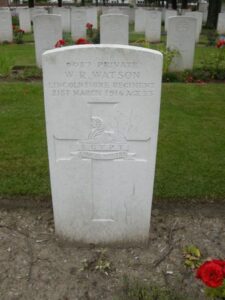
James Watt, Deck Hand, Royal Naval Reserve. James was born on 9 July 1894, the son of James and Barbara Watt, of 112, Main Street, Gardenstown, Banffshire. He was among the crew of HM Drifter Speedwell V. On Saturday 28 October 1916, Speedwell was caught in a heavy storm, and trying to reach Rosslare Pier for shelter, when she was driven ashore on Splaugh Rock, off Greenore Point, and broke up with the loss of all her crew. James was 22 years old, and is commemorated on the Portsmouth Naval Memorial, Hampshire.
Bernard Westenborg, Gunner, 20282, Royal Garrison Artillery. Bernard was the son of Bernard and Mary Westenborg, of Wellington Road, Hakin, Milford Haven. Bernard worked on the Swansea Trawlers and Fish market prior to the outbreak of war, and enlisted at Swansea into the Royal Garrison Artillery, being posted to their 17th Heavy Battery in France. Little is known of Bernard’s service, but he was killed in action on the Somme on 8 August 1916. He was 30 years old, and is commemorated on the Thiepval Memorial, France.
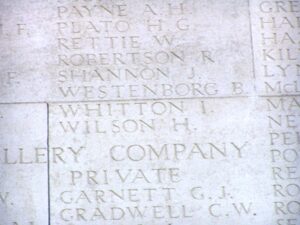
Thomas Edward White, Trimmer, TS/5619, Royal Naval Reserve. Thomas was born in London on 4 March 1890 but had worked at Milford for several years prior to the war, residing with his wife Mary Ann White, at Norton Hill, Neyland. He had served at HMS Idaho, and survived the war, sadly dying on 20 August 1919 aged 38. He is buried at Milford Haven Cemetery. Thomas does not seem to be commemorated locally.
Albert George Wiles, Trimmer Cook, 4773TS, Royal Naval Reserve. Albert was born on 24 June 1897, the son of George and Gertrude Wiles, of 4, Warwick Road, Milford Haven. He served as Trimmer Cook aboard HM Trawler Lord Airedale. Albert lost his life when Lord Airedale struck a mine and sunk off Harwich on 29 November 1916. He was 19 years old, and is commemorated on the Plymouth Naval Memorial, Devon. His brother Wilfred also fell.
Wilfred John Wiles, Private, 41796, South Wales Borderers. Wilfred was the son of George Criton Wiles and Gertrude Wiles, of 4, Warwick Road, Milford Haven, and enlisted at Carmarthen into the Training Reserve. Wilfred was posted to France, probably early in 1918, joining the 2nd Battalion, South Wales Borderers, which was attached to 87 Brigade, 29th Division. The German Spring Offensive hit the British on the Somme on 21 March 1918, and hit in Flanders just weeks later. The 29th Division fought at the desperate defensive battles of Estaires, Messines, Bailleul and Kemmel, before the war turned in favour of the Allies after a series of successes on the Somme in August. The Division then took part in the Offensive in Flanders, where they took part in the Action of Outtersteene Ridge, and then at the Battle of Ypres and the Battle of Courtrai. Wilfred was fatally wounded during the final stages of the war. He died of his wounds on 8 October 1918 aged 19 and is buried at Terlincthun British Cemetery, Wimille, France. His brother Albert also fell.
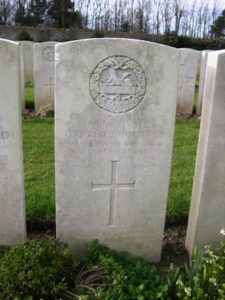
Ernest Evan Williams, Private, 372305, Royal Army Medical Corps. Ernest was the son of Evan and Mary Ann Williams, of 49, South Park Street, Pembroke Dock. He worked as a Schoolmaster at Pembroke Dock prior to the war. Ernest enlisted at Cardiff on 25 October 1915 into the Royal Army Medical Corps, and was attached to the 3rd Western General Hospital at Cardiff. By 21 May 1917 Ernest had become too ill to work, and was struck off the strength of the RAMC, his papers showing that he had caught an infection during his service. Ernest was treated in a Sanatorium for the next year, sadly dying of pulmonary tuberculosis on 23 June 1918, at Newport Hospital, Gwent. Ernest was 26 years old, and is buried at Pembroke Dock (Llanion) Cemetery. Ernest was accepted for commemoration by the CWGC on Saturday 26 April 2014 as a result of my research.
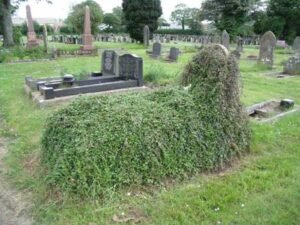
Ivor Carlyle Williams, Private, 66193, Cheshire Regiment. Ivor was born at Hubberston in 1899, the son of John and Eleanor Williams. The family later resided at 11, William’s Street, Pontardulais prior to the war, and Ivor worked in a Tinplate Works. He enlisted at Ammanford on 12 June 1915 into the 15th Battalion, Welsh Regiment, which was known as the Carmarthen Pals Battalion. He was discharged on 5 October 1915 due to being under-age. Ivor re-enlisted at Swansea in February 1917, and was posted to the 9th Battalion, Cheshire Regiment, attached to 56 Brigade, 19th (Western) Division. Ivor joined the battalion in France on 24 January 1918. In the Spring of 1918 the division was caught up in the German Spring Offensive on the Somme, and was decimated, before being moved to positions near Ploegsteert to rest and rebuild. Fatally, they were hit again, by a fresh offensive in April, and during the desperate fighting that followed in the Battle of Kemmel, Ivor was fatally wounded in the thigh and arms by gunshot. He died of his wounds, aged just 19, on 29 April 1918, and is buried at Esquelbecq Military Cemetery, France.
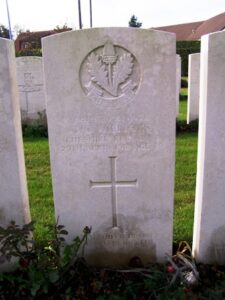
John Williams, Private, 26566, Royal Fusiliers. John was born at Abercastle, Mathry in 1892. For several years prior to the war he had resided with his Uncle and Aunt, Lori and Mary Adams, at 3, Coombs, Milford Haven. John enlisted at Milford into the Army, and was posted to the 8th Battalion, Royal Fusiliers, which were attached to 36 Brigade, 12th (Eastern) Division. The Division landed at Boulogne on 31 May 1915, and took over the line at Ploegsteert Wood. They then moved south and fought in the Battle of Loos, and the subsequent actions of the Hohenzollern Redoubt, and remained there until March 1916. By June they were in position at the Somme, and attacked Ovillers on 2 July. They fought at Pozieres and Le Transloy, which is where John was badly wounded. He was evacuated to the military hospital at Boulogne for treatment, but sadly died of his wounds there on 7 October 1916, aged 24. John is buried at Boulogne Eastern Cemetery, France.
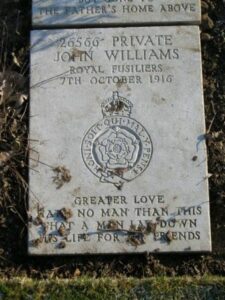
William John Williams, Trimmer, 2805TS, Royal Naval Reserve. William was born at Tenby on 26 October 1897, the son of William Williams. The family had moved to 7, Point Street, Hakin prior to the war. William enlisted at Milford into the Royal Naval Reserve on 10 April 1914 and was posted to HMS Sabrina for training. He was then posted to HMS Vivid II and after completing his training there was posted aboard HM Trawler Fulmar, which was a fishing trawler which had been requisitioned by the Admiralty and converted into a minesweeper. On 17 January 1916 Fulmar was on patrol in the Gulf of Sollum when she struck a mine, and sank with the loss of fifteen lives. William was just 18 years old when he was killed during the loss of Fulmar that day. He has no known grave and is commemorated on the Tower Hill Memorial, London.
Alexander Williamson, Deck Hand, 4819DA, Royal Naval Reserve. Alexander was born on 26 April 1896, the son of Alexander and Susan Williamson, of 154, Harmony Row, Govan, Glasgow. He served as Deck Hand aboard HMS Prize, and was killed when Prize was sunk in combat with a German submarine in the Atlantic on 14 August 1917. He was 21 years old, and is commemorated on the Portsmouth Naval Memorial, Hampshire.
Alfred Wilson, Stoker 1st Class, SS/114282, Royal Navy. Alfred was born on 4 September 1893, the son of William and Mary Ann Wilson, of 8, Cadiz Street, Stepney, London. He served with the Royal Navy aboard the Q-Ship HMS P60. Alfred was one of at least five men who were killed aboard P60 on 4 January 1918. Alfred was 24 years old, and is buried in Woodgrange Park Cemetery, East Ham. This man is shown on the memorial as C. Wilson, but there is no-one to match this name, and P60 had been based in Milford.
Gilbert John Wilson, Deck Hand, 15235DA, Royal Naval Reserve. Gilbert was born on 24 December 1891, the son of Gilbert John Wilson, of Brixham, Devon. He had worked at Milford for several years prior to the war, and resided with his wife Gertrude Wilson, at 15, Albion Street, Milford Haven. He was another of the crew of HMS Prize, and died when she was sunk in action against German submarine U-48 in the Atlantic on 14 August 1917. Gilbert was 25 years old, and is commemorated on the Plymouth Naval Memorial, Devon.
William James Winchester, Skipper, Royal Naval Reserve. William was the husband of Elizabeth Winchester, of 43A, Penny Lane, Wavertree, Liverpool. He was Skipper aboard HM Trawler, Evangel, and died at sea whilst Evangel was based at Milford on 25 March 1917, aged 39. William is buried at Liverpool (Toxteth Park) Cemetery.
John Wiseman, Deck Hand, TS/3159, Royal Naval Reserve. James was born on 26 April 1878, the son of John and Mary Wiseman, of I, Donald Place, Forbes Street, Aberdeen. He served as Deck Hand aboard HM Drifter Progress, which was a patrol boat. John was found drowned at Milford on 24 July 1915, wedged between a boat and the harbour wall. He was 41 years old, and is buried at Milford Haven Cemetery.
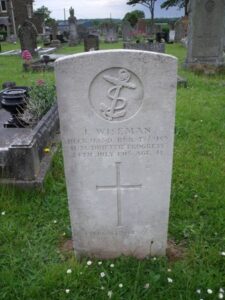
William Wiseman, Trimmer Cook, 313TC, Royal Naval Reserve. William was born on 16 November 1898, the son of James Watt Wiseman and Elizabeth Wiseman, of 110, Main Street, Gardenstown, Banff. He served as Trimmer Cook aboard HM Drifter Speedwell V. On Saturday 28 October 1916, Speedwell was caught in a heavy storm, and trying to reach Rosslare Pier for shelter, when she was driven ashore on Splaugh Rock, off Greenore Point, and broke up with the loss of all her crew. William was 18 years old, and is commemorated on the Portsmouth Naval Memorial, Hampshire.
David Joseph Wood, Private, 267198, Royal Warwickshire Regiment. David was born in 1893, the son of Richard and Sarah Ann Wood, of 29, Newgate Street, Llanfaes, Brecon. He worked as a miner prior to enlisting at Wrexham in March 1914 into the 3rd Battalion, South Wales Borderers. David was discharged at Pembroke on 23 October 1914 as being medically unfit. He married Ellen Thomas early in 1915, and the couple resided at Fern Cottage, Johnston. David re-enlisted at Milford into the Welsh Regiment, and was one of several local men posted to the 2/7th Battalion, Royal Warwickshire Regiment, part of 182 Brigade, 61st (2nd South Midland) Division. The Division had been in France since 21 May 1916, moving to positions at Fromelles, where it was virtually decimated. Such was the damage to the Division that it was not used again other than for holding trench lines until 1917, when it followed the German withdrawal to the Hindenburg Line, capturing Chaulnes and Bapaume. Later that year it fought at Battle of Langemarck, as part of the Third Battle of Ypres, and in late August and early September it was involved in the efforts to push the line forward at positions around Schuler Farm and Aisne Farm near Kerselaar. The Division then moved south, where it was to take part in the Battle of Cambrai. 61st Division was initially held in reserve and was still in the area when the enemy made a determined counterattack on 30 November. The Division was ordered up to reinforce the units under attack in the area of La Vacquerie and for some days was involved in a hard fight to stem the enemy attack. During March, 1918 the Division was holding the forward zone of defences in the sector northwest of Saint Quentin, in the area of Ham and lost many men as it fought a chaotic but ultimately successful withdrawal back over the Somme crossings over the next ten days. David was one of many men lost in the first days of this terrible fighting. He was killed in action on 22 March 1918, aged 25, and is commemorated on the Pozières Memorial, France.
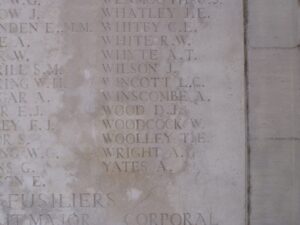
John Wood, Skipper, Royal Naval Reserve. John was the husband of Helen Donaldson Wood, of 21, Reidhaven Street, Portknockie, Banffshire. He served as Skipper of HM Drifter Ladysmith, and was drowned when she was lost during a gale on 27 December 1915. John was 51 years old, and is commemorated on the Portsmouth Naval Memorial, Hampshire. His brother William was also aboard.
William George Wood, Second Hand, 1898SA, Royal Naval Reserve. William was born on 3 December 1866, the son of John and Jessie Wood, of Portknockie, and the husband of Beatrice Wood (nee Mair), of 16, Park Street, Portknockie, Banffshire. He served as Second Hand aboard HM Drifter Ladysmith, and was drowned when she was lost during a gale on 27 December 1915. William was 49 years old, and is commemorated on the Portsmouth Naval Memorial, Hampshire. His brother John was also aboard.
Richard Yabsley, Private, 7133, Irish Guards. Richard was born at Hendon in 1888, and had been a regular soldier with the Irish Guards. He had completed his service at some time between 1911 and 1914 and was working as a fish checker for the Great Western Railway at Milford when war erupted. Richard rejoined the 2nd Battalion, Irish Guards in France on 17 August 1915, where it was attached to the 2nd Guards Brigade, Guards Division. He was killed in action during the Battle of Loos on 27 September 1915 aged 27, and is commemorated on the Loos Memorial, France. Richard is not commemorated locally.
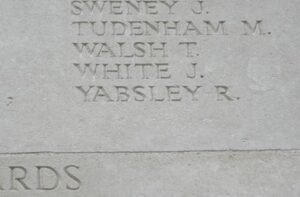
William Young, Engineman, 2031ES, Royal Naval Reserve. William was born on 28 November 1875, the son of Alexander and Isabella Young, of 112, Main Street, Gardenstown, Banff. He was another of the crew of Speedwell V, serving as Engineman. On Saturday 28 October 1916, Speedwell was caught in a heavy storm, and trying to reach Rosslare Pier for shelter, when she was driven ashore on Splaugh Rock, off Greenore Point, and broke up with the loss of all her crew. William was 40 years old and is buried at Kilscoran Church of Ireland Churchyard, Ireland.